‘A fighting man, through and through, but wary and wily as brave.’
The charmed and cursed life of the war’s most famous boy general Federal Cavalry Comes of Age Battle Scars of Philippi, W.Va. Civilians Make Their Mark Plus!

Custer!
HISTORYNET.COM SUMMER 2023 ACWP-230700-COVER-DIGITAL.indd 1 3/13/23 2:19 PM
–Col. James H. Kidd
Personalized 6-in-1 Pen



Convenient “micro-mini toolbox” contains ruler, pen, level, stylus, plus flat and Phillips screwdrivers. Giftable box included. Aluminum; 6"L. 817970 $29.99
Mats


Grease Monkey or Toolman, your guy (or gal) will love this practical way to identify personal space. 23x57"W.











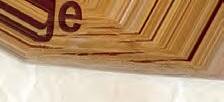

Tools 808724






























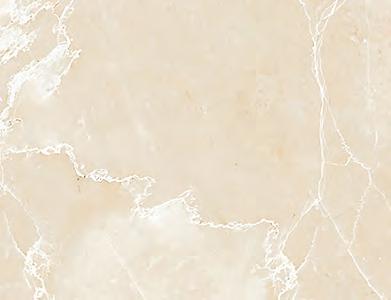


















Tires 816756 $45.99 each

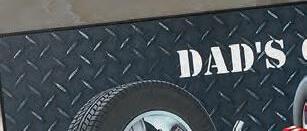











Personalized Super Sturdy Hammer Hammers have a way of walking o . Here’s one they can call their own. Hickory-wood handle. 16 oz., 13"L. 816350 $21.99






Personalized Extendable Flashlight Tool

Light tight dark spaces; pick up metal objects. Magnetic 6¾" LED flashlight extends to 22"L; bends to direct light. With 4 LR44 batteries. 817098 $32.99

OFFER
Personalized Garage
ACWP-230418-006 Lillian Vernon .indd 1 3/14/23 4:55 PM
RUGGED ACCESSORIES FOR THE NEVER-ENOUGH-GADGETS GUY. JUST INITIAL HERE.


Our durable Lillian Vernon products are built to last. Each is crafted using the best materials and manufacturing methods. Best of all, we’ll personalize them with your good name or monogram. Ordering is easy. Shipping is free.* Go to LillianVernon.com or call 1-800-545-5426.







Personalized Grooming Kit


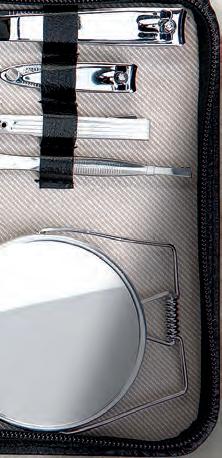
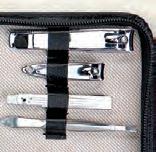
Indispensable zippered manmade-leather case contains comb, nail tools, mirror, lint brush, shaver, toothbrush, bottle opener. Lined; 5½x7".





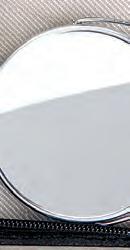
817548 $29.99



Personalized Beer Caddy Cooler Tote Soft-sided, waxed-cotton canvas cooler tote with removable divider includes an integrated opener, adjustable shoulder strap, and secures 6 bottles. 9x5½x6¾". 817006 $64.99
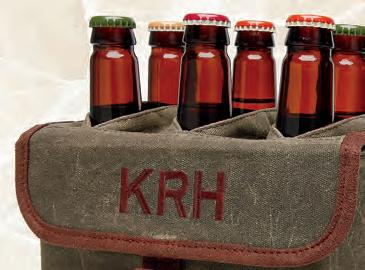
Personalized Bottle Opener Handsome tool helps top o a long day with a cool brew. 1½x7"W. Brewery 817820 Initial Family Name 817822 $11.99 each



Personalized 13-in-1 Multi-Function Tool

All the essential tools he needs to tackle any job. Includes bottle opener, flathead screwdriver, Phillips screwdriver, key ring, scissors, LED light, corkscrew, saw, knife, can opener, nail file, nail cleaner and needle. Includes LR621 batteries. Stainless steel.

818456 $29.99

*FREE SHIPPING ON ORDERS OVER $50. USE PROMO CODE: HISACWM3 LILLIANVERNON.COM/ACW The Personalization Experts Since 1951 OFFER EXPIRES 7/31/23. ONLY ONE PROMO CODE PER ORDER. OFFERS CANNOT BE COMBINED. OFFER APPLIES TO STANDARD SHIPPING ONLY. ALL ORDERS ARE ASSESSED A CARE & PACKAGING FEE.
ACWP-230418-006 Lillian Vernon RHP.indd 1 3/14/23 4:59 PM
22 Summer of Discontent
George Armstrong Custer knew mostly glory in the war. That wouldn’t be the case during his late-war excursion to Louisiana.
 By Richard H. Holloway
By Richard H. Holloway
2 AMERICA’S CIVIL WAR CLOCKWISE FROM LEFT: LIBRARY OF CONGRESS; NIDAY PICTURE LIBRARY, LEBRECHT MUSIC & ARTS/ALAMY STOCK PHOTO (2); COVER: LIBRARY OF CONGRESS, PHOTO ILLUSTRATION BY BRIAN WALKER
Summer 2023
ACWP-230700-CONTENTS.indd 2 3/15/23 8:55 AM
The Reckoning at Yellow Tavern


 By Adolfo Ovies
By Adolfo Ovies
Home
SUMMER 2023 3
6 LETTERS In Ben Butler’s own words 8 G RAPESHOT! Britain’s Civil War heroes remembered; history at Ball’s Bluff 12 REGIMENTAL PRIDE The 76th USCI quickly proved it belonged 1 6 LIFE & LIMB More than mere accessories for the wounded 18 FROM THE CROSSROADS At Gettysburg, Pleasonton and Custer help level the field 20 SOUTHERN ACCENT Defiant Union colonel tests Kentucky’s legal system 52 TRAI LSIDE Philippi, W.Va.: Union victory brings hope—and George McClellan 56 5 QUESTIONS Ulysses Grant, from the beginning 58 R EVIEWS Liquor’s intractable reach; Sherman’s reality check 64 FI NAL BIVOUAC Unceremonious end for a distinguished veteran ON THE COVER: DESPITE HIS FLAMBOYANCE—A STAFF MEMBER DESCRIBED HIM AS “ONE OF THE FUNNIEST LOOKING BEINGS YOU EVER SAW...LOOKS LIKE A CIRCUS RIDER GONE MAD!”—GEORGE ARMSTRONG CUSTER WAS NEVERTHELESS ALL BUSINESS WHEN IT CAME TO TORMENTING HIS CONFEDERATE FOES.
Departments
Front Heroes—Part 2
look at the unforgettable wartime contributions of citizens of
stripes 32 42
Second
all
Custer rises to the occasion, J.E.B. Stuart falls in cavalry showdown outside Richmond
ACWP-230700-CONTENTS.indd 3 3/15/23 9:00 AM
Michael A. Reinstein Chairman & Publisher
Sherman Finds Personal Growth
An interview with historian Eric Burke, whose new book explores the gritty fighting culture of William Sherman’s troops in the Western Theater. historynet.com/eric-burke-interviewshermans-legacy

Weapons
Gear
The
Chris K. Howland Editor
Jerry Morelock Senior Editor
Brian Walker Group Design Director
Melissa A. Winn Director of Photography
Austin Stahl Associate Design Director
Alex Griffith Photo Editor
Dana B. Shoaf Editor in Chief
Claire Barrett News and Social Editor
ADVISORY BOARD
Gordon Berg, Jim Burgess, Steve Davis, Richard H. Holloway, D. Scott Hartwig, Larry Hewitt, John Hoptak, Robert K. Krick, Adolfo Ovies, Ethan S. Rafuse, Ron Soodalter
C ORPORATE
Kelly Facer SVP Revenue Operations
Matt Gross VP Digital Initiatives
Rob Wilkins Director of Partnership Marketing
Jamie Elliott Senior Director, Production
ADVERTISING
Morton Greenberg SVP Advertising Sales mgreenberg@mco.com
Terry Jenkins Regional Sales Manager tjenkins@historynet.com

DIRECT RESPONSE ADVERTISING MEDIA PEOPLE
Nancy Forman nforman@mediapeople.com


©2023 HISTORYNET, LLC
Subscription Information: 800-435-0715 or shop.historynet.com
List Rental Inquiries: Belkys Reyes, Lake Group Media, Inc., 914-925-2406; belkys.reyes@lakegroupmedia.com
America’s Civil War (ISSN 1046-2899) is published quarterly by HISTORYNET, LLC, 901 North Glebe Road, Fifth Floor, Arlington, VA 22203
Periodical postage paid at Vienna, VA, and additional mailing offices. Postmaster, send address changes to America’s Civil War, P.O. Box 900, Lincolnshire, IL 60069-0900
Canada Publications Mail Agreement No. 41342519 Canadian GST No. 821371408RT0001


The contents of this magazine may not be reproduced in whole or in part without the written consent of HISTORYNET, LLC.
PROUDLY MADE IN THE USA
Vol. 36, No. 2 Summer 2023
4 AMERICA’S CIVIL WAR CLASSIC IMAGE/ALAMY STOCK Sign up for our FREE e-newsletter, delivered twice weekly, at historynet.com/newsletters HISTORYNET VISIT HISTORYNET.COM PLUS! Today in History
yesterday— or any day you care to search. Daily Quiz
your historical acumen—every
What If?
the fallout of historical
they gone the ‘other’ way.
What happened today,
Test
day!
Consider
events had
&
gadgetry of war—new and old— effective, and not-so effective.
TRENDING NOW ACWP-230700-MASTHEAD.indd 4 3/14/23 8:59 AM
History, Competition and Camaraderie
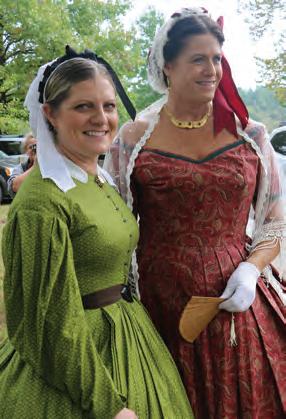
The N-SSA is America’s oldest and largest Civil War shooting sports organization. Competitors shoot original or approved reproduction muskets, carbines and revolvers at breakable targets in a timed match. The teams with the lowest cumulative times win medals or other awards. Some units even compete with cannons and mortars. Each team represents a specific Civil War regiment or unit and wears the uniform they wore over 150 years ago.
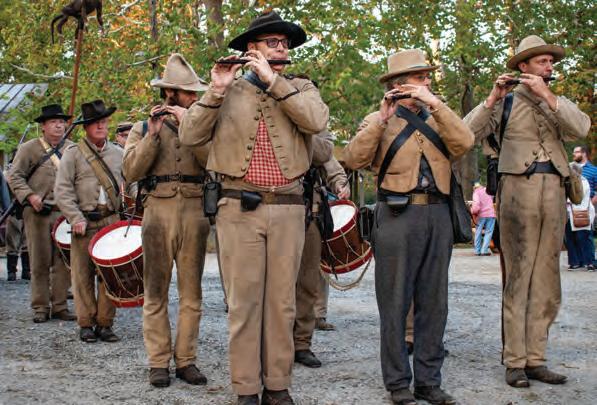
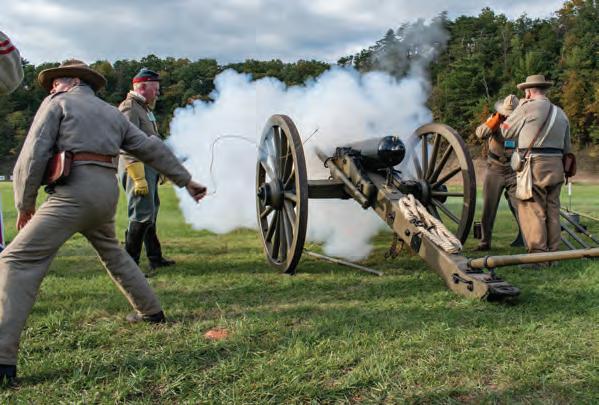
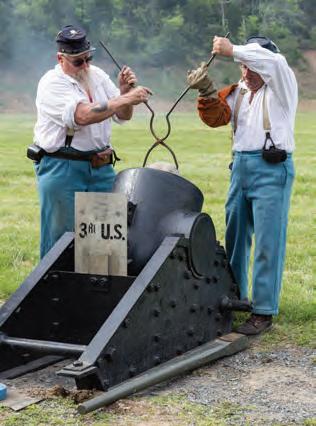
Competitions, called “skirmishes”, are held throughout the year in the association’s 13 regions. Members come from all over the country each spring and fall to national competitions held at the association’s home range, Fort Shenandoah, located just north of Winchester, Virginia. Skirmishing is an inclusive family sport with participation by men, women and young adults. There are even BB gun matches for the youngsters. There are also competitions for authenticity of Civil War period dress, both military and civilian in multiple categories.
Dedicated to preserving our history, period firearms competition and the camaraderie of team sports with friends and family, the N-SSA may be just right for you. If you’re a Civil War enthusiast or black powder shooter ready for our unique experience or are just in search of more information, visit our web site: www.n-ssa.org.

ACWP-230418-004 North South Skirmish PAGE.indd 1 3/13/23 2:58 PM
Historic LetTER

Regarding the article “Opportunity Knocks” about the 1864 Bermuda Hundred Campaign in your Winter 2023 issue, I thought you might find this rare battlefield order—written by Union commander Maj. Gen. Benjamin Butler to his future son-in-law, Brig. Gen. Adelbert Ames—of interest. On May 13, 1864, Butler expressed hope that Ames could hold on alone against Maj. Gen. William H.C. Whiting on the left while troops commanded by Maj. Gen. Quincy Gillmore swung wide right to get at P.G.T. Beauregard’s main line.
It would be hard to find a more awkward team of commanders than Butler, Gillmore, Maj. Gen. William F. “Baldy” Smith, and Brig. Gen. August V. Kautz. They were never going to work well together and, down deep, Ulysses S. Grant knew that. But it did keep those four out of Grant’s hair for a period, and it did tie up Confederate troops that could have helped Robert E. Lee’s army closer to Richmond in the buildup to Cold Harbor.
As a Ben Butler collector, I do have a soft spot for his entire career.
Joe Normandy Catharpin, Va.
The Remarkable Dodge
I would like to commend America’s Civil War for the fine article by Judith Wilmot on Iowa Maj. Gen. Grenville Dodge (Winter 2023, P. 20). “The Unshakable Gen. Dodge,” was well-written and extremely informative. Dodge, who was from Council Bluffs, is an Iowa hero who too often has been overlooked by Civil War scholars. His service as a fighting general, a master of building and wrecking railroads, and a spymaster to Grant, Sherman, and Curtis was invaluable to the success of Union arms.
Judith’s article is filled with wonder-
ful detail and brings well-earned attention to this remarkable man.
Kenneth L. Lyftogt Cedar Falls, Iowa
Moving Article
I just got through reading Jonathan Noyalas’ Unfinished Business article in the Spring 2023 issue (P. 38). I appreciated him incorporating so many firsthand accounts into the article. Some of the soldiers’ quotes used, especially those of Generals George Custer and Frank Wheaton, were very moving. I look forward to reading future articles by Jonathan in the magazine.
Brian Mattingly Leonardtown, Md.
Editor’s Note: In our Spring 2023 issue, our Trailside column (PP. 54-56) explored Parker’s Crossroads, Tenn., site of a December 31, 1862, battle featuring Nathan Bedford Forrest’s cavalry. After we had gone to press, the
‘Can You Hold Your Own...’
Ben Butler’s May 13, 1864, order to a subordinate, Adelbert Ames, survived the war. In 1870, Ames married Butler’s daughter, Blanche.
American Battlefield Trust announced it had completed acquisition of nearly one acre of land at the battlefield, and had helped restore it before transferring the rights to the state of Tennessee. The land saved in what had been a twoyear joint effort by the ABT and other preservation organizations is the southwest quadrant of the namesake site’s original intersection. More than 370 core acres have now been preserved at Parker’s Crossroads.
6 AMERICA’S CIVIL WAR LETTERS
COURTESY JOE NORMANDY WRITE TO US E-mail: acwletters@historynet.com Letters may be edited. @AmericasCivilWar @ACWmag ACWP-230700-LETTERS.indd 6 3/14/23 8:58 AM
TODAY IN HISTORY
JANUARY 30, 1835
ANDREW JACKSON SURVIVED AN ASSASSINATION ATEMPT WHILE ATTENDING A FUNERAL AT THE U.S. CAPITOL. UNEMPLOYED HOUSE PAINTER RICHARD LAWRENCE TWICE TOOK AIM AT JACKSON, MISFIRING BOTH TIMES. IN RESPONSE JACKSON THRASHED HIM WITH HIS CANE. THE CROWD, WHICH INCLUDED U.S. REPRESENTATIVE DAVID CROCKETT, SUBDUED LAWRENCE.
For more, visit HISTORYNET.COM/TODAY-IN-HISTORY
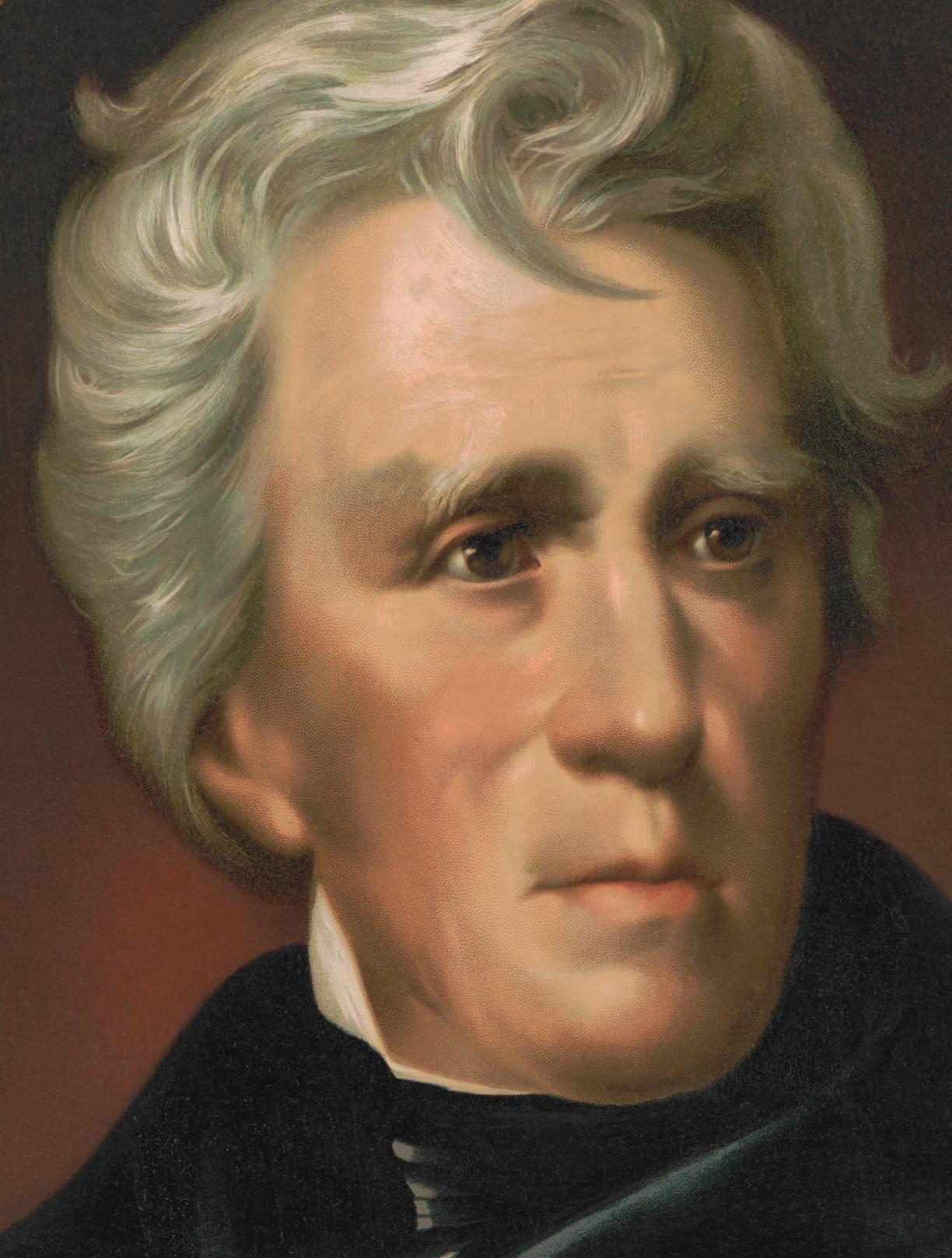
TODAY-JACKSON.indd 22 8/25/22 6:04 PM
Our Cause, Too
Brits in Blue and Gray

OVERDUE RECOGNITION FOR MANY ACROSS THE POND WHO SERVED
Learning there are more than 520 Civil War veter ans interred in mostly unmarked graves in the United Kingdom, the Monuments for UK Veterans of the American Civil War Association formed in Essex, England, in January 2022. Gina Denham, who co-founded the association with Darren Raw lings, discovered that her great-great-grandfather, George Denham, had served during the war on the Union ironclad Chickasaw and later in the 111th Pennsylvania Infantry before returning to his homeland. With aid from the U.S. government, Gina secured a headstone for her ancestor’s previously unmarked gravesite.
Through their research efforts, Denham and Rawlings were able to confirm the identify of another somewhat forgotten British Civil War veteran once in terred in an unmarked grave in his homeland: Maurice Wagg, a Medal of Honor recipient from Christchurch in southern England. Born July 23, 1840, Wagg was coxswain on USS Rhode Island, involved in the rescue of crewmembers on the famed USS Monitor as it foundered off the North Carolina coast on December 31, 1862.

Credited with saving the lives of four of Moni’s officers and 12 crewmen, Wagg would be promoted to the rank of acting master’s mate. He and six other Rhode Island sailors were the first individuals to receive the Medal of Honor for a non-combat action.
Wagg returned to England after the war and helped form the London Branch of American Civil War Veterans, attending its inaugural meeting on September 20, 1910. On June 22, 1926, Wagg died at his home in Poplar, East London. With the help of author/researcher Michael Hammerson, an official headstone for his grave was obtained in 2015. (Hammerson has helped uncover the identity of a number of other Civil War veterans and their final resting places.)
In its first year of operation, the association raised $3,500 for construction of a monument that will recognize the contributions of these Civil War vets from the United Kingdom—many, like Wagg and Denham, all but forgotten to history. To help, visit www.justgiving.com/crowdfunding/ themonumentalproject
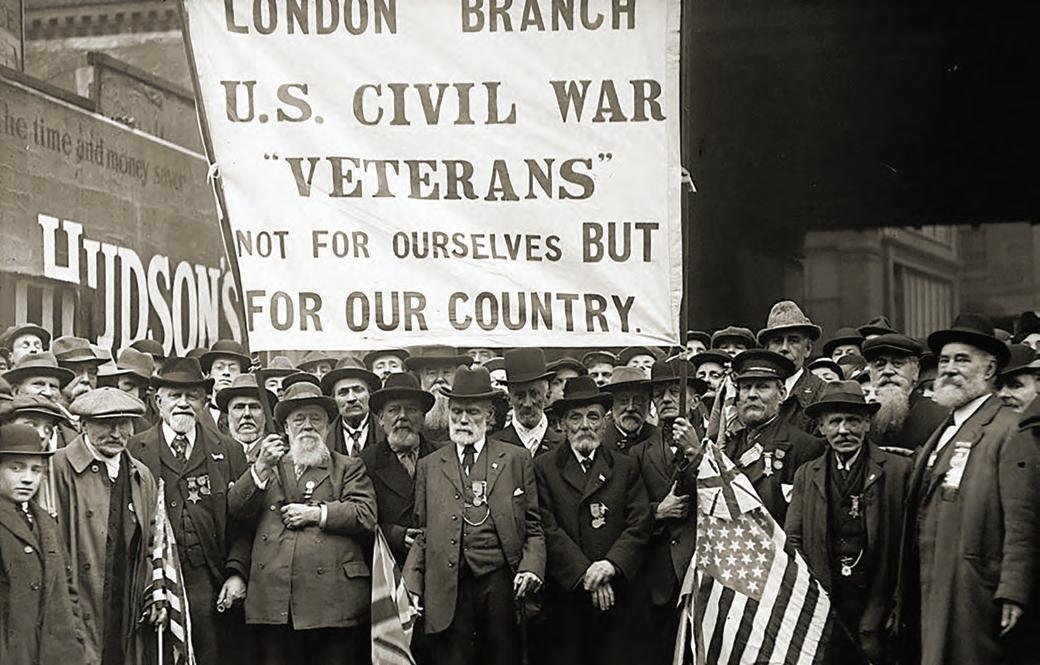
8 AMERICA’S CIVIL WAR A Blast of Civil War Stories GRAPESHOT! COURTESY RICHARD H. HOLLOWAY; RIGHT: LIBRARY OF CONGRESS COURTESY GINA DENHAM
ACWP-230700-GRAPESHOT.indd 8 3/14/23 4:33 PM
Maurice Wagg (circled) and fellow countrymen who filled the ranks on land or sea in the seminal U.S. struggle pose outside London’s Ragged School Mission Hall. Wagg proudly dons his Medal of Honor (another sample of one shown below).
CIVIL WAR ILLUSTRATED
Penned in 1855, William J. Hardee’s “Hardee’s Rifle and Light Infantry Tactics” was used by both sides during the Civil War. Hardee, a Georgian by birth, controversially decided to fight for the Confederacy. That particularly angered one Northern artist, who lambasted the former U.S. Army officer’s renowned manual, portraying it in a cartoon as antiquated and useless in “modern” warfare. The exaggerated illustration appeared in a newspaper early in the war. “Old Reliable” likely wasn’t too bothered being mocked.
Preservation News
Five critical Western Theater battlefield sites in four states—Shiloh in Tennessee; Chickamauga in Georgia; Brice’s Cross Roads in Mississippi; and Bentonville and Wyse Fork in North Carolina—are the focus of a new American Battlefield Trust preservation effort. At stake are an endangered 343 acres, including 159 at Bentonville, 95 at Brice’s Cross Roads, and 86 at Wyse Fork. ¶ With help from organizations such as the Shenandoah Valley Battlefields Foundation and the American Battlefield Protection Program, the ABT has had recent victories in Virginia with the Gaines Mill–Cold Harbor Saved Forever Campaign and preservation of 47 acres at Cedar Creek and Cedar Mountain. Go to battlefields.org for more info.
QUIZ
Before Custer Went West
Match the future Civil War general with his prewar hostilities.
A. Albert Sidney Johnston
B. John Bell Hood
C. George Pickett
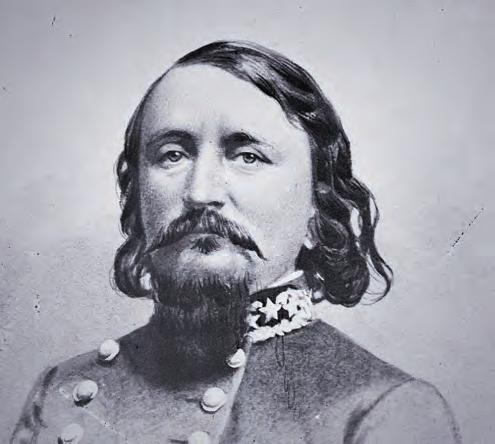
D. Nathaniel Lyon

E. J.E.B. Stuart
F. John C. Frémont
G. Robert E. Lee
H. Samuel B. Heintzelman
I. Henry Heth
J. Philip H. Sheridan
1. Wounded fighting Cheyenne Indians, Solomon River, Kansas, 1857
2. Confronted British at San Juan Island, 1859
3. Massacred Brulé Lakota at Ash Hollow, Neb., 1855
4. Wounded fighting Cascade Indians, 1856
5. Fought Yuma Indians along Gila River, Calif. and Ariz., 1852
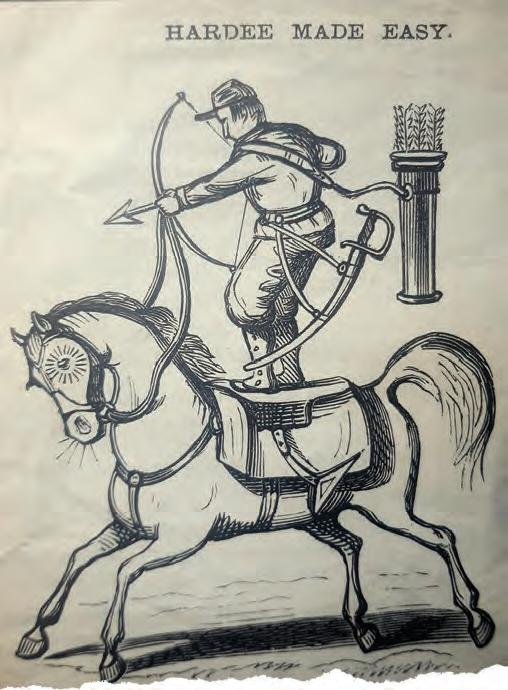
6. Led expedition against Mormons in Utah, 1857
7. Wounded fighting Comanche Indians, Devil’s River, Texas, 1857
8. Massacred up to 500 Wintu in Sacramento Valley, 1846
9. Wounded at Chapultepec, Mexico, 1847
10. Massacred Pomo Indians at Bloody Island, Calif., 1850
Answers: A.6, B.7, C.2, D.10, E.1, F.8, G.9, H.5, I.3, J.4.
SUMMER
COURTESY RICHARD H. HOLLOWAY; RIGHT: LIBRARY OF CONGRESS COURTESY GINA DENHAM
George Pickett
2023 9
ACWP-230700-GRAPESHOT.indd 9 3/14/23 4:33 PM
CONVERSATION PIECE
Fine China
While assigned to Louisiana in the summer of 1865 (see “Summer of Discontent,” P. 22), George and Libbie Custer visited the New Orleans studio of photographer and portrait artist R.T. Lux. Custer commissioned Lux to craft the porcelain vases shown here. Lux used tintype photos he had taken of the couple to hand-paint their images on the vases, each 11 inches tall and dated July 1865. When first sold at auction by Butterfield & Butterfield in 1995, the Libbie vase had been damaged—a number of broken pieces glued back together “with no attempt to cover the break lines.” That would be rectified prior to a subsequent auction in 2010, where the collectibles fetched $53,999.99.

BATTLE RATTLE
From Custer to Lincoln

Bruce K. Lawes is most noted for his wildlife artwork, but his astonishing Civil War paintings also can be found on his website, bklawesart.com—tributes to his late brother, who first took him to Gettysburg. (His painting “Brothers in Arms” was the official poster of the battle’s 150th anniversary.) Adolfo Ovies, who wrote our Battle of Yellow Tavern article on P.32, has long admired Lawes’ painting of Custer at East Cavalry Field, “Before the Storm,” and Lawes’ art graces the covers of Ovies’ The Boy Generals trilogy on Custer, Wesley Merritt, and the Army of the Potomac cavalry. Above is a recent Lawes work, “A New Birth of Freedom,” portraying a meditative Lincoln crafting his Gettysburg Address.

10 AMERICA’S CIVIL WAR GRAPESHOT! FROM TOP: ERIC LEE/WASHINGTON POST/GETTY IMAGES; THE HORSE SOLDIER; RICHARD H. HOLLOWAY COLLECTION CLOCKWISE FROM TOP LEFT: HERITAGE AUCTIONS, DALLAS, TEXAS; BRUCE K. LAWES; BENTLEY HISTORICAL LIBRARY, UNIVERSITY OF MICHIGAN
“Custer was a fighting man, through and through, but wary and wily as brave. There was in him an indescribable something— call it caution, call it sagacity, call it real military instinct—it may have been genius— by whatever name entitled, it nearly always impelled him to do intuitively the right thing.”
—James H. Kidd, 6th Michigan Cavalry
ACWP-230700-GRAPESHOT.indd 10 3/14/23 4:34 PM
A Singular Honor
Lewis A. Bell probably didn’t have much time to contemplate what he was doing. It was October 21, 1861, and Bell found himself in the midst of the frantic Union retreat toward the Potomac River late in the Battle of Ball’s Bluff. As a Black man, he was not authorized at this stage of the war to fire a gun in combat. Merely a camp worker, he had crossed the river alongside members of the 15th Massachusetts Infantry in what had initially been a scouting mission. Now, with Confederate soldiers swarming in his direction, he picked up a gun and began firing.
Bell’s feat that day has long been overshadowed in histories of the war. It is believed, however, that he was the Civil War’s first Black combatant, and in February a wayside marker was unveiled in his honor during a ceremony at the 76-acre battlefield park just north of Leesburg, Va.
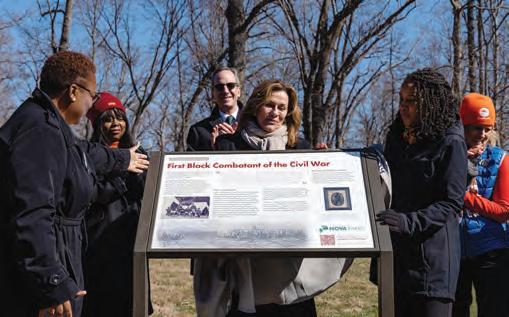
“On this territory he’s considered chattel,” Cate Magennis Wyatt, NOVA Parks chair, told ceremony attendees. “He’s got a choice to make. There are rifles, which if he picks up, he could be imprisoned in the North….And if he’s caught and tries to run, he could be lynched.”
Making History
Bell and other members of the 15th Massachusetts would eventually be captured and imprisoned in Richmond before being exchanged in February 1862. Little is known about him from that point on, and it is uncertain whether he joined the Union Army after the Emancipation Proclamation or even survived the war. His singular achievement at Ball’s Bluff is, at least, finally getting some acclaim.
By October, Roden had been elevated to command of Company B. His unit would serve in all three theaters during the war. During the Chancellorsville Campaign, Roden again received accolades from his commander when he attacked and burned 18 Confederate wagons. Sickness, however, would follow Roden, finally forcing him to resign from service on April 21, 1864. His sword and iron scabbard survive, a testament to the dependability of what was known as an “Old Wristbreaker.” Designed to slash the enemy, the heavy flatbacked blade was originally created to replace the ineffective Model 1833 Dragoon Saber.
The 12th Illinois Cavalry mustered into the Union Army in Springfield, Ill., on February 24, 1862. A 29-year-old German immigrant, now going by the Anglicized name Charles Roden, was elected first lieutenant of Company D. After signing up, each man was issued a U.S. Model 1840 cavalry saber; Roden had his engraved lieut. c. roden.

In an official report on September 9, 1862, Roden received credit from the regiment’s commander, Colonel Arno Voss, for his role in a pre-Antietam engagement at Martinsburg, Va. Wrote Voss: “On the morning of the 4th instant, Lieut. Charles Roden....having ten men with him behaved very gallantly.”
Recently sold to an anonymous private collector by The Horse Soldier in Gettysburg, Roden’s sword showed heavy usage during the war. Drawn, the sword is 40 inches in length. The curved blade measures about 34½ inches. The engraved grip is a rounded wooden piece covered in leather and affixed to the handle with brass wire. The scabbard and blade all have a light patina from age.
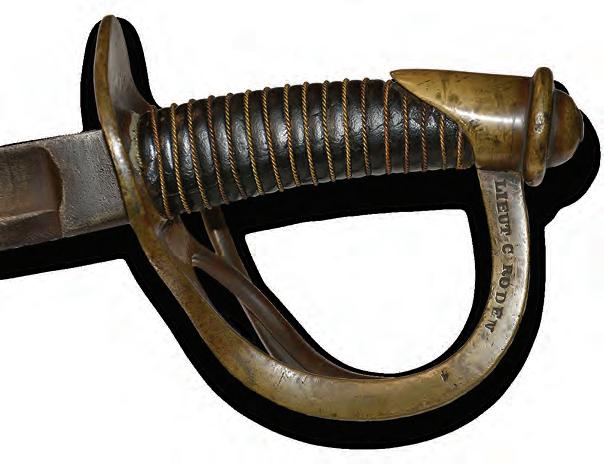 Albert R. LaBure
Albert R. LaBure

SUMMER 2023 11 FROM TOP: ERIC LEE/WASHINGTON POST/GETTY IMAGES; THE HORSE SOLDIER; RICHARD H. HOLLOWAY COLLECTION CLOCKWISE FROM TOP LEFT: HERITAGE AUCTIONS, DALLAS, TEXAS; BRUCE K. LAWES; BENTLEY HISTORICAL LIBRARY, UNIVERSITY OF MICHIGAN
‘Wristbreaker’
GRAPESHOT!
ACWP-230700-GRAPESHOT.indd 11 3/14/23 4:34 PM
NOVA Parks Chair Cate Magennis Wyatt (center) and other attendees at the Bell marker’s unveiling ceremony.
‘All Brave Men Could Do’
BY THE END OF THE WAR, THE 76TH USCI LEFT NO DOUBT IT BELONGED
By Edward Windsor
IN LATE 1862, Horace Washington and Olmsted Massy, former slaves from Virginia, met with a recruiting officer in New Orleans to join the 4th Louisiana Native Guards. The 4th was one of four infantry regiments formed as part of the Louisiana Militia in 1861 to protect New Orleans from Yankee invaders, its initial members free men of color pulled from the Crescent City itself. New Orleans’ capitulation to U.S. Navy Flag Officer David G. Farragut in April 1862, however, did not end the war for the free black soldiers of the 4th Native Guards or the other three regiments, who readily agreed to join the Union Army. After Maj. Gen. Benjamin Butler assimilated the regiments into his military chain of command, recruitment was opened to former slaves, hence Washington’s and Massy’s desire to serve. The two men were mustered in as corporals. At first, Butler used the Native Guard only to conduct guard duty in the vicinity. Eventually they were assigned to protect government facilities in Baton
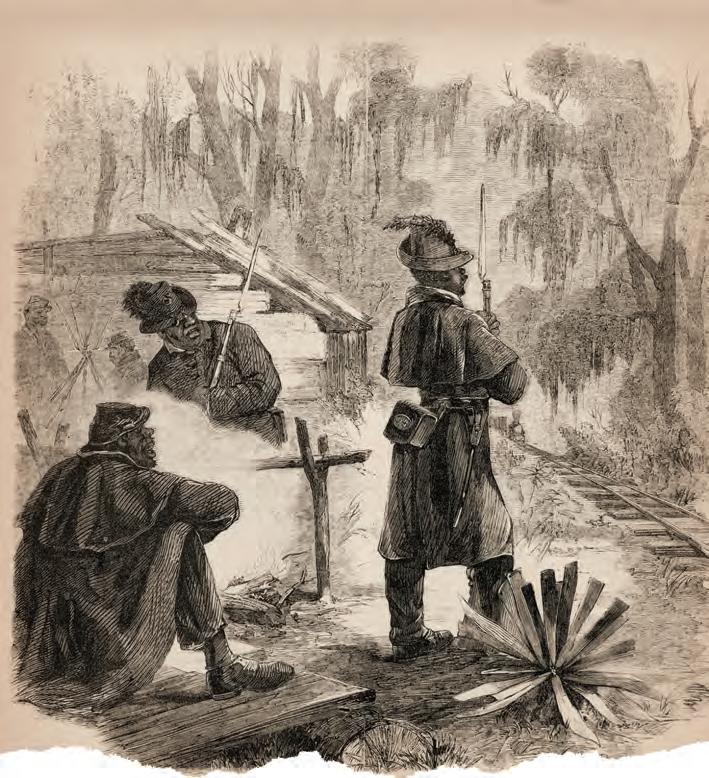
Picket Duty
Early in the war, free men of color and former enslaved men joined the Louisiana Native Guards, shown here guarding a railroad outside New Orleans in 1863.
Rouge, but on May 27, 1863, the regiments joined Maj. Gen. Nathaniel P. Banks’ troops in combat while storming the Confederates’ Mississippi River stronghold at Port Hudson, La. Though unsuccessful, the black troops proved their mettle in battle.
A week later, the Native Guard regiments were reorganized and given new designations. The 4th was now known as the 4th Regiment U.S. Infantry, Corps d’Afrique— assigned to the 19th Corps’ 1st Division in the Department of the Gulf. After the surrender of Port Hudson on July 9, 1863, the 4th was stationed there to guard captured stores but was soon ordered to garrison Forts Jackson and St. Philip below New Orleans. Duty at those riverside forts was pleasant, as civilians in small boats constantly stopped by to sell the soldiers fresh-picked oranges for a penny each. But on February 20, 1864, the unit was transferred back to Port Hudson.
Another new designation would come a few weeks later. Now known as the 76th United States Colored Infantry, under Colonel Charles W. Drew’s command, the regiment formally became part of the Union Army. That certainly produced a measure of pride for the men in the ranks.
Besides guarding the smaller guns captured at Port Hudson, as the larger weapons had already been removed, the 76th was ordered to man them in case of attack by local Confederate cavalry units. Their post commander, Brig. Gen. John P. Hawkins, complained they were being stretched too thin, however. “There are 367 men in the regiment for duty,” he carped, “which barely supplies sentinels over the guns—the camp guard— with a few remaining for detachment drill at the pieces.”
In February 1865, the 76th served under Hawkins, now commanding a division of USCI troops at Algiers, La., near New Orleans. The 76th was put into the 3rd Brigade of Hawkins’ Division, alongside the 48th and 68th USCI. After a short stint, the 76th was
12 AMERICA’S CIVIL WAR REGIMENTAL PRIDE LIBRARY OF CONGRESS
ACWP-230700-REGIMENTAL.indd 12 3/14/23 4:32 PM
transferred to Barrancas, Fla., temporarily becoming a part of the Federal District of West Florida.
Pensacola was its next destination—the port city in Florida’s panhandle serving as a jumping-off point to assist in the capture of Mobile. Major General E.R.S. Canby (Hawkins’ brother-in-law) assembled as many troops as he could to overtake the largest coastal city still in Confederate hands.
The boredom of constant inactivity in guarding facilities and cities was grating on the troops, who understandably wanted to see some action. At Mobile, their wishes would be granted. Following a few weeks of manning the trenches surrounding the city, the men were informed they were to participate in an upcoming assault on Fort Blakeley.
Wrote Drew:
On the night of April 1, my brigade [including the 76th, currently commanded by Major William E. Nye] was ordered to encamp in line of battle to the right of the Stockton road about two miles and a half from the enemy’s works, which was done in the following order: The Sixty-eight Regiment on the right, the Seventy-Sixth in the center, and the Forty-eighth on the left, the command occupying the advance and extreme right.
The next morning about 7:30 our pickets becoming warmly engaged, I formed line as quickly as possible, when I received an order to advance in line of battle. I immediately ordered two companies from each regiment deployed forward as skirmishers, and commenced the advance, which was continued for two miles through a thickly wooded and broken country, my skirmishers fighting about half the way.
about half a mile from the works of the enemy, my right resting on the swamp and my left connecting with General [William A.] Pile’s brigade….
76th U.S. Colored Infantry [4-Year]
Previous Designations
4th Regiment, Louisiana Native Guards (La. Militia); 4th Regiment, Louisiana Native Guards (U.S.); 4th Regiment, Corps d’Afrique
Once halted, Drew’s units began construction of a fortification they named Battery Wilson. A battery of Union artillery moved in behind their position and began bombarding the Confederate position with their four 30-pounder Parrott guns. The artillery pieces later turned their attention to the Confederate gunboats Huntsville and Nashville coming up from Mobile Bay. The noise must have been deafening to the 76th and the rest of their brigade with cannon fire in front of and behind them.
On April 9, Drew noted:
Assigned
La. Militia/19th Corps/ Department of the Gulf/ District of West Florida/ Military Division of Western Mississippi
Mustered In New Orleans, La. Active
1861–December 31, 1865

Total Served 664
Total Casualties 82
Notable Engagements
Occupation of New Orleans; Garrison of Forts Jackson and St. Philip, La.; Siege of Port Hudson, La.; Fort Blakeley, Ala.
Notable Figures
Sgt. Olmsted Massy; Corporal Horace Washington; Captain Frederick Grant; Major William E. Nye; Colonel (Brevet Brigadier General) Charles Wilson Drew
Notwithstanding the numerous obstacles in the way, there was scarcely a break in the line the whole distance. The precision maintained by the line, as well as the bold and steady advance of the skirmishers under heavy fire, were sufficient, I think, to command the admiration of all. Arriving within half a mile of the works I received an order to halt, which was at once communicated to the skirmish line. Our position was then immediately in rear of a ravine
I ordered the Sixty-eight and Seventy-Sixth Regiments (then in the trenches) to double their skirmish lines at 5 p.m. and drive the enemy from his rifle-pits, and if necessary to do it I should order out the regiments entire. Before the work was fairly commenced, however, I heard cheering on my left and saw the skirmishers of the First Brigade advancing. I immediately gave the command forward and forward the entire command (except the Fortyeighth Regiment left in reserve) swept with a yell….Before I could get up with the regiment they had fallen back to the abatis, and when the charge became general they, with the rest, went forward with a shout and did all that brave men could do. The result was soon accomplished and Blakely [ sic ] was ours. I cannot speak in terms of too much praise of the officers and men of my command. Each and every one did willingly all that was asked, working incessantly night and day a large portion of the time. The support and assistance rendered me by regimental commanders entitles them to my warmest gratitude. I could ask for none better.
“The loss suffered by my command from the investment of the place [Mobile] until its capture is 2 officers killed and 3 wounded; enlisted men, 12 killed and 65 wounded,” noted Major Nye.
SUMMER 2023 13 REGIMENTAL PRIDE LIBRARY OF CONGRESS
ACWP-230700-REGIMENTAL.indd 13 3/14/23 4:32 PM
The unit occupied Mobile for only a day before making a 12-day march to Montgomery, the Confederacy’s original capital. In June, they were directed to return to New Orleans. Major General Philip Sheridan then had them board steamers to Alexandria, La., to join forces that Maj. Gen. George Armstrong Custer was assembling for a mission in Texas (see P. 22).
Though not directly part of Custer’s cavalry division in Alexandria, the 76th and the 80th USCI would receive directives from the flamboyant general. Both regiments were to keep the peace in the town and guard governmental stores while Custer tried to train and have several Union cavalry units from different stations in the South work together as a cohesive group before departing for Texas.
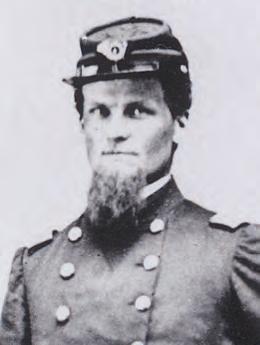
Because of the exhaustive summer heat in central Louisiana, Custer had his troopers build brush arbors atop their canvas tents to lessen the sunlight beating down on them. The African American troops were ordered to occupy the cabins across the Red River in Pineville that had been erected by the Confederate forces occupying Forts Randolph and Buhlow in the winter of 1864-65.
“The men hastily constructed small cabins with pine boards [as well as chimneys for cooking],” recalled Confederate Major Winchester Hall. Noted Augustus V. Ball, a surgeon in McMahan’s Texas Battery, which occupied Pineville until their surrender on June 3, 1865, the structures were “roomy and spacious but they leaked badly and flooded frequently.”
Pineville was considerably smaller than Alexandria but was spared the burning of its counterpart town across the river by retreating Federal forces in mid-1864. The smaller town did not contain much to look at other than small businesses and the Mount Olivet Episcopal Church on Main Street. The large hog-processing building was vacant, an empty symbol of more prosperous times.
‘I Could Ask For None Better’
Soldiers in the 4th Regiment U.S. Infantry, Corps d’Afrique, which became the 76th USCI, conduct artillery drills at Port Hudson, La., after its capture in July 1863.

Left:
Though the works at the two forts were surrounded by massive walls, it wasn’t what the men hadn’t already seen at Port Hudson and Mobile. Something unique, however, was right there in the river in front of them. Being whisked away after only a day inside Mobile, the 76th did not have a chance to get a close look at the Confederate naval craft there. But moored in the river in front of the two forts was the infamous CSS Missouri. Tasked with guarding the ironclad that had struck fear in many Union naval commanders, the soldiers were able to get a closer look on a daily basis.
No major incidents with the civilian population in the area occurred on the 76th’s watch. The unit had more than 300 men present for duty and spent most of the time with repetitive drill, just like the Confederates in the vicinity had done when they were here earlier in the year.

In August the 76th would be sent to its final post: Greenwood, La., outside Shreveport. As their time there wound down, Olmsted Massy, now a sergeant, placed an advertisement in the Philadelphia-based Christian Recorder attempting to locate his wife, Nancy, as he was ready to start a new life as a free man in New Orleans. “She was born and raised in Gochland County, Va.,” the advertisement read. “She was owned, about 15 years ago by John Mickey. Her name before marriage was Nancy Brown.”
The 76th officially disbanded on December 31, 1865.
14 AMERICA’S CIVIL WAR REGIMENTAL PRIDE
FROM TOP: CORBIS/GETTY IMAGES; U.S. ARMY HERITAGE AND EDUCATION CENTER
Colonel Charles W. Drew, the regiment’s commander late in the war.
ACWP-230700-REGIMENTAL.indd 14 3/14/23 4:47 PM
Edward Windsor writes from Corinth, Miss.
Hunting is our heritage, our heart, and our future.
Hunting is our heritage, our heart and our future.
A DEFINITIVE STUDY OF THE MIND, BODY, AND ECOLOGY OF THE HUNTER IN THE MODERN WORLD

Where does hunting fit in the modern world? To many, it can seem outdated or even cruel, but as On Hunting affirms, hunting is holistic, honest, and continually relevant. Authors Lt. Col. Dave Grossman, Linda K. Miller, and Capt. Keith A. Cunningham dive deep into the ancient past of hunting and examine its position today, demonstrating that we cannot understand humanity without first understanding hunting.
Readers will…
• discover how hunting formed us,
• examine hunting ethics and their adaptation to modernity,
• understand the challenges, traditions, and reverence of today’s hunter,
• identify hunting skills and their many applications outside the field,
• learn why hunting is critical to ecological restoration and preservation, and



• gain inspiration to share hunting with others.
Drawing from ecology, philosophy, and anthropology and sprinkled with campfire stories, this wide-ranging examination has rich depths for both nonhunters and hunters alike.

On Hunting shows that we need hunting still—and so does the wild earth we inhabit.


“All true hunters ‘feel’ the truth, but few are able to ‘articulate’ that truth. Now, thankfully, we have On Hunting to be our champion of the wild!”
Order your copy today at GrossmanOnTruth.com ACWP-230418-007 Grossman on Truth Book.indd 1 3/20/23 10:26 AM
—JIM SHOCKEY, Naturalist, Outfitter, TV Producer and Host
The nonprofit NMCWM, based in Frederick, Md., explores the world of medical, surgical, and nursing innovation during the Civil War. To learn more about the stories explored in this and future columns, visit
Medicine Bags
A SURGEON’S SADDLEBAGS HELD VITAL ANESTHETICS AND FIELD REMEDIES

WHEN J. NEWTON ARNOLD enlisted as an assistant surgeon in the 113th New York Infantry in December 1862, he expected to go to the front. Instead, his regiment was converted to the 7th New York Heavy Artillery and spent the next year-and-a-half on garrison duty around Washington, D.C.
The young doctor (only 27 at the time) and his comrades got their wish in May 1864 when they were called up to join Lt. Gen. Ulysses S. Grant and the Army of the Potomac. Within four months, the regiment had lost 68 percent of its men killed, wounded, or missing.
Looking at Arnold’s worn saddlebags, pictured here and on display at the National Museum of Civil War Medicine, it’s easy to imagine the horror in which they were part. He undoubtedly rode hard between dressing stations and hospitals to attend the many wounded.

Each pouch had been filled with metal or glass vials, most likely carrying opiates such as morphine or opium powder, though they may also have contained quinine or other common medications. As the only truly effective painkillers, opiates were doled out by surgeons in staggering quantities.
The saddlebags are embossed with gold, showing the pride Arnold had for his kit. One pouch is embossed “Surgeon J.N. Arnold,” and the other “7th N.Y.H.A.”
LIFE & LIMB
COURTESY OF THE NATIONAL MUSEUM OF CIVIL WAR MEDICINE ACWP-230700-LIFEANDLIMB.indd 16 3/14/23 8:59 AM











The Day the War Was Lost It might not be the one you think Security Breach Intercepts of U.S. radio chatter threatened lives 50 th ANNIVERSARY LINEBACKER II AMERICA’S LAST SHOT AT THE ENEMY First Woman to Die Tragic Death of CIA’s Barbara Robbins HOMEFRONT the Super Bowl era WINTER 2023 WINTER 2023 Vicksburg Chaos Former teacher tastes combat for the first time Elmer Ellsworth A fresh look at his shocking death Plus! Stalled at the Susquehanna Prelude to Gettysburg Gen. John Brown Gordon’s grand plans go up in flames MAY 2022 In 1775 the Continental Army needed weapons— and fast World War II’s Can-Do City Witness to the White War ARMS RACE THE QUARTERLY JOURNAL OF MILITARY HISTORY WINTER 2022 H H STOR .COM JUDGMENT COMES FOR THE BUTCHER OF BATAAN THE STAR BOXERS WHO FOUGHT A PROXY WAR BETWEEN AMERICA AND GERMANY PATTON’S EDGE THE MEN OF HIS 1ST RANGER BATTALION ENRAGED HIM UNTIL THEY SAVED THE DAY JUNE 2022 JULY 3, 1863: FIRSTHAND ACCOUNT OF CONFEDERATE ASSAULT ON CULP’S HILL H In one week, Robert E. Lee, with James Longstreet and Stonewall Jackson, drove the Army of the Potomac away from Richmond. H THE WAR’S LAST WIDOW TELLS HER STORY H LEE TAKES COMMAND CRUCIAL DECISIONS OF THE 1862 SEVEN DAYS CAMPAIGN 16 April 2021 Ending Slavery for Seafarers Pauli Murray’s Remarkable Life Final Photos of William McKinley An Artist’s Take on Jim Crow “He was more unfortunate than criminal,” George Washington wrote of Benedict Arnold’s co-conspirator. No MercyWashington’s tough call on convicted spy John André HISTORYNET.com February 2022 CHOOSE FROM NINE AWARD - WINNING TITLES Your print subscription includes access to 25,000+ stories on historynet.com—and more! Subscribe Now! HOUSE-9-SUBS AD-11.22.indd 1 12/21/22 9:34 AM
No Slow Trot
JOE HOOKER HAD HIS SHORTCOMINGS. BUT WHAT HE DID IN REVITALIZING HIS ARMY’S CAVALRY CORPS WAS MONUMENTAL
By D. Scott Hartwig
THE ARMY OF THE POTOMAC’S cavalry received a muchneeded reorganization when Maj. Gen. Joseph Hooker assumed command of the Union’s largest army in the winter of 1863, transforming from a collection of mounted brigades to a formal Cavalry Corps. Most important perhaps, Hooker infused his horsemen with a new mission. Although they would continue fulfilling the traditional cavalry roles of scouting, picketing, headquarters security, and escort duty, they were now to serve primarily as an offensive weapon—much like J.E.B. Stuart’s vaunted troopers did in the Army of Northern Virginia.
During the Chancellorsville Campaign, Union cavalry performed better in defeat than it had in any previous campaign, but Hooker was disappointed in the leadership of some of its commanders, specifically corps commander George Stoneman and 2nd Division commander William A. Averell. Both lost their jobs in a further reorganization that followed Chancellorsville.
The Cavalry Corps’ new commander would be Maj. Gen. Alfred Pleasonton, known as a notorious self-promoter and miserable intelligence officer but someone Hooker believed might put more fire into his troopers. Pleasonton did. In the early stages of the Gettysburg Campaign in
June 1863, the Federal horsemen took the fight to the Rebel cavalry at Brandy Station, Va., and in a subsequent series of sharply fought engagements at Aldie, Middleburg, and Upperville in central Virginia.
Nevertheless, though his men had fought well, Pleasonton was eager to find positions for his more aggressive subordinates. After Maj. Gen. Julius Stahel’s division was sent as reinforcements from the defenses of Washington, D.C., in late June, Pleasonton convinced the Army of the Potomac’s new commander, Maj. Gen. George G. Meade, to allow him to replace Stahel and his brigade commanders with officers of his own choice.
A Lit Fire
Pleasonton handed Stahel’s command to the recklessly aggressive Brig. Gen. H. Judson Kilpatrick, and to fill the two brigade slots he received approval to jump two junior officers—Elon Farnsworth and George Armstrong Custer—to brigadier general. Both men had been staff officers for Pleasonton and were favorites of the general.
Alfred Pleasonton (right), a brigadier general at this point, poses with one of his favorites, George Custer, who was quick to reward the general’s faith in him.

Also elevated was Captain Wesley Merritt, who was handed a brigade in the cavalry’s 1st Division. All were young, bright, and aggressive officers.
Farnsworth never had a chance to prove himself, for he was killed July 3 at Gettys-
18 AMERICA’S CIVIL WAR FROM THE CROSSROADS LITTLE BIGHORN BATTLEFIELD NATIONAL MONUMENT, NATIONAL PARK SERVICE NOEL KLINE
ACWP-230700-CROSSROADS.indd 18 3/14/23 9:35 AM
burg in a foolish attack demanded by Kilpatrick. Merritt proved an excellent soldier, but it is Custer we remember best. Because of the Little Big Horn showdown that lay in his future, Custer is remembered as a brash, ambitious, and particularly reckless officer. He was indeed brash and ambitious. His performance during the Gettysburg Campaign, however, showed an officer who understood modern cavalry tactics and applied them appropriately while displaying solid leadership commanding volunteers.
The 23-year-old Custer was, in fact, far more prudent than popular history would have us think. He asked for and received command of a brigade of four Michigan regiments: the 1st, 5th, 6th, and 7th. When he arrived in the camps of his brigade in the rain on June 29, Custer’s appearance instantly attracted attention—as he intended. A staff officer described him as “one of the funniest looking beings you ever saw, and looks like a circus rider gone mad! He wears a huzzar jacket and tight trousers, of faded black velvet trimmed with tarnished gold lace.” Not to mention a red cravat.

Ego partly drove Custer’s uniform style, but it also reflected his understanding of volunteer soldiers. They would recognize him instantly on the march or, more importantly, on the battlefield, where he intended to provide them leadership that would inspire them to risk their lives and take the fight to the enemy.

The day after assuming command of his brigade, June 30, Custer’s command engaged J.E.B. Stuart’s Confederate horsemen for the first time at Hanover, Pa. Instead of charging headlong into the fray, heedless of casualties, Custer demonstrated tactical competence, employing his superior firepower—the 5th and 6th Michigan carried Spencer repeaters—by dismounting his troopers and supporting them with attached horse artillery. The result was a check to the Rebel horsemen, who departed to find an easier route to reach Lee’s main army.
On July 2, Custer’s Michiganders encountered Brig. Gen. Wade Hampton’s veteran brigade near the small village of Hunterstown, Pa., several miles northeast of Gettysburg. When the officer leading Custer’s van emerged from the village, he encountered open ground extending west for several hundred yards. Standing partway across these open fields were two farms around which a small rearguard of Hampton’s Brigade had halted to keep the enemy at a distance from the main body.
Uncertain what this small body of enemy cavalry represented, Custer dismounted several companies of the 6th Michigan and unlimbered his horse artillery to provide covering fire. But to disperse the Confederate horsemen, he ordered Company A of the 6th to conduct a mounted charge. Then, as the company readied for its advance, Custer drew his saber and motioned for his staff to stay back before riding out in front of the troopers. With what would be described as a “careless laughing remark,” he declared, “I’ll lead you this time boys. Come on!’”
The charge struck the Confederates hard. Reinforcements from Hampton’s Brigade counterattacked and a wild melee ensued. Custer’s horse was killed beneath him, and he was almost ridden down and killed by a Southern trooper—his life saved by his orderly, who dropped the assailant with a well-aimed shot.
Custer’s prudence in establishing an additional line of fire was rewarded when his dismounted troopers and horse artillery held off Hampton’s counterattack. Though Custer had taken an unnecessary risk in leading the charge, the calculated risk paid dividends in increased confidence and respect for the young general’s leadership.
A day later, Custer made even more of a mark with his men and the army in the much larger cavalry action three miles east of Gettysburg around the John Rummel Farm. Again, Custer displayed a firm grasp of cavalry tactics, skillfully using his troopers in both dismounted and mounted roles, and establishing his horse artillery as a base of fire. And again, Custer deliberately placed himself in harm’s way by leading charges by the 7th and then the 1st Michigan Cavalry. In both charges he rode out in front of his men shouting, “Come on, you Wolverines!” The result was a block of Stuart’s efforts to disrupt the Army of the Potomac’s communication lines.
Custer had accomplished precisely what Pleasonton had sought in advancing these young men to brigade command. It elevated the Union cavalry to the level of J.E.B. Stuart’s. That process had actually begun a few weeks earlier at Brandy Station, but now the Army of the Potomac’s horsemen would be an effective fighting arm. The attrition of two more years of war meant that the men in blue would, however, gradually gain superiority.

SUMMER 2023 19 FROM THE CROSSROADS
LITTLE BIGHORN BATTLEFIELD NATIONAL MONUMENT, NATIONAL PARK SERVICE NOEL KLINE
Scott Hartwig writes from the crossroads of Gettysburg.
Wolverine Wonder
ACWP-230700-CROSSROADS.indd 19 3/14/23 9:35 AM
The towering monument to George Custer’s Michigan Brigade in East Cavalry Field, site of its Day 3 Gettysburg laurels.
Freedom Flight
A so-called “fugitive slave” arrives at a Union military encampment and purported freedom, in an illustration by Edwin Forbes.

‘Concealed in the 92nd’
NORTHERN COLONEL WIELDS THE POWER OF THE MILITARY TO ENFORCE EMANCIPATION
By Daniele Celano
IN NOVEMBER 1862, Marcus Thompson escaped from a farm in Mount Sterling, Ky., to a nearby Union military camp commanded by Colonel Smith D. Atkins of the 92nd Illinois Infantry. Along with 29 other enslaved men, women, and children, Marcus had been farming the fields of a wealthy estate known for its corn and butter production, owned by the elderly Mary Thompson, who, it was clear, was not prepared to accept Marcus’ flight to freedom and teamed with her neighbors in suing Colonel Atkins. The lawsuit would test the legal bounds of emancipation through the military.
A year earlier Atkins, an antebellum lawyer, had abruptly departed in the middle of a criminal case in Freeport, Ill., to answer President Abraham Lincoln’s call for troops after the firing on Fort Sumter. The newly minted state attorney, who worked intermittently as a local newspaper editor, had passed the bar five years earlier.
Energized by the potential of the fledgling Republican Party, Atkins had actively cam-
paigned for Lincoln in 1860. Not all Unionists agreed on the fate of slavery, of course, but Atkins was a fierce abolitionist, believing that emancipation would finally fulfill promises of national equality by the Founding Fathers. In a speech condemning the Supreme Court’s 1857 Dred Scott decision, Atkins posited that warfare would be the only solution to secure a truly free nation.
Fugitive slaves were a particular concern in Kentucky, bordered to the north by the free states of Ohio, Illinois, and Indiana. Numerous state and federal laws criminalized slave flight and prohibited people from aiding and concealing runaways. Under various property laws, slave owners could sue antislavery reformers, and Underground Railroad conductors were often accused of stealing their “property.”
When war erupted in April 1861, Kentucky remained in the Union, and many politicians cited the Constitution’s “Fugitive Slave” clause as a key condition for it. Slaves nevertheless used familiar escape routes and

20 AMERICA’S CIVIL WAR SOUTHERN ACCENT USAHEC MOUSEION ARCHIVES/ALAMY STOCK PHOTO
Southern Accent is produced in partnership with the Nau Civil War Center at the University of Virginia, which promotes scholarship, teaching, and public outreach regarding the United States in the Civil War era. It draws upon UVA’s rich resources, faculty, and students.
ACWP-230700-SOUTHERN.indd 20 3/14/23 9:35 AM
Underground Railroad networks to abscond to Union fortifications. Seizing upon that, the U.S. government passed legislation in 1861-62 freeing fugitive slaves who made it to Army outposts. If the Confederacy considered slaves property, Congress would reason, the U.S. military had the authority over their slaves as contrabands of war.
Even though Congress granted emancipation to all Confederate “contrabands,” the policy threatened to reinforce the controversial interpretation of the enslaved as “property.” This proved especially difficult to navigate in Kentucky. The state had not seceded, and federal authority to invoke the contraband policy in Union territory, at the expense of loyal citizens, remained in question.
The November 1862 conflagration involving Atkins actually was ignited by a Union captain who complained to Maj. Gen. Gordon Granger about three slaves hiding within the 92nd Illinois’ lines. Those slaves—Cyrus, Henry, and Mosely— purportedly belonged to the Union captain’s uncle, Charles Gilkey.
Upon inquiry, Atkins declared he would not release any enslaved person against his or her will, which spurred Gilkey, Mary Thompson, and nearly a dozen other neighbors to retain the prestigious Robertson law firm to bring lawsuits against Atkins. On November 19, backed by armed townspeople, the Mount Sterling sheriff served a summons and “order for delivery of property” against Atkins in an attempt to forcibly remove Marcus Thompson—as well as Cyrus, Henry, Mosely, and a number of other slaves, ages 18 to 27—from the camp.
Fayette Circuit Court.
Mary Thompson against } Order for Delivery of Property
Smith D. Atkins
him the slave Marcus. Said Atkins denied that he had possession of said slave but when charged that he was concealed in the 92 Regt of Illinois vol Infantry USA of which said Atkins is Colonel he did not deny the fact but stated that No officer of the law or other person should search for or take from the camp of his regiment this or any other slave. If attempted the officer would be shot. With the posse the Sheriff was able to summon it was impossible to get possession of or search for said slave.
C.S. Bodley S.F.C.
The plaintiffs made sure to frame their suits around property loss, complete with appraised monetary value for each man, naming Atkins as the thief. The petitions demanded immediate repossession and damages, or, if the sheriff could detain them, judgment for the enslaved men’s value. Although the court ordered Atkins to answer the petition, he refused, which spawned affidavits demanding his compliance. The colonel continued to stand firm, however. In turn, a jury awarded Mary Thompson $625, with an additional $25 in damages. Her fellow plaintiffs secured similar judgments, some as high as $800 per slave, with damages as high as $50.
Besides his time in Kentucky with the 92nd and later with Sherman’s armies, Atkins fought at Fort Donelson and Shiloh.

The Commonwealth of Kentucky, to the Sheriff of Fayette County: YOU are commanded to take the slave Marcus, copper color & 27 years old & medium size, and of the value of Eight Hundred Dollars, from the possession of the Defendant Smith D. Atkins, and deliver him to the Plaintiff, Mary Thompson, upon her giving the Bond required by law: and you will make due return of this order on the 1st day of the next February Term of the Fayette Circuit Court.
Witness: Jno B. Norton, Clerk of said Court, this 18 day of Nov, 1862

Executed Nov 19th 1862 by delivering to S.D. Atkins a true copy of the within order of delivery and demanding of
The judgments totaled more than $12,000, and Atkins feared his property in Illinois could be auctioned off by a court ruling while he was away fighting. Leaving Kentucky later in the war did not end Atkins’ legal troubles either. In August 1864, he was charged with “slave harboring,” by the state’s Montgomery Circuit Court, a judgment carrying a possible sentence of 2–20 years. Despite the indictment, Atkins was never arrested.
The January 1863 Emancipation Proclamation authorized the recruitment of African Americans in the U.S. military. Kentucky and four other border states were exempted from the proclamation’s stipulation that all slaves in Confederate territory were to be freed.
The 92nd Illinois took part in the June-July 1863 Tullahoma Campaign, and Atkins commanded a cavalry brigade during the 1864 March to the Sea and then oversaw the surrender of Chapel Hill, N.C., in April 1865. He ended the war a brevet brigadier general.
In May 1864, Marcus Thompson—still legally a fugitive slave according to Kentucky—enlisted in the 15th USCT, serving until 1866. From 1867 to 1872, he served with the 9th U.S. Cavalry, a famed “Buffalo Soldier” regiment, in Fort Stockton, Texas. Upon his death, he received a military burial in Austin.
SUMMER 2023 21 SOUTHERN ACCENT USAHEC MOUSEION ARCHIVES/ALAMY STOCK PHOTO
Daniele Celano, a Jefferson Scholars Foundation fellow, is a history Ph.D. candidate at the University of Virginia.
Full Résumé
ACWP-230700-SOUTHERN.indd 21 3/14/23 9:36 AM
SumMer of DisconteNT
By

The detritus of war was evident along the banks of the Mississippi as the 7th Indiana Cavalry made its leisurely descent down the river from Memphis.
On June 17, 1865—with Brig. Gen. Stand Watie’s final formal Confederate surrender less than a week away—the Hoosier State troopers had boarded four steamers headed for Alexandria, La.. It would be a pleasant enough cruise that included a pass of Milliken’s Bend, where Black troops had helped engineer a “bloody” Federal victory on June 6-7, 1863, during the Vicksburg Campaign. “The overflowings of the river were rapidly washing away the earthworks, which the negroes so gallantly defended,” noted 1st Lt. Thomas S. Cogley.
At Natchez, Miss., the convoy stopped for what was intended to be a short respite. Because the pilots were unfamiliar with the river and feared tempting an accident, however, they decided to dock there for the evening. That gave the cavalrymen unexpected free time to write letters back home.
On the move the next morning, they enjoyed
some relief from the long journey’s monotony with numerous glimpses of alligators roaming along the water’s edge. One brazen soldier was surprised to see a bullet he fired from his carbine glance off one large reptile’s tough exterior. And though the act of shooting at alligators eventually grew tiresome, once an order was issued forbidding the routine, it led to an inordinate number of “accidental” weapon discharges.
Most of the men were unaware of their final destination. With the war all but over, they figured they were being sent to muster out of service before being allowed to head home. A collection of troops, most working together for the first time, were joining the 7th Indiana in Alexandria. Among these was the 5th Illinois Cavalry, better known as the “Prairie Boys.”
After departing the Mississippi River northwest of Baton Rouge, the boats steamed up the Red River toward Alexandria, located approximately 260 nautical miles from Memphis. Upon their arrival at the juncture of the two rivers, one of the Prairie Boys had noticed “[d]ull, brownish red, soil-laden water flowed into the
22 AMERICA’S CIVIL WAR
As the war ended, Custer and his wife, Libbie, spent time in war-torn central Louisiana. It would be an alarming few months.
LITTLE BIGHORN BATTLEFIELD NATIONAL MONUMENT, NATIONAL PARK SERVICE ACWP-230700-CUSTER.indd 22 3/15/23 8:50 AM
Richard H. Holloway
In Their Element
The Custers pose with Libbie’s attendant, Eliza. While in Alexandria, Eliza convinced the young couple to visit a small group of older former slaves camped behind the local doctor’s house in which they were residing. The Custers were enthused after attending a church sermon conducted by local Blacks.

LITTLE BIGHORN BATTLEFIELD NATIONAL MONUMENT, NATIONAL PARK SERVICE ACWP-230700-CUSTER.indd 23 3/15/23 8:51 AM
Mississippi from the Red River.” During the spring, Red River water levels were normally low, making it hard to navigate, and by the summer of 1865 the river had remained drained and sluggish.
Near Marksville, La., the troopers passed the abandoned earthen works at Fort DeRussy. Then, about 50 miles from their destination, they began to notice that the ground was low, flat, and heavily wooded—but also enveloped by a considerable amount of water, essential for growing sugar and cotton. The heat, though, was oppressive at this time of year, and the heavy tree line cut off any potential breeze to cool the travelers down.
The commander of the group of soldiers assembling in central Louisiana was none other than Maj. Gen. George Armstrong Custer. Accompanied by his young bride, Elizabeth Bacon “Libbie” Custer, the now-famous general had been dispatched to this vicinity by Maj. Gen. Phil Sheridan while stationed in Arlington, Va. Rumors were circulating that a Rebel force had pledged to perpetuate the Confederacy in Texas.
At the time the orders were issued, it was speculated that Confederate President Jefferson Davis was on the way to join Major George Kirby and a large force of Southerners in Texas. Some in the North feared the Confederates might even ally themselves with the French in Mexico and reignite the fighting.

Sheridan assigned Custer to pursue and subdue the enemy gathering in the Lone Star State, but he was initially to assemble at Alex-
Lurking Danger
Steamboats prowling tree-lined rivers, many of them filled with soldiers, their equipment, and their animals, were a familiar sight in Louisiana. Such excursions were fraught with hidden water-borne obstacles and alligators.
andria and create an effective fighting force. En route to central Louisiana, the Custers near the end of June had boarded a steamboat in New Orleans. Of their journey, Libbie recalled: “We grew to have an increasing respect for the skill of the [steamboat] pilot, as he steered us around sharp turns, across low water filled with branching upturned tree trunks, and skillfully took a narrow path between the shore and a snag that menacingly ran its black point out of the water.”
As had the troops Custer was about to command, the couple encountered alligators during their voyage, the massive beasts often sunning themselves on sandbars beside the water. Because of the tendency for fired bullets merely to bounce off the creatures’ skin, as the 7th Indiana troopers had already learned, Custer was determined to find a vulnerable spot at which to aim. After a few shots with a rifle borrowed from a steamboat guard, Custer finally succeeded in killing one.
According to Libbie’s attendant, Eliza, the general’s wife had several firsthand opportunities to view alligators at a distance. During the Custers’ boat ride, an unsuspecting African American lad was napping on a sandbar outside

24 AMERICA’S CIVIL WAR HERITAGE AUCTIONS, DALLAS, TEXAS HISTORIC NEW ORLEANS COLLECTION/BRIDGEMAN IMAGES; MAP BY AUSTIN STAHL
Alexandria New Orleans
LOUISIANA ACWP-230700-CUSTER.indd 24 3/15/23 8:51 AM
Red River Mississippi River
Alexandria as an alligator crept toward him. Using a loaned carbine, Custer dispatched the animal with a single shot.
On June 23, the 7th Indiana disembarked at a sugar plantation at the edge of Alexandria. The troopers immediately felt the effects of the harsh sun, the open fields offering no shade. Noted Cogley: “Awnings, both for the men and the horses were constructed of poles and brush brought from the woods, which measurably relieved the suffering...”
“The residents had partially rebuilt the town after [Maj. Gen.] A.J. Smith set [it] ablaze when the Federals withdrew in May 1864,” recalled one 5th Illinois trooper. “A few small, one-story cottages replaced the once thriving town....”
“Low, flat countryside bordered Alexandria, and the smell of rank, decomposing vegetation rose from the banks,” wrote another Prairie Boy.
“The hot, tepid air and stagnant water of hundreds of boggy bayous created an oasis for mosquitoes. Clouds of bloodsuckers, including gallinippers [large flying insects with a painful bite] enveloped the men when they landed.”
Libbie Custer seemed even less impressed:
The houses along the Red River were raised from the ground on piles, as the soil was too soft and porous for cellars. Before the fences were destroyed and the place fell into dilapidation, there might have been a lattice around the base of the building, but now it was gone. Though this open space under the house gave vent for what air was stirring, it also offered free circulation to pigs, that ran grunting and squealing back and forth, and even calves sought its grateful shelter from the sun and flies.
Cogley was more sympathetic to the locals’ plight. “Alexandria, before the war was a small city of about five thousand inhabitants,” he noted. “It acquired some historic interest by being given over to the torch, and the greater and best portion of it destroyed by fire, by General [Nathaniel] Banks, when he left….At the time [our] regiment was there, it contained but about five hundred inhabitants. Old chimneys had not yet fallen, and ruined walls marked the site of former business blocks or palatial residences.”
Once the unaffiliated regiments arrived, they were separated into two brigades. The 7th Indiana, 5th Illinois, and 12th Illinois Cavalry comprised the 1st Brigade of Custer’s new division—to be headed by Brig. Gen. George A. Forsyth—and the 1st Iowa
Straight From Libbie’s Heart
Custer’s personal battle flag, sewn by Libbie, who delivered it to him daringly during the March 1865 Battle of Dinwiddie Court House. Bearing it aloft, Custer led a charge in winning the battle. Left behind, it was not with him when he was killed at Little Big Horn.

Cavalry and 2nd Wisconsin Cavalry formed the division’s 2nd Brigade, under Colonel William Thompson’s command.
Also supporting Custer were two Black regiments, the 76th and 80th USCI. While these units were not formally under the command of the cavalry division, they were under Custer’s direction. Each regiment in the mounted brigades were re-fitted with Spencer carbines and new mounts, except the 2nd Wisconsin, which had already been issued them before arriving after winning a shooting contest. Still, the men were lacking in adequate garrison equipment, and had poor clothing issues.
Libbie described the men of her husband’s command as “[t]ired out with the long service, weary with an uncomfortable journey by river from Memphis, sweltering under a Gulf-coast sun, under orders to go farther and farther from home when the war was over, the one desire was, to be mustered out and released from a service that became irksome and baleful when a prospect of crushing the enemy no longer existed.”
Before the troops could settle, Custer issued what turned out to be an extremely unpopular Special Orders No. 2:
Headquarters Cavalry
Alexandria, Louisiana. June 24th, 1865.
Special Orders No. 2.
Numerous complaints having reached these headquarters of depredations having been committed by persons belonging to this command; all officers and soldiers are hereby urged to use every exertion to prevent the committal of acts of lawlessness, which, if permitted to pass unpunished, will bring discredit upon the command. Now that the war is virtually ended, the rebellion put down, and peace about to be restored to our entire country, let not the lustre of the last four years be dimmed by a single act of misconduct toward the persons or property of those with whom we may be brought in contact. In future, and particularly on the march, the utmost care will be exercised to save the inhabitants of the country in which we may be located from any molestation whatever.
As supplies can be obtained from the supply train when needed, there will be no necessity for foraging upon the country.
SUMMER 2023 25 HERITAGE AUCTIONS,
TEXAS HISTORIC NEW ORLEANS COLLECTION/BRIDGEMAN
BY
DALLAS,
IMAGES; MAP
AUSTIN STAHL
ACWP-230700-CUSTER.indd 25 3/15/23 8:51 AM
No foraging parties will be sent out from this command without written permission from these headquarters and then only to obtain fresh beef and grain, for which payment will be made by the chiefs of the proper departments at these headquarters.
Every violation of this order will receive prompt and severe punishment. Owing to the delays of court martials, and their impracticability when the command is unsettled, it is hereby ordered that any enlisted man violating the above order, or committing depredations upon the persons or property of citizens, will have his head shaved, and in addition will receive twenty-five lashes upon his back, well laid on. This punishment will, in all cases, be administered under the supervision of the Provost Marshal of the command, who is charged with the execution of this order so far as it in his power.
Any officer failing to adopt proper steps to restrain his men from violating this order, or fails to report to these headquarters the names of those violating it, will be at once arrested and his name forwarded to the proper authority for prompt and dishonorable dismissal from the army. The commanding General is well aware that the number of those upon whom the enforcement of this order will be necessary will be small, and he trusts that in no case will be necessary.
He is also confident that those who entered the service from proper motives will see the necessity for a strict compliance with the requirements of this order.
Citizens of the surrounding country are earnestly invited to furnish these headquarters any information they may acquire which will lead to the discovery of any parties violating the forgoing order.
Regimental commanders will publish this order to every man in their commands.
By the command of Major General Custer.
The reaction among the command was swift. One of the displeased was 1st Iowa surgeon Charles H. Lothrop, who wrote:
On the promulgation of this order no little indignation was manifested by all the troops, which would be natural among all honorable and high-minded men, who from purely patriotic motives responded to the first call for volunteers to defend and maintain the laws of the country, and endured the privations and vicissitudes incidental to
Apparently Not Enough Power
This sketch, which appeared in the April 30, 1864, edition of Frank Leslie’s Illustrated Newspaper, depicts gunboats and transports in Union Rear Adm. David Dixon Porter’s flotilla in front of Alexandria during Maj. Gen. Nathaniel P. Banks’ ill-fated Red River Campaign.

four years’ active warfare, to be thus subjected to eternal disgraces without a shadow of law or precedent; and real citizens, entertaining the most malignant bitterness towards federal soldiers.
Nevertheless, considering the situation facing his men, Custer’s decision had been correct. Indeed, many former Confederate soldiers occupied the surrounding countryside and likely would need only a small provocation to band together and launch attacks on the isolated command. Alexandria’s mayor had surrendered the town only on June 3, mere weeks before Custer’s arrival. Its citizens undoubtedly harbored ill will toward the men in blue, as barely a year had passed since Federal troops had burned their town maliciously on May 13, 1864.
A subsequent wave of desertions was clearly proof Custer had trouble discerning the difference between volunteer soldiers and Regular Army cavalry. In the wake of the order, members of the 5th Illinois began leaving in droves. Although most of these deserters had recently transferred from the 11th Illinois Cavalry, the loss of eight—Joseph Hakin, William H. Barcus, Jesse Cannon, Thomas Ross, John Brown, Thomas W. Wiley, William H. Warren, and Archibald C. Tigner—was somewhat shocking
26 AMERICA’S CIVIL WAR LIBRARY OF CONGRESS RICHARD H. HOLLOWAY COLLECTION (2)
ACWP-230700-CUSTER.indd 26 3/15/23 8:52 AM
as they had enlisted at the war’s start in 1861.
Another trooper attempting to flee, William A. Wilson, was caught and court-martialed. Other units also reported serious departures from their command. “On several occasions,” Lieutenant Cogley recalled, “nearly the whole command was called out at night, to prevent the threatened desertions of companies and of a regiment.”
While in Alexandria, 15 members of the Prairie Boys alone deserted, and by the time of their October mustering-out, they would be short 75 troopers. Some dangerous incidents even sprang up during this period.
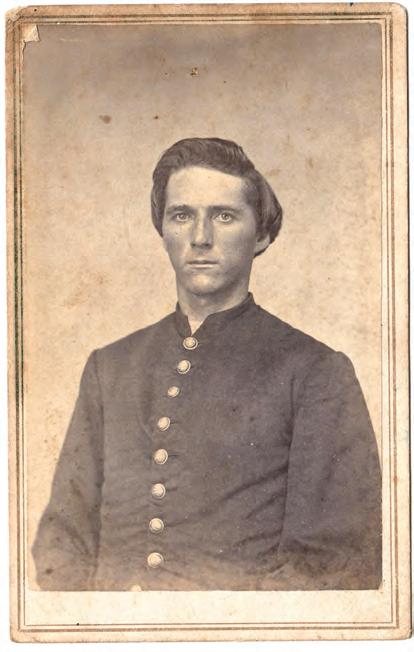
“The soldiers did not confine their maledictions to the regular officers of command; they openly refused to obey their own officers,” Libbie reported.
“One of the colonels (I am glad I have forgotten his name) made a social call at our house. He was in great perturbation of mind, and evidently terrified, as in the preceding night his dissatisfied soldiers had riddled his tent with bullets, and, but for his ‘Lying low,’ he would have been perforated like a sieve.”
Unfortunately, Custer ended up further exacerbating the friction with his men by directing them to perform menial tasks for his family. In a response to Custer’s report of the strife he was experiencing, Sheridan instructed, “Use such summary measures as you deem proper to overcome the mutinous disposition of the individuals.”
Having become a strict disciplinarian, Custer became enraged when hearing of the trouble in his command. “The conduct of these troops while at Alexandria was infamous, and rendered them a terror to the inhabitants of that locality, and a disgrace to this and any other service,” he would write. “Highway robbery was of frequent occurrence each day. Farmers bringing cotton or other produce to town were permitted to sell it and then robbed in open daylight upon the streets of their town.”
Custer’s command had dissolved into an unruly rabble determined to wreak revenge on the Southern population.
Well after the war, Union 1st Lt. Michael Griffin attempted to explain the problems Custer was having by writing, “[We] had come directly from
the Army of the Potomac.” The inner conflict between Custer and his Western troops was part of a rivalry of who was tougher or better than the other: the hard Western trooper or the apparent dandies from the East. As the war played out, the Army of the Potomac veterans were actually just as tough as their counterparts to the West, having had to fight Lee, Jackson, and Stuart for so long. Dutifully, though, the remaining soldiers who decided to stay endeavored to drill together and become a cohesive unit for the upcoming campaign in Texas.
When it came up in conversation, Custer adopted a soothing demeanor to calm Libbie’s concerns about the openly hostile activities around them. Despite the controversies, Custer and his wife endeavored to make their stay in central Louisiana pleasant. Eliza convinced Libbie to get out and visit the elderly former slaves encamped behind Dr. John Casson’s house in Alexandria where the Custers were staying and where General Banks had lodged in 1864. Eventually, Custer joined in these interactions and provided food for the seniors. They also attended church services there.

“It was at Alexandria that I first visited a negro prayer-meeting,” Libbie recalled. “As we sat on the gallery one evening, we heard the shouting and
Feeling Custer’s Wrath
Privates Joseph Hakin (top) and William A. Wilson (above) of the 5th Illinois Cavalry, both deserted while in Custer’s command. Hakin succeeded in getting away, but Wilson was captured and sentenced to be executed.
SUMMER 2023 27 LIBRARY OF CONGRESS RICHARD H. HOLLOWAY COLLECTION (2)
“The soldiers did not confine their maledictions to the regular officers of command; they openly refused to obey their own officers”
ACWP-230700-CUSTER.indd 27 3/15/23 8:52 AM
singing, and quietly crept around to the cabin where the exhorting and groaning were going on. Though they were so poor and helpless, and seemingly without anything to inspire gratitude, evidently there were reasons in their mind for the heart-felt thanks [for the nourishment provided by the Custers] as there was no mistaking the genuineness of feeling when they sang [grateful hymns]. They swayed back and forth as they set about the dimly lighted cabin, clapped their hands spasmodically, and raised their eyes to heaven in moments of absorption.”
The Custers did experience some lighter moments with some of the soldiers not quite as disgruntled as the rest. The 7th Indiana troopers in particular tried to alleviate tensions with their commanding general. After spending long hours in the hot sun drilling, they would often relax by fishing and catching alligators. “Occasionally, a baby alligator from a foot and a half to two feet in length, got on dry land and was taken prisoner by the men,” Cogley wrote.
Aware of Libbie’s fear of the beastly reptiles, Custer proposed to put her at ease by exposing her to one of the smaller ones the Indiana troopers had captured. As Libbie recalled: “[T]he General, thinking to quiet my terror of them by letting me see the reptile ‘close to’ as the children say, took me down to camp, where the delighted soldier told me how he had caught it, holding on to the tail, which is its weapon. The animal was all head and tail; there seemed to be no intermediate anatomy. He flung the latter member at a hat in so vicious and violent a way, that I believed instantly the story, which I had first received with doubt, of his rapping over a puppy and swallowing him before a rescue could come. This pet was in a long tank of water the owner had built, and it gave the soldiers much amusement.” Many times the baby alligators’ parents would come on shore hunting for them, sending the ladies scurrying for safety and the soldiers for their weapons.
Libbie also documented the excursions into the countryside that she and her husband would make to relieve tensions. The heat was still stifling
during daylight so the couple went for evening rides around the area. Libbie’s state of mind eased considerably upon touring the area. “It seemed to me a land of enchantment,” she allowed. “We had never known such luxuriance of vegetation. The valley of the river extended several miles inland, the foliage was varied and abundant, and the sunsets had a deeper, richer colors than any in the North. We sometimes rode for miles along the country roads, between hedges of osage–orange on one side, and a double white rose on the other, growing fifteen feet high. The dew enchanted the fragrance, and a lavish profusion was displayed by nature in that valley, which was a constant delight to us.”
The couple’s explorations brought them to the Louisiana State Seminary and Military Academy, a facility that Libbie noted was still called the “Sherman Institute.”
“General Sherman had been head of this military school before the war, but it was subsequently converted into a hospital,” she elaborated. “It was in a lonely and deserted district, and the great empty stone building, with
Scaled Fear
The sight of a large alligator, even under restraint like this one, often sent the Union officers’ wives scurrying. Libbie Custer was particularly afraid of the beasts, no matter their size and despite her husband’s reassurances.

28 AMERICA’S CIVIL WAR OPPOSITE: “TENTING ON THE PLAINS, OR GENERAL CUSTER IN KANSAS AND TEXAS,” BY ELIZABETH B. CUSTER; THIS PAGE: SAM HOUSTON MEMORIAL MUSEUM
ACWP-230700-CUSTER.indd 28 3/15/23 8:52 AM
its turreted corners and modern architecture, seemed utterly incongruous in the wild pine forest that surrounded it.
“We returned to the river, and visited two forts [Forts Randolph and Buhlow] on the bank opposite Alexandria. The General took in at once the admirable situation selected, which commanded the river for many miles. He thoroughly appreciated, and endeavored carefully to explain to me, how cleverly the few materials at the disposal of the impoverished South had been used. The moat about the forts was the deepest our officers had ever seen. Closely my husband studied the plan and formation, he said it would have added greatly to his appreciation, had he known then that the Confederate engineer who planned this admirable fortification was one of his classmates at West Point.”
The general also climbed with his wife atop the walls of Fort Randolph to get a glimpse of Colonel Joseph Bailey’s dam in the river that had saved a Union fleet from destruction the previous year. Additional excursions of the area’s buildings continued, and the Custers also took time to observe the notorious ironclad CSS Missouri, no longer in service and resting idly in the Red River between the two forts.
Across the river in Pineville, Custer stationed the two Black regiments. Tasked to keep the order among citizens, desertions among these troops were fairly low, as morale was better. First Lieutenant Biddle Boggs of the 80th USCI, who also was the acting regimental post quartermaster and ordnance officer, actually bragged to his sister, Sarah Wheldon: “We [Boggs and his wife, Maria] can live much cheaper here than New Orleans. We can buy chickens for 25 cents each,
eggs 25 to 30 cents per dozen and butter 50 to 75 cents per pound but rather white and soft.”
The men occupied the cabins at the forts, which had been built the year before by the Confederate garrison. Confederate Colonel Winchester Hall of the 26th Louisiana Infantry mentioned, “The men hastily constructed small cabins with pine boards.”
Although the cabins were dilapidated by the time the USCI soldiers arrived, they were still preferable to the constant burning rays of the sun. Rain, however, provided its own misery for
Home With a View
Sam Houston Jr., son of the legendary former Texas governor, drew this image of one of Fort Randolph’s log cabins, built by Confederate troops in 1864. The younger Sam Houston had been stationed at Fort Randolph until May 1865, shortly before Custer’s arrival.
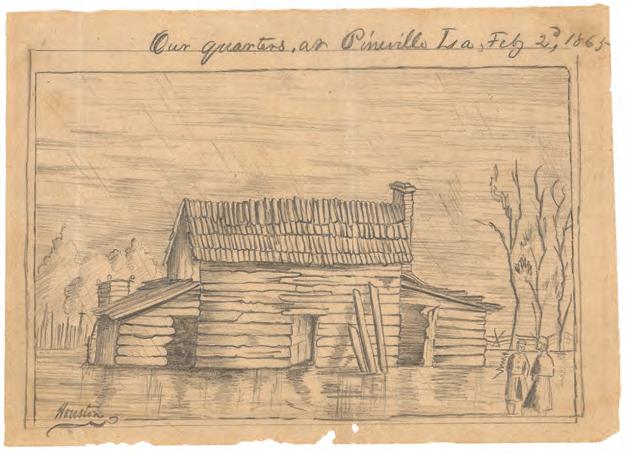
the men who now occupied them. They “leaked badly and flooded frequently,” asserted a former occupant, surgeon Augustus V. Ball of McMahan’s Texas Battery. Tensions remained high, and national news did not help the situation. Word reached Alexandria on July 11 that four conspirators in President Abraham Lincoln’s assassination had been hanged on July 7. Upon hearing the news, Boggs quickly jotted down a short letter to his sister to express his thoughts: “Hurrah for [U.S. President] Andy Johnson for hanging Mrs. Surratt and all other assassins. It saves trouble and sends witches where they belong—to Old Nick [Satan]. Who would want to be in Heaven with assassins[?]”
By far, the most disturbing issue that occurred while stationed in Alexandria was a court-martial of two men. Lincoln’s assassination had been the root of that, as members of the 2nd Wisconsin were livid to be still under the command of Lt. Col. Nicholas H. Dale. In April, Dale had made several inflammatory statements after learning of Lincoln’s death. Told of the tragedy, Dale reportedly replied: “That is all right. The country suffers nothing by such a loss. Abe Lincoln is an imbecile. Abe Lincoln is an old fool.”
The men in the ranks believed their commander had disgraced the Army with his insult. Given the audience of men who had overwhelmingly supported Lincoln’s reelection the previous November, the colonel’s words were ill-advised. Dale would be brought up on charges for his contemptuous and disrespectful language.
“[The] strenuous efforts and endeavors were required of the 2nd Wisconsin troopers to suppress riot and insubordination,” according to one report. On April 18, two days before Lincoln’s funeral, Dale’s court-martial lasted mere hours. Though found guilty, he suffered only a reprimand, leaving the Badger State boys infuriated. Now in Alexandria, they continued to seethe at the trial’s result.
When 2nd Wisconsin Lieutenant Leonard L. Lancaster arrived in Alexandria on July 6, it only exacerbated the situation. Lancaster and his company had been on assignment since early in the year, guarding the
SUMMER 2023 29 OPPOSITE: “TENTING ON THE
PLAINS, OR GENERAL CUSTER IN KANSAS AND TEXAS,” BY ELIZABETH B. CUSTER; THIS PAGE: SAM HOUSTON MEMORIAL MUSEUM
“It seemed to me a land of enchantment. We had never known such luxuriance of vegetation”
ACWP-230700-CUSTER.indd 29 3/15/23 8:53 AM
Country Comfort
One of the relaxing things the Custers were able to do while in central Louisiana was to tour the surrounding countryside on horseback. Notable sites in Alexandria included the Kent Plantation and St. Francis Xavier Cathedral. They would also take the ferry across the Red River to Pineville to visit the Confederate Forts Randolph and Buhlow as well as the Louisiana State Seminary of Learning and Military Academy which they called the Sherman Institute as Maj. Gen. William T. Sherman was its first president.
railroads in Grenada, Miss., and had not seen their comrades in some time. The Confederate threat in Texas was subsiding, but a possible altercation in Mexico remained possible.
The men of the 2nd Wisconsin roundly welcomed Lancaster’s return, according to 1st Lt. Michael Griffin. They quickly made the lieutenant aware of a petition they were circulating to have Dale removed. “Here is Len; he will go with us,” Griffin remembered the men declaring. Agreeing that Dale’s words about Lincoln were an embarrassment to the unit, Lancaster signed the petition and said, “Yes, where do you want to go? To see Col. Dale? Alright fall in.”
This somewhat lighthearted account by one of Lancaster’s supporters should, of course, be taken with a grain of salt. For one thing, most of the men were highly inebriated at the time, which was never accounted for in any of these unofficial post-action reports.
Lancaster soon had several hundred men following him to Dale’s tent, the mob intent on securing their commander’s resignation. Standing in the way initially was Captain Zelotes P. Coggswell, commanding the guard. Coggswell managed to turn a few away from the direction of Dale’s quarters, spurring Lancaster to call out belligerently, “What in hell is the use of my going unless you follow me?”
Reaching Dale’s tent, Lancaster and the group would be halted by Captain George W. Nobles, officer of the day. When Nobles asked them to disperse, Lancaster tersely commented: “I am responsible for this thing. Colonel Dale shall not command this regiment. We are going to put him and his baggage on the steamer Hillman and send him home.”
(1) Kent Plantation House (Alexandria) • Completed in 1800, the Creole-style building, along with its slave cabins are the oldest structures still standing in central Louisiana.

(2) Mount Olivet Chapel (Pineville) • Built in 1859, the Episcopal Church was consecrated by Bishop (later General) Leonidas Polk.
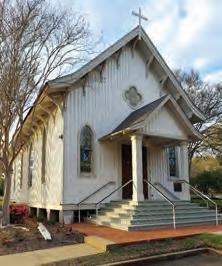
(3) Fort Randolph (Pineville) • This Confederate fort and a adjoining structure named Fort Buhlow were manned by the 76th and 80th USCI and toured by the Custers.

St. Francis Xavier Cathedral (Alexandria) • This Catholic church was defended by Father J.P. Bellier when Maj. Gen. Nathaniel Banks’ troops attempted to burn it on the way out of town.
Louisiana State Seminary of Learning and Military Academy (Pineville) • The forerunner of Louisiana State University in Baton Rouge, it was referred to as the Sherman Institute by the Custers. It was called Taylor Hospital during the war.
For a closer video look at some of these sites, go to historynet.com/CusterAlexandriaTour
At that moment, Dale burst out of the tent and confronted the angry men. Lancaster repeated his demand for the lieutenant colonel’s resignation and harshly stated, “….if Dale refused, Custer would share the same fate.”
After successfully convincing the drunken soldiers to go back to their camp, Dale had Lancaster brought up on charges. Lancaster’s court-martial was convened July 18. He sat silently through the testimony against him, simply stating when it was his time to speak:
“[A]t the time of the riot, [I] was intoxicated and did not know what he said.”
Despite a heretofore spotless service record, Lancaster was quickly found guilty and Custer signed the order for his execution, alongside Private Wilson of the 5th Illinois, who was found guilty of desertion and likewise sentenced to death. Both men languished in a small local jail that was already full of fellow

COURTESY RICHARD H. HOLLOWAY (3) LITTLE BIGHORN BATTLEFIELD NATIONAL MONUMENT, NATIONAL PARK SERVICE; © DON TROIANI, ALL RIGHTS RESERVED 2023 / BRIDGEMAN IMAGES
➊ ➋ ➌ ACWP-230700-CUSTER.indd 30 3/15/23 8:54 AM
comrades sentenced for lesser offenses.
The inmates would take turns standing in front of the 14-inch square hole above ground level, the only air available in the stifling heat. Lancaster and Wilson were incarcerated until July 28, when they were both to be executed. On the final day, the two men had their wrists bound together and were led to the designated area for their sentences to be carried out. A hollow square of 5,000 of their fellow soldiers surrounded them, and coffins were placed at their sides.

The prisoners had their faces covered with hoods, but as the firing squad was about to carry out the execution, Custer gave a quick nod
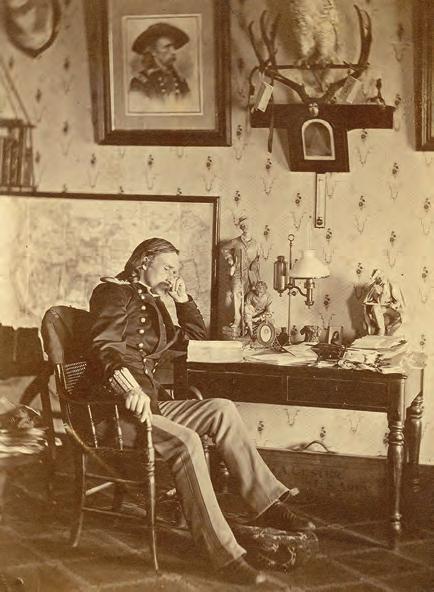
Command Transformation
Above: Custer leads the Michigan Brigade on a charge across Gettysburg’s East Cavalry Field, in Don Troiani’s “Come On, You Wolverines!”—an epic moment in the charismatic general’s Civil War. Left: Custer, in his luxuriant Fort Lincoln quarters in Dakota Territory, a few years prior to his fateful Little Big Horn clash. In Alexandria and later, Custer’s command approach was dramatically different. He became much more of a disciplinarian.

to the provost marshal, who pulled Lancaster from the danger zone just before the men fired. Young Wilson was not so lucky, as he was killed instantly.
Custer read an order from President Johnson commuting Lancaster’s death penalty, giving him instead a dishonorable discharge and ordering him to be sentenced to three years hard labor. Custer had received the pardon that morning, but upset with Lancaster’s drunken and treasonous behavior, he let the charade of the junior officer’s execution play out to the last seconds. “General Custer told Colonel Dale that he wanted to shoot Lancaster,” said Private Emmet C. West of the 2nd Wisconsin, “If General Custer had any humane feelings in his soul he would have issued an order immediately [stopping Lancaster’s death sentence].”
The next week, Custer received orders to bring his command to Hempstead, Texas. Frustration among the troopers continued, as Custer issued strict marching orders, again not garnering any feelings of loyalty among them. The cavalrymen were mustered out of service in October 1865, most having a life-long dislike of the perceived dandy from the Eastern Theater. Later in life and into the Dakotas, Custer would carry a mockingbird in a small cage as a memento of the summer of 1865.
Richard H. Holloway serves on America’s Civil War’s editorial advisory board. He recently completed writing about the rejuvenation of the Confederate Army of Tennessee at Dalton, Ga., slated for publication in 2023.
SUMMER 2023 31 COURTESY RICHARD H. HOLLOWAY (3) LITTLE BIGHORN BATTLEFIELD NATIONAL MONUMENT, NATIONAL PARK SERVICE; © DON TROIANI, ALL RIGHTS RESERVED 2023 / BRIDGEMAN IMAGES
ACWP-230700-CUSTER.indd 31 3/15/23 10:54 AM
the reckoniNg at yeLlow Tavern
Behind George Custer’s lead, Sheridan makes good on his promise to “whip” J.E.B. Stuart
 By Adolfo Ovies
By Adolfo Ovies
32 AMERICA’S CIVIL WAR
ACWP-230700-YELLOWTAVERN.indd 32 3/15/23 8:55 AM
Close-Quarters Clash
Union and Confederate cavalrymen collide during the Battle of Yellow Tavern on May 11, 1864. The eventual Union victory was fought in two stages, with action from 8 a.m. to 2 p.m. and 4 p.m. to dusk.

SUMMER 2023 33
ACWP-230700-YELLOWTAVERN.indd 33 3/15/23 8:56 AM
As he waited for Phil Sheridan at his headquarters tent, Army of the Potomac commander George G. Meade knew an argument with “Little Phil” was inevitable. It was May 8, 1864, early afternoon, and the fiery generals were meeting to discuss that morning’s travesty at Snell’s Bridge, on the road to Spotsylvania. An unexpected convergence of infantry and Sheridan’s cavalry at the key river crossing had essentially grounded the Union army’s effort to outflank Robert E. Lee’s Army of Northern Virginia in the wake of three days of bloodshed at the Wilderness. The delay helped Lee outrace the Federals to Spotsylvania, setting the stage for l2 days of further slaughter there in what would be the Overland Campaign’s longest battle.
Although Meade and Sheridan’s meeting was perhaps always doomed to take a nasty turn, it nevertheless was breathtaking how quickly it occurred. Staff members clustered around the headquarters tent and listened in unabashedly to the bickering generals’ antics. “When Sheridan appeared,” recounted Horace Porter, Lt. Gen. Ulysses S. Grant’s personal secretary, “[Meade] went at him hammer and tong.” The “Old Snapping Turtle” would live up to his reputation. In no uncertain terms, he accused Sheridan of myriad blunders, not the least of which was Sheridan’s failure to leave the Snell’s Bridge crossing open for the advance of Maj. Gen. Gouverneur Warren’s 5th Corps. Meade claimed he had sent Sheridan orders to keep the road clear for the infantry, a directive Sheridan vehemently denied ever receiving.

Accomplished Command
Bordering on insubordination, Sheridan upbraided Meade for interfering in the inner workings of his command. “His language throughout,” Porter wrote, “was highly spiced and conspicuously italicized with expletives.” The wrathful Sheridan asserted he “could see nothing to oppose the advance of the V Corps…” and that the infantry’s behavior had been “disgraceful, etc., etc.”
“One word brought on another,” Sheridan would write, “until, finally, I told him that I could whip [J.E.B.] Stuart if he would only let me.” At the end of the “acrimonious interview,” Meade went directly to Grant to inform him of the belligerent Irishman’s declaration, drawing only a simple response from the phlegmatic Grant: “Did he say so? Then let him go out and do it.”
Given the go-ahead, Sheridan wasted little time in preparation. At 3 a.m. May 9, 12,000 troopers—three divisions under Brig. Gens. Wesley Merritt, David Gregg, and the relatively untested James Wilson—crossed at Ely’s Ford heading for Richmond. Over the next 15 days, while the Union and Confederate armies clashed in wood-tangled fields around Spotsylvania Court House, Sheridan kept his Confederate counterpart’s
34 AMERICA’S CIVIL WAR PREVIOUS SPREAD: NIDAY PICTURE LIBRARY/ALAMY STOCK PHOTO; THIS PAGE: LIBRARY OF CONGRESS TOP: LIBRARY OF CONGRESS (2)
ACWP-230700-YELLOWTAVERN.indd 34 3/15/23 8:56 AM
Major General Philip Sheridan poses with some of his Cavalry Corps commanders during the Overland Campaign. Pictured left to right are Brig. Gens. Henry E. Davies, David McMurtrie Gregg, Sheridan, Wesley Merritt, Alfred Thomas Archimedes Torbert, and James H. Wilson.
vaunted horsemen at bay, reaching the outskirts of the capital city before reversing course and returning toward Spotsylvania. “We will give [Stuart] a fair, square fight,” Little Phil told his subordinates. “[W]e are strong, and I know we can beat him….I shall expect nothing but success.”
Stuart, of course, was one general whom Lee never needed to prod into battle. From the minute the Yankees began moving, he was on them—engaged, according to a Confederate staff officer, “in joyful combat…already fighting back every step of the Federal advance.”
Sheridan’s marching column was as lightly encumbered as possible. The men were issued three-day rations. It would be a different matter, however, for the horses, whose forage was cut to the bone, allowing for only one-half of one day’s ration of grain and meaning the animals would have to depend on whatever they were able to scrounge.
“The night was clear and quiet; the air was soft and refreshing,” recalled James H. Kidd, at the time a major in the 6th Michigan, part of Brig. Gen. George Armstrong Custer’s 1st Brigade in Merritt’s 1st Division. Sweeping past the left of the infantry line, the cavalry turned southeast where the Telegraph Road crossed Massaponax Creek.
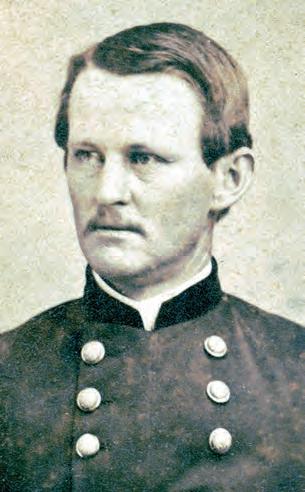

To Custer, “the bright, particular star in that constellation of heroes who rode with Sheridan,” fell the honor of leading the advance through springtime Virginia. Eager for the fray, Custer, accompanied by his staff and escort, pressed up close to Kidd’s 6th Michigan—“in the van at the outset of that historic expedition.” Stretched out behind him came the rest of the Michigan Brigade, followed successively by Colonels Thomas Devin’s and Alfred Gibbs’ brigades, then those of Colonels George H. Chapman, John B. McIntosh and J. Irvin Gregg, and finally stalwart Brig. Gen. Henry E. Davies, guarding the rear. It might seem surprising that Sheridan, as Kidd recalled, “…went out with the utmost deliberation. [His] movement was at a slow walk, deliberate and by easy stages. So leisurely was it that it did not tax the endurance of men or horses.” Sheridan had a reason, however, as he was baiting Stuart to make a move.
One river crossing seemed to blend into another. In quick succession, Merritt’s division rode through “the Massaponax creek and swamp, and…the Ni, Po and Ta rivers without opposition,” recounted Major Louis H. Carpenter, “in which we were favored by fortune, as they afforded many advantageous positions where the enemy could have given us trouble.”
A Dynamic Duo
By early 1864, “Boy Generals” was a familiar sobriquet for Custer and Merritt. Though Merritt was 3½ years older, the two graduated from West Point a year apart—Custer part of the academy’s
the
Confederate cavalry under Brig. Gen. Williams Carter Wickham, commanding a brigade in Maj. Gen. Fitzhugh Lee’s Division, had been riding desperately through blinding dust to catch the tail end of Sheridan’s ambling column. Rebel progress would be hampered when the Yankees set fire to the fences that lined the road. Marching through the blazing fence line, the resultant dust and smoke was so bad, recalled a 4th Virginia trooper, that it became impossible to see the set of fours to their front.
As reports of Sheridan’s advance gradually increased, Stuart began marshaling his forces. Wickham’s Brigade finally caught up with Davies at Jerrell’s Mill. During Wickham’s opening attack, Sheridan chose to spur back to supervise the rearguard’s deployment, leaving Custer at the head of the column to act at his own discretion. Determined to take advantage of this opportunity, Custer ordered the pace of the march to quicken. His target was Beaver Dam Station on the Virginia Central Railroad.
Adapted with permission from The Boy Generals: George Custer, Wesley Merritt and the Cavalry of the Army of the Potomac— From the Gettysburg Retreat Through the Shenandoah Campaign of 1864 by Adolfo Ovies (Savas Beatie, 2023).

Even a sudden rainstorm failed to slow Custer. As the thunder rolled across the fields, Major Melvin Brewer and a battalion of the 1st Michigan pushed ahead, encountering short of the station a Rebel force guarding 400 Union prisoners headed for Richmond. “Major Brewer gallantly charged the enemy and succeeded in recapturing all our men and quite a number of their captors,” reported 2nd Lt. Charles Henry Veil.
Custer’s men found three trains and two locomotives at Beaver Dam Station, “heavily laden with supplies for the [Rebel] army.” That
SUMMER 2023 35 PREVIOUS SPREAD: NIDAY PICTURE LIBRARY/ALAMY STOCK PHOTO; THIS PAGE: LIBRARY OF CONGRESS TOP: LIBRARY OF CONGRESS (2)
famed June 1861 class. To
war’s end, Custer was rankled Merritt had seniority over him.
ACWP-230700-YELLOWTAVERN.indd 35 3/15/23 8:56 AM
included “bacon, flour, meal, sugar, molasses, liquors, and medical stores,” reported Custer, “…amounting to several millions of dollars’ worth.”
The newly freed prisoners pitched in gleefully as Custer’s men torched the cars. The next day, Noble Preston of the 10th New York passed the scene of the action and saw “buildings, cars, wagons, etc….still smouldering [sic] as we passed the place. More than 200,000 pounds of bacon was consigned to the flames here, from which the grease flowed in rivulets.”
Merritt was not amused, however, for he felt that with the cavalry living off the land, Custer should have distributed the supplies to other commands. Destruction of the captured trains led to Custer’s first major confrontation with Merritt. The latter was a stickler for march discipline, and
that “by lighting fires after the capture of the station the enemy, were informed of our position”—a disingenuous assessment perhaps, given that the approach of Stuart’s cavalry was exactly what was desired and expected. According to Major H.B. McClellan of Stuart’s staff, three brigades of Southern cavalry (4,000–5,000 men) were already descending on Beaver Dam Station.
he surely addressed in detail the issue of forage and sustenance while living off enemy territory the night before the movement.
There can be little doubt that Custer and Merritt had harsh words for each other. Neither had the adage “back down from a fight” in his lexicon. The stilted phraseology of Merritt’s official report makes clear that an open argument ensued, and Kidd’s eventual memoir, released in 1908, did contain a spirited defense of Custer’s actions at Beaver Dam Station.
Merritt stated in his report that he had ordered the 1st Brigade, leading the division’s advance along the Telegraph Road, to cross the North Anna, and had then instructed the Michigan Brigade to move on to Beaver Dam Station. Merritt implied that he directed Custer’s movement, but he did not specifically mention any order to keep moving. One must wonder if it was Custer who took the initiative to keep his fatigued horses moving just a little longer and his men alert and eager for the fight.
In reprimanding Custer, Merritt offered a rather mundane criticism
Despite Merritt’s umbrage, the success of the destruction left him powerless to act. No one— least of all Sheridan, he decried—took notice of Custer’s “gaucherie.” Evaluating these results strictly from a military point of view, Sheridan was ecstatic: “[Custer] destroyed the station, 2 locomotives, 3 trains, 100 cars, 90 wagons, from 8 to 10 miles telegraph wire and railroad, 200,000 pounds bacon, and other supplies, amounting in all to about 1,500,000 rations, and nearly all the medical stores of General Lee’s army.”
Merritt had countered that Custer’s destruction had “lost us some of the fruits of a hard day’s march.” It must have pained him, in light of Sheridan’s glowing words, to preface his report with “a misconception of orders given or some other cause marred the success that might have attended this day’s work.”

Kidd, whose fellow Michiganders were all the while unaware of Merritt’s foul mood apparently, offered another apt defense of Custer in his memoir: “It is…quite certain that the only way to have saved the supplies for issue to the corps would have been to move the division to Beaver Dam that night, “for Stuart was concentrating his force at that point and might have been able to reclaim a portion of them if they had not been destroyed.”
At any rate, Kidd concluded, the argument was moot. “Custer was on the ground and Merritt was not,” he asserted. “Custer’s action must have been approved by his judgment.”
On May 10, the Federal cavalry resumed its advance toward Richmond. Relentlessly, though at a moderate pace, the vast column remained on the road, both sides protected by a file of vigilant flankers stationed 500 yards on either side. A thick sheaf of skirmishers covered the front of Sheridan’s van, which would allow a quick response to any sudden movement by pursuing Rebel cavalry.
Riding With Sheridan
Union Lieutenant George B. Sanford was one to applaud the prudence, for “as we moved out in the direction of Richmond, we could see occasionally through openings in the woods the long columns of their cavalry evidently straining
36 AMERICA’S CIVIL WAR HERITAGE AUCTIONS LIBRARY OF CONGRESS (2)
Brig. Gen. David McMurtrie Gregg (seated right) and his staff, in a handtinted albumem. Gregg led the 2nd Division during Sheridan’s Ride on Richmond but would resign from the Union Army in January 1865.
ACWP-230700-YELLOWTAVERN.indd 36 3/15/23 8:56 AM
Neither Custer nor Merritt had the Adage “back down from a fight” in his lexicon
every nerve to get ahead of us in the race and take up some position of defense in our front.”
Stuart had planned a multi-layered response. Wickham’s Brigade was to continue to snap at Sheridan’s heels as the unwieldy column tried to cross the North Anna River. The other two Confederate brigades, those of Brig. Gens. Lunsford Lomax and James B. Gordon, would cross farther to the west, at the Davenport Bridge, before turning back east to hit Sheridan’s flank. Davies was tasked with holding Wickham in check, but Lomax’s and Gordon’s surprise flanking maneuver nearly succeeded.
Now down to what seemed a final option, Stuart decided to race around the far-flung reaches of Sheridan’s column, pass through Hanover Junction, and ride expeditiously down the Telegraph Road to place himself athwart Sheridan’s line of advance—preferably at Yellow Tavern, a mere six miles north of Richmond’s outer defenses.
Pushing his men hard—as he was prepared to “prosecute his march without a stop”—Stuart reached Hanover at 9 p.m. As Stuart readied to move onto the Telegraph Road heading south, Fitzhugh Lee pleaded for a break, worried that Stuart was asking for the impossible from his command. Although Lee’s men and horses were “thoroughly worn out” from the pursuit, Stuart granted only a four-hour reprieve.
The Rebel troopers were back on the road by 1 a.m. When the leading elements of Lomax’s Brigade arrived at Yellow Tavern before dawn, they found no Yankees in sight.
The Federal troopers had gone into camp at 4:30 p.m. May 10. The day, Merritt reported, “was very hot, and the march, a long one, was made with but little water or rest for our animals.” An early camp was quite welcome. Cooking fires were soon burning, and the unsaddled horses grazed to the limit of their picket line.
Amid this tranquility, Sheridan devised his coun termoves. While Gregg would stay back to check any threat from the rear, Merritt and Wilson were to con tinue advancing down the Mountain Road. Davies, meanwhile, was to cut across the rolling farm country to the railhead at Ashland. (In doing that, Davies reported, his men had “fired the warehouse and destroyed large quantities of stores, tore up six miles of railroad, three culverts, two trestle bridges, and destroyed a locomotive and three trains of cars.” Oddly, that earned no censure from Merritt, who clearly had been unsuccessful in ensuring that “the hasty burning and looting was never repeated.”)
On May 11, it was time for Gibbs’ Reserve Bri gade to lead. The booming of artillery was audible as Grant and Lee crashed into each other at Spotsylvania far to the north. The 6th Pennsylvania went first, moving with caution down the Mountain Road, past the Ashland Road intersection, and then along the face of an ominous looking ridgeline to its left.
At Yellow Tavern, Lomax’s men spread westward from
Ready for the Fight
Born April 19, 1843, Oney S.A. Brock (above) typified the eager young soldier drawn to J.E.B. Stuart’s illustrious command. After serving in the 5th Virginia Cavalry, Brock joined the 15th Virginia. Both units were at Yellow Tavern.


SUMMER 2023 37 HERITAGE AUCTIONS LIBRARY OF CONGRESS (2)
ACWP-230700-YELLOWTAVERN.indd 37 3/15/23 8:57 AM
the Telegraph Road into a hilly, wooded area—the 6th Virginia anchoring the left, the 5th Virginia the center and the 15th Virginia the right. Cresting a high ridge, the Rebels crossed the upper reaches of Turner’s Run and concealed themselves just uphill of the Mountain Road. Fitzhugh Lee placed a battery on a little knob of high ground just to the cavalry’s rear. Establishing his headquarters behind the guns, Lomax turned operational command of the line over to Colonel Henry Pate of the 5th Virginia, who moved the regiments closer to the Mountain Road. “Our position was a
the Reserve Brigade spurred ahead to catch up with the 6th Pennsylvania. Gibbs deployed his men on to open ground, swinging his column into line parallel to the Mountain Road. Realizing he couldn’t ignore possible help for Stuart from the defense forces in Richmond, Sheridan ordered Merritt to cover the road with Devin’s force. The 6th New York succeeded in chasing enemy soldiers over the bridge crossing the Chickahominy River and “into the outer works of Richmond.”
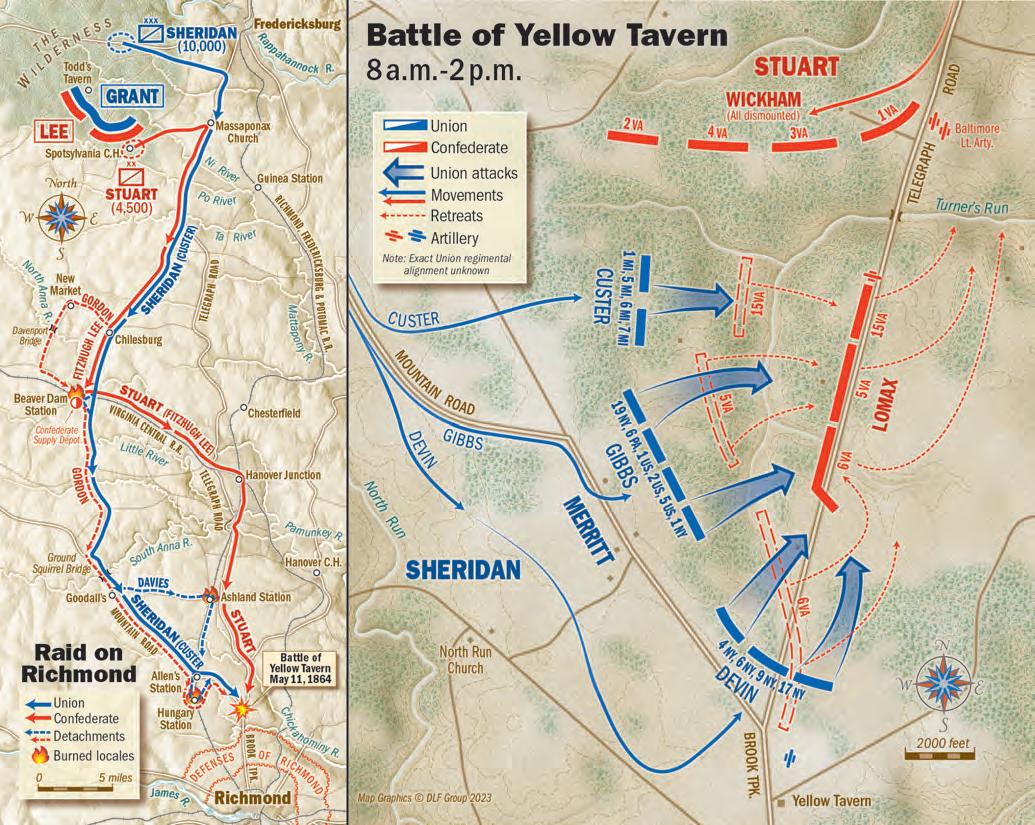
good one,” gloated one Rebel, “with a deep ditch on each side, making an excellent fortification. Here we laid waiting for the enemy.”
First contact occurred in an open field just to the west of where the Mountain and Telegraph roads intersected. The snarl of carbines from the front of the column was soon joined by the increasing clamor from its rear, where Gordon was trying to cross Ground Squirrel Bridge, which had been burned.
Now aware of the Rebel presence along the Ashland Road, Merritt and
Although Devin’s attacking squadrons lost their impetus at the first line of organized resistance, the colonel committed the rest of the 6th New York. His men were suddenly so tantalizingly close, “bells could be heard ringing, locomotives whistling, and general alarm and bustling seemed to prevail in Richmond.”
Dismounting a portion of Gibbs’ and Devin’s brigades, Merritt began to feel out Stuart’s defenses. The Confederate commander had finally inserted Wickham’s Brigade, which moved perpendicularly off the Telegraph Road onto a
38 AMERICA’S CIVIL WAR HERITAGE AUCTIONS (2)
ACWP-230700-YELLOWTAVERN.indd 38 3/15/23 8:57 AM
“bells could be heard ringing, locomotives whistling, and general alarm and bustling seemed to prevail in Richmond”
heavily wooded ridgeline. From this east-west axis, Wickham’s men could fire on the exposed flank of any enemy advancing on Lomax’s position. Stuart himself was out among “the skirmishers, directing their fire, and making his dispositions for the coming battle.”
As Custer’s men arrived on the field, Merritt placed them to Gibbs’ left, covering the Mountain Road’s intersection with the Ashland Road. They were the only part of the command to remain mounted—and would pay the price. The Rebel guns, Custer reported, “concealed from our view by the woods…had obtained perfect range of my position.” Custer’s exposed lines endured a round of heavy fire, and Kidd was convinced that with Merritt and Custer already up with the skirmishers it was going to get only hotter.
The Reserve Brigade made no headway dismounted, and the view from Custer’s side of the line wasn’t much better. A quick survey revealed to him the strong disposition of the Southerners posted on a bluff protruding above a thin stand of trees. Devin swung behind the Reserve Brigade to face north along the Telegraph Road and advanced the 17th Pennsylvania Cavalry through the screening woods on the right.
At Merritt’s command, the 5th and 6th Michigan began their advance, through a maelstrom of bullets, across an open field to a fence line. Stands of timber studded the area, beyond which the Rebel cavalry awaited. Gibbs’ stubborn grind across the field drove Pate’s Virginians from the gully and back to another defensible position on the ridgeline. “Fitzhugh Lee’s sharpshooters were posted in a very strong position indeed,” remembered Kidd.
It helped that Gibbs’ men carried Spencer carbines, and with a hearty yell they began pumping lead from these deadly seven-shot repeaters. The incredible rate of fire soon had the Rebels scrambling back “like a flock of sheep.”
Custer, meanwhile, struck the 15th Virginia
Confederate Trooper’s Finery
Maj. Gen. Fitzhugh Lee, Stuart’s top subordinate at Yellow Tavern, wore this silk sash and these gauntlets during the Army of Northern Virginia’s final cavalry charge April 9, 1864, at Farmville, Va. They were given to him by an unidentified friend—a “Mr. Collie”—in October 1864.

hard, doing so again after a brief Southern rally. In the center, the 5th Virginia struggled to stem the onrush, and when Pate was killed the spirited defense went with him. Pressing forward with his advancing troopers, Merritt noted, “The enemy fought with much desperation...but finally his line was cut.”
Like a sandcastle in the grip of a high tide, the Confederate defenses began to crumble with a series of retreats all along the front. Custer’s Michiganders, however, were not prepared for a sudden volley of fire from Wickham on the left. Custer moved in and restored order, driving the enemy back through and out the woods in front.
The Michiganders faced a ruthless blast of cannon fire and musketry as they exited the woods and were quickly withdrawn by Custer At about 2 p.m., an eerie silence fell over the field. In the lull, the two Michigan regiments began creeping steadily forward. Chapman’s brigade, of Wilson’s division, moved into position to the left of the 6th Michigan, extending the
Well-Equipped
The .52-caliber, seven-shot Spencer Repeating Arms carbine was a game-changer in the war. General Custer’s entire Michigan Brigade was so-equipped at Yellow Tavern, giving his men a decided advantage on J.E.B. Stuart’s troopers.

SUMMER 2023 39 HERITAGE AUCTIONS
(2)
ACWP-230700-YELLOWTAVERN.indd 39 3/15/23 10:37 AM
line and providing needed protection to the much exposed flank.
After a couple of hours, Sheridan decided it was time to press the issue and ordered a mounted charge, to be supported by dismounted troopers. He naturally turned to Custer, who examined the ground and decided that, by keeping well to the right, he could successfully charge the Rebel guns. Informing Merritt of his decision, Custer trotted to the front of his command. On his cue, the band struck up “Yankee Doodle,” the sheer belligerence of the tune serving as a tonic to nerves frayed by the incessant booming of the Confederate guns.
Custer deployed three regiments on the Telegraph Road, his triedand-true 1st Michigan in front, a clear indicator of the gravity of the moment. Despite the very vocal objections of fellow brigade commander, Chapman, Custer had also obtained the services of the 1st Vermont—aided, in fact, by Sheridan’s direct intervention.
Before the charge, Sheridan had ridden onto the field. Kidd was among the first to notice his approach. “As they came opposite the regiment, the officer at the head looked back and saw that the flag was hanging limp around the staff…and said to the color bearer, ‘Shake out those colors so they can be seen.’” Kidd saluted and announced, “Men, General Sheridan,” drawing a rousing cheer. Told of Custer’s plan, Sheridan exclaimed, “Bully for Custer, I’ll wait and see it.”
With Sheridan’s eyes upon him, Custer made his dispositions carefully.
The 5th and 6th Michigan, already dismounted, were to advance against the Rebel left, laying down a wall of fire with their Spencers and pinning down the enemy. To reach the Confederate positions, Custer would have to cross a creek, which, lined with marshy ground, would force him to take his mounted charge across a small bridge. On the enemy side, two pieces of artillery covered the approach, and as Custer’s men
appeared they were met with vigorous fire.
At 4 p.m., the 1st Michigan rode out at a smart trot from the woods it had used for cover. High on the ridge, 1st Lt. Theodore Garnett of Stuart’s staff had a sweeping view of the terrain and had the Baltimore Light Battery unleash shell and canister as soon as the Wolverines appeared.
Needing to funnel into lines of three to cross the Turner’s Run bridge, the Federal troopers withstood repeated blasts of canister at close range, as well as musketry from the 6th Virginia crested on a ridge. The column staggered and reeled before quickly renewing the attack.
There was never a doubt Custer would personally lead the 1st into the hail of bullets and artillery fire. Once over the span, he reformed the command for a continuance of the charge. With his golden locks and red cravat streaming behind him, Custer sabered his way into the Confederate lines, seemingly disappearing in a cloud of dust and battle smoke. Exultant cheers broke forth from the men following his lead.
The 1st Michigan’s surge galvanized the rest of the cavalry line. Elements of Wilson’s division rushed the 2nd and 4th Virginia on Stuart’s right flank, and Devin moved to outflank the remnants of Lomax’s Brigade on the left. As dusk fell over the area, a heavy rain began to pour. One minute it had been clear and the next the Michiganders were soaking wet, their ponchos still strapped to their saddles. The low rumble of thunder served as an ominous background to the thrumming of hooves and the sharp sounds of combat.
Stuart’s troopers began scrambling off the ridge, some seeking a defensive position in a ravine 500 yards to the rear, and two Confederate cannons were captured. That left only the 1st Virginia clustered around Stuart.
Calmly straddling his horse, Stuart watched

40 AMERICA’S CIVIL WAR NIDAY PICTURE LIBRARY/ALAMY STOCK PHOTO
“Go back! Go back!
And do your duty, as I have done mine, and our country will be safe”
ACWP-230700-YELLOWTAVERN.indd 40 3/15/23 8:58 AM
—J.E.B. Stuart
the 1st Michigan closing in and began blasting away at the enemy troopers with his famed LeMat revolver. Suddenly, in the murderous swirl of the mêlée, the meaty thwack of a bullet hitting flesh was heard and Stuart staggered from what turned out to be a mortal wound. Even as he was carried off the field, the commander exhorted his retreating troops to rally: “Go back! Go back! And do your duty, as I have done mine, and our country will be safe. Go back! Go back! I had rather die than be whipped.”
Fitzhugh Lee assumed command, but, conceding the hopelessness of the situation, ordered Wickham to pull out, handing Custer and Chapman possession of the ridge. Sitting astride his horse at the top of the hill, his faced flushed with joy, Custer asked the 7th Michigan to administer a coup de grâce. Pointing his saber toward the road at the base of the hill, he ordered Major Henry Granger to charge.” The 7th struck like a thunderbolt, forcing another Confederate retreat. Granger would fall, however, struck by three bullets and killed instantly.
Sheridan praised Custer in his report, calling the charge “brilliantly executed.” It had been a tactically flawless operation, for by this time the brigade had mastered the one-two punch of dis-
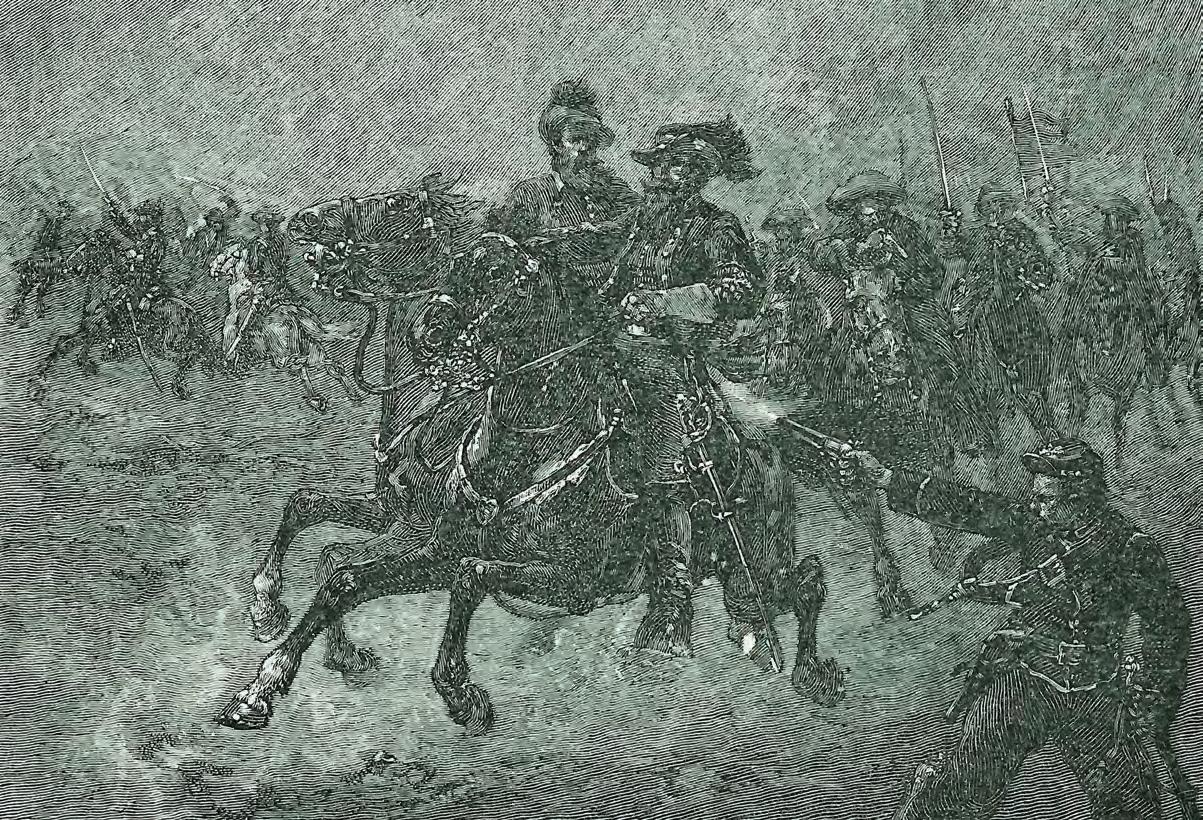
Denouement

The particulars of J.E.B. Stuart’s mortal wounding remain in dispute. Dismounted trooper John A. Huff of the 5th Michigan usually gets credit for firing the fatal shot, but Huff, killed at Haw’s Shop a few weeks later, could never claim so for the record.
mounted troopers keeping the Rebels occupied in front while Custer led the rest of the brigade in a mounted attack.
James Wilson, however, took umbrage at Custer’s Yellow Tavern report, sneering, “While my men were pressing the enemy Custer halted to gather up the spoils and to sound pæans of victory.” Reading the newspaper accounts, Wilson groused, it seemed as if “Custer’s brigade did all the fighting and was entitled to all the credit.”
Wilson was quick to laud the actions of his own command, and especially praised the part played by “the modest Chapman,” whom he felt was not given his full share of the credit for the success. Wilson’s opinion was shared by others, among them the regimental historian of the 1st New York Dragoons. Scathingly, he wrote for posterity, “Custer was a brave fighter, as were also his splendid Michigan brigade….That he bore the brunt of the fighting, and drove the enemy from the field, is an unwarranted stretching of the truth. He did his part well, and so did the others.”
Adolfo Ovies, who migrated to the United States from Cuba in June 1960, fell in love with the Civil War on his first visit to Gettysburg as a 10-yearold. With an affinity for George Armstrong Custer, he is the author of Crossed Sabers (2004) and an earlier volume of a planned trilogy, The Boy Generals: George Custer, Wesley Merritt, and the Cavalry of the Army of the Potomac (2021). He resides in Miami, Fla.
SUMMER 2023 41 NIDAY PICTURE LIBRARY/ALAMY STOCK PHOTO
ACWP-230700-YELLOWTAVERN.indd 41 3/15/23 8:58 AM
Home FrOnt hEroes
PART 2

Our continuing look at wartime civilians who never quite got the recognition they deserved
Community Efforts
Citizens on a street in Richmond, Va., take time to help wounded soldiers after the 1862 Battle of Seven Pines— a scene that would play out in communities across the country throughout four years of fractious civil war.

OPPOSITE: LEBRECHT MUSIC & ARTS/ALAMY STOCK PHOTO; THIS PAGE, RIGHT: HISTORYNET ARCHIVE; BELOW: NATIONAL GALLERY OF ART
ACWP-230700-12CIVILIANS.indd 42 3/15/23 8:36 AM
In our November 2021 issue, we introduced a two-part series dedicated to the remarkable but typically overlooked Civil War accomplishments of 12 civilians on both sides of the Mason-Dixon Line. The first part of the series running in that issue featured a lineup that included, among others, a former-slaveturned-seamstress; a uniform manufacturer; a photographer who wielded his camera for interests on both sides of the conflict; a wily diplomat; and a Catholic priest with Confederate loyalties and an astonishing knack for writing poems. Part 2 of our series highlights the Herculean wartime efforts of 12 more of these average citizens, from a housewife who overcame balancing motherhood and mercantile demands, to a journalist who traversed roughly 900 miles following the Army of the Potomac during the Gettysburg Campaign, to teenage girls instrumental in a pair of resounding Confederate victories. Regardless of where these individuals’ sympathies lay, or their age or vocation, it is fitting that we acknowledge their deeds.
Elizabeth Caroline Butler (1837–1911)
Born in Autaugaville, Ala., on October 7, 1837, Elizabeth Butler had, as a young girl, traveled west with her parents, extended family, and neighbors. At 18, she married Allan T. Daniel in Lauderdale County, Miss., and the following year gave birth to a daughter, Nancy. While pregnant with her second child—a son they would name Henry—Elizabeth traveled with her husband to the community of Eutaw in Limestone County, Texas, where he began working as a farmer and rancher. In early 1860, she would be blessed with twin boys, George and William.
Having to take care of four small children and managing the day-to-day struggles on the frontier was demanding enough, but Elizabeth was about to experience even more discord with the untimely death of her husband that April. The death of a spouse on the frontier was a common occurrence, of course, and Elizabeth did what many such widows did and remarried, this time to dry goods merchant and postal worker Isaac Ellison, nine years her senior.
To defend the Lone Star State’s interests during the war, Texans enlisted in droves at their county seats. Younger, unmarried men were usually the first to go, but Isaac was eventually among those called to duty. In his absence, Elizabeth strove to keep the dry goods store and post office running, while continuing to juggle being a full-time parent.
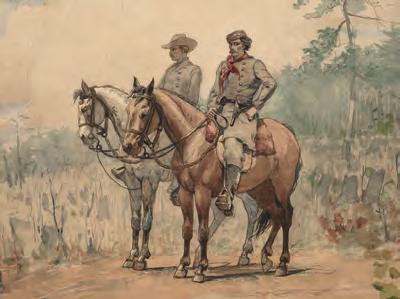
Solemn, Sturdy
Elizabeth poses with twin sons from her first marriage, likely in 1860. Below: Isaac Ellison, her second husband, fought in the Trans-Mississippi with a Texas cavalry unit, like the men shown here.

She had no respite in managing these commitments, and it didn’t help that money was difficult to come by. At this time, each Texas county issued its own paper currency. As the war progressed, Eutaw alternated within the jurisdiction of three counties: Limestone, Falls, and Robertson. County money soon became more worthless than regular Texas and Confederate script, leading to economic collapse.
As it did for communities and states across the country, four years of war decimated Texas’ male population. Having fought predominantly in Colonel James B. Likens’ Bloody 35th Texas Cavalry, Isaac would be one Lone Star boy fortunate enough to return home. —William Joseph Bozic
SUMMER 2023 43 OPPOSITE: LEBRECHT MUSIC & ARTS/ALAMY STOCK PHOTO; THIS PAGE, RIGHT: HISTORYNET ARCHIVE; BELOW: NATIONAL GALLERY OF ART
ACWP-230700-12CIVILIANS.indd 43 3/15/23 8:37 AM
Charles Carleton Coffin (1823–1896)

While writing for The Boston Journal during the Civil War, Charles Carleton Coffin was told by his editor to always “keep the Journal at the front.” In that, Coffin succeeded. Based in Washington, D.C., he first made a name for himself traveling into the field with what became the Army of the Potomac. His coverage of the Union army’s retreat at the First Battle of Bull Run, in fact, remains his most extensively quoted piece.
At Fredericksburg in December 1862, a Union soldier expressed amazement at seeing “Carleton” beneath a tree under fire, still writing away. The following spring and summer, Coffin followed the Union army to Gettysburg and ended up traveling 100 miles on horseback and 800 more by train to get accounts to the Journal’s readers.
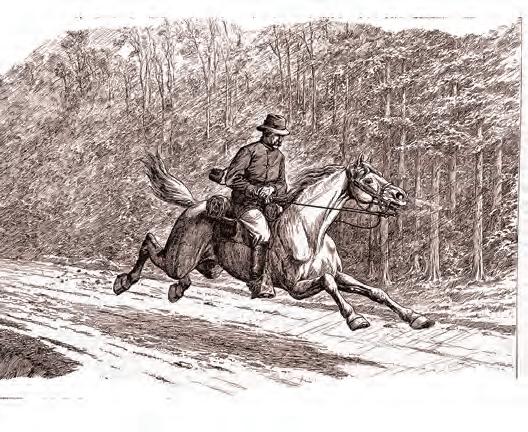
Deadline Drive
During the Battle of the Wilderness in May 1864, Coffin had his nephew hurry his account to the presses in Washington. Ride as fast as you can, he urged; just don’t kill the horse. “If he is behind, his occupation is gone,” Coffin told his fellow war reporters (“specials,” as they were called). The “account must be the first, or among the first, or it is nothing.” If a reporter were to miss the mail or the train, he observed, “he might as well put his pencil in his pocket and go home.”
Journalist Charles
Carleton Coffin of The Boston Journal quickly learned—as did his fellow war correspondents—that while in the field his office was often in the saddle.
Coffin was one of more than 300 Northern correspondents to cover the war, earning about $25 a week. He shared with his colleagues a common set of vexations, such as the horse-stealing that frequently bedeviled field correspondents. On several occasions, Coffin’s servant greeted him in the morning, “Breakfast is ready, Mr. Coffin. Your horse is gone again.”
It is no surprise that Coffin’s name has a prominent place among Northern reporters inscribed on the War Correspondents Memorial Arch at Maryland’s Gathland State Park near Burkittsville.
—Stephen Davis
Peter Bauduy Garesché (1822–1868)
The authors of the 2007 book Never for Want of Powder make a compelling case that the Augusta (Ga.) Powder Works and its creator, Colonel George W. Rains, were instrumental to the Confederate Army’s survival as the war endured. Rains, however, had a counterpart in the Confederate Navy who shouldn’t be overlooked: Peter Bauduy Garesché.
Garesché’s father and uncle were French emigres who owned and operated a gunpowder mill in Wilmington, Del. The family were business partners of and relatives by marriage to the DuPonts of Wilmington’s famed DuPont Powder Mill family. Peter worked with his father in the mills as a youngster but eventually embarked on a career as a lawyer in St. Louis.
Powder Fresh
Under Garesché, the Columbia Naval Powder Works thrived. That ended when South Carolina’s capital city was torched in February 1865 (opposite).
The Civil War divided the Garesché family. Peter’s cousin and close friend Julius Garesché, a fellow classmate at Georgetown University and a West Point graduate, remained loyal to the Union. Although Peter was a Southern sympathizer, he was not a secessionist, according to family sources. But when ordered to take a loyalty oath, he went south.

It helped also that he had strong Confederate contacts—General Joseph E. Johnston was his brother-in-law—and when the

44 AMERICA’S CIVIL WAR FROM TOP: DIGITAL COMMONWEALTH, BOSTON PUBLIC LIBRARY; MOUSEION ARCHIVES/ ALAMY STOCK PHOTO; HISTORYNET ARCHIVE FROM TOP: SMITHSONIAN AMERICAN ART MUSEUM, SMITHSONIAN INSTITUTION; ARCHIVES OF THE DIOCESE OF SHREVEPORT; NIDAY PICTURE LIBRARY/ALAMY STOCK PHOTO
ACWP-230700-12CIVILIANS.indd 44 3/15/23 8:37 AM
Mother Mary Hyacinth (1816–1897)
In 1855, 39-year-old Madeline LeConniat, better known as Mother Mary Hyacinth, traveled to central Louisiana from her native France to open a convent and school along with nine other Daughters of the Cross. Louisiana would prove a harsh climate for her, often leaving her under the weather. The mosquitoes, she wrote, “[besiege] me continually because my blood which still smells European attracts them.” A lack of conversational English also hindered her local relations.

The Civil War increased already hard times with inflated pricing. Food and other supplies were in short supply, causing tense conditions for the nuns, students, and refugees alike. Troops from both sides constantly passed through the area, putting demands on their meager supplies.
The worst came during the Battle of Mansura on May 16, 1864, a contest featuring an artillery duel in which stray shots damaged the convent’s structures. In addition, soldiers looted the rations of the nuns and their wards. Relentlessly, Mother Hyacinth secured donations from the area’s residents to keep matters operating smoothly. She fervently kept the school running and still offered shelter to displaced individuals and families.
Divine Care
Top: A Catholic nun prays with a patient. Mother Mary Hyacinth (right) protected her own patients by secreting them in an oven until the artillery duel ended.

After the war, Mother Hyacinth continued to serve the convent and the neighborhood until 1867 when the motherhood discontinued its support of the Louisiana mission. Two years later, Mother Hyacinth was reelected mother superior and called back to Louisiana. She continued her community work without the support of the French motherhouse.
In 1882, at age 65, Mother Hyacinth returned to France to run the American novitiate until her death in 1897 at age 81. The Daughters of the Cross continued to operate schools throughout Louisiana into the next century, capitalizing on the sterling examples set by Mother Mary Hyacinth.
 —Edward Windsor
—Edward Windsor
Confederate Navy was looking for someone to run its newly created powder works in Columbia, S.C., Garesché was chosen. It was a prescient decision.
Garesché was applauded for conducting the Columbia Naval Powder Works with “singular skill and commensurate results,” and for supplying the Southern Navy with gunpowder “of excellent quality.” Union Lt. Gen. Ulysses S. Grant, who had known Peter while both were in St. Louis, purportedly told a friend: “I would, if I caught him, keep him close and not exchange him for 10,000 men. The powder he manufactures for the South is so superior to ours.”
After the war, Garesché resumed his law practice in St. Louis. He died in 1868.
 —Bruce Allardice
—Bruce Allardice
SUMMER 2023 45 FROM TOP: DIGITAL COMMONWEALTH, BOSTON PUBLIC LIBRARY; MOUSEION ARCHIVES/ ALAMY STOCK PHOTO; HISTORYNET ARCHIVE FROM TOP: SMITHSONIAN AMERICAN ART MUSEUM, SMITHSONIAN INSTITUTION; ARCHIVES OF THE DIOCESE OF SHREVEPORT; NIDAY PICTURE LIBRARY/ALAMY STOCK PHOTO
ACWP-230700-12CIVILIANS.indd 45 3/15/23 8:37 AM
Martin Jackson (unknown)
As the Battle of Pleasant Hill, La., raged on April 9, 1864, Colonel Augustus Buchel of the 1st Texas Cavalry dismounted his troops and ordered them to attack the Federal infantry. Remaining on horseback, however, Buchel was an easy target and soon fell mortally wounded with seven injuries.

Two days later, Buchel died in the arms of a 17-year-old slave named Martin Jackson, a self-described “black Texan,” who lamented: “I had pitched up a kind of first-aid station. I remember standing there and thinking the South didn’t have a chance. All of a sudden I heard someone call. It was a soldier, who was half carrying Col. Buchel in. I [couldn’t] do nothing for the Colonel. He was too far gone. I just held him comfortable and that was the position he was in when he stopped breathing. He was a friend of mine.”

Martin and his father had followed their owner, Alva Fitzpatrick, to war to serve as cooks. Martin was also a stretcher-bearer, which he referred to as “an official lugger-in of men that got wounded.” Although Martin conceded, “I knew the Yanks were going to win from the beginning. I wanted them to win and lick us Southerners,” he also “hoped they was going to do it without wiping out my company.”
He remained fiercely loyal to the men of the 1st Texas throughout the war, continuing to cook for the men and tend the wounded. After the war, he was freed, became a cowboy, married, and eventually had 15 children. He even served as a cook in World War I, proudly claiming he never donned a uniform in either conflict. Martin’s one regret during the war—he started the deadly 75-year habit of smoking tobacco. —Fran Cohen
Cyrus Hall McCormick (1809–1884)

Cyrus Hall McCormick, one of the United States’ great early industrialists, founded the McCormick Harvesting Machine Company in Chicago in 1847. Although he was merely one of several entrepreneurs to invent a mechanical reaper, his company’s Chicago home, as well as his family’s business acumen, quickly made his version the nation’s most successful and widely used harvester, critically helping open the Midwest and Great Plains to family farmers in the decade leading up to the Civil War.
Born February 15, 1809, in Virginia’s Shenandoah Valley, McCormick was the eldest of eight children raised by Robert McCormick Jr. and Mary Ann Hall. Robert McCormick had attempted to design and build a mechanical reaper of his own during Cyrus’ youth, but it proved not to be a sturdy, reliable model. Building upon his father’s failures, as well as an unpatented successful version by Scottish inventor Patrick Bell, Cyrus succeeded in constructing a reliable reaper in 1831. He continued working on improving this model and finally received his first patent in 1834
Two years after Cyrus established the McCormick Harvesting Machine

FROM TOP: BRIGHAM YOUNG UNIVERSITY; MINNESOTA HISTORICAL SOCIETY; THE PRINT COLLECTOR/ALAMY STOCK PHOTO FROM TOP: LIBRARY OF CONGRESS (2); SCIENCE HISTORY IMAGES/ALAMY STOCK PHOTO 46 AMERICA’S CIVIL WAR
Proud Texan
ACWP-230700-12CIVILIANS.indd 46 3/15/23 8:37 AM
The above photo of Martin Jackson, his age unknown, was taken in June 1937. Jackson first made his mark at the Battle of Pleasant Hill (left).
John Other Day (1819-1869)
“When I gave up the war path and commenced working the earth for a living, I discarded all my former habits,” John Other Day once wrote. “It was very hard for me to learn the white man’s ways, but I was determined to get my living by cultivating the land and raising stock.”
Born Ampatutokacha (i.e., Good Sounding Voice) in 1819, Other Day had been a fierce warrior in his youth, but his conversion to Christianity led him to join an association of “farmer Indians” in 1856. The following year, Other Day assisted in the rescue of a young female captive, and in 1859 he was nominated to a treaty delegation sent to Washington, D.C. While on that trip, he met an English woman working at his hotel whom he later wed.
On August 18, 1862, Dakota Indians, upset with living conditions on their federal reservation in Minnesota, killed several settlers and traders during an armed attack on the Lower Sioux Agency, igniting the 39-day Dakota War of 1862. Other Day hurriedly gathered up 62 settlers (men, women, and children alike) and secured them in an Agency building overnight, personally standing guard at the door. Early the next morning, he guided the group on an arduous, three-day trek across the Minnesota River and through a prairie to safety in St. Paul, where he was welcomed as a hero. Wanting to further assist his new community, Other Day volunteered as a civilian scout for the U.S. troops assembled to combat the hostile Indians, often fighting side by side with his newfound comrades.

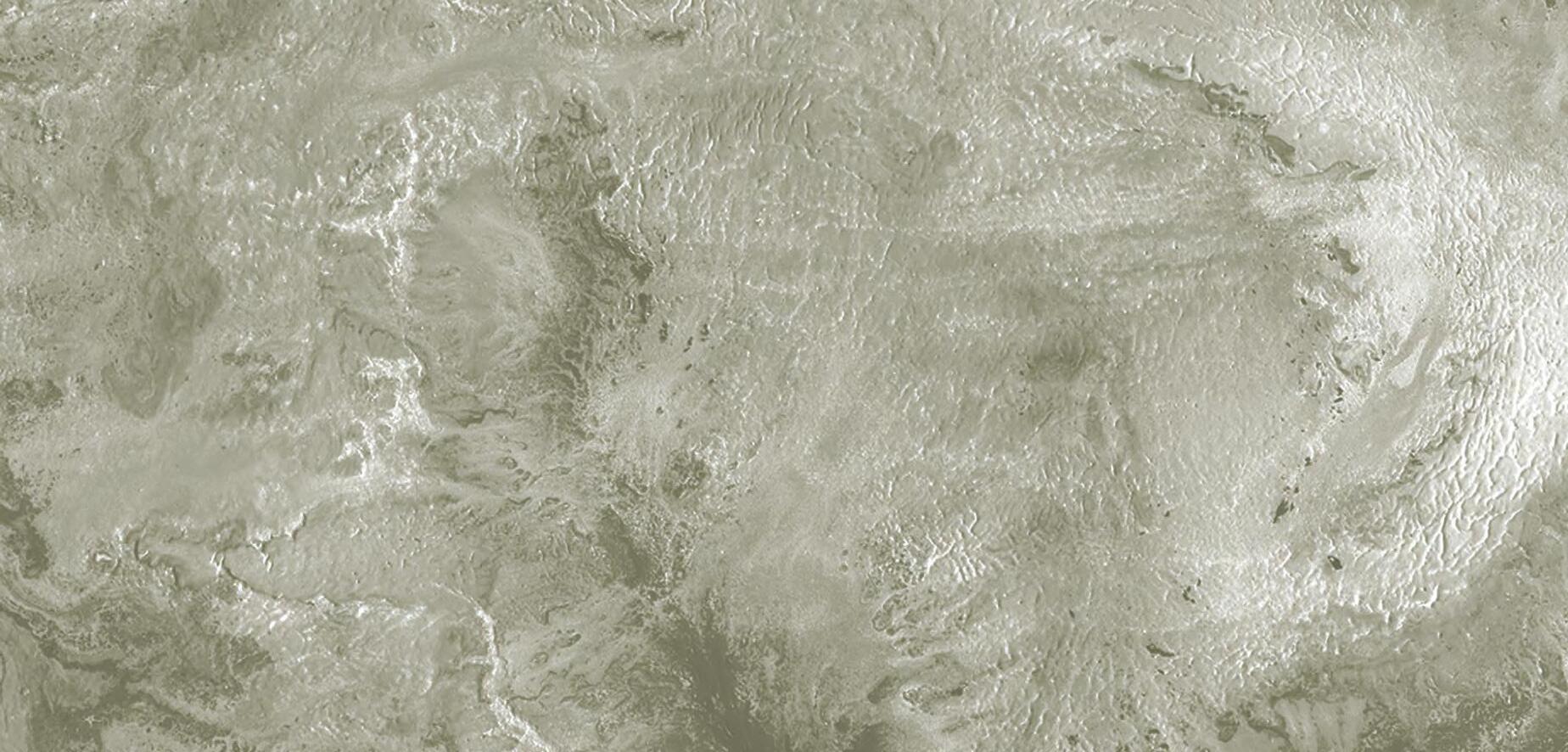
The U.S. government awarded Other Day $2,500 for his heroism. He bought a farm in Henderson, Minn., but later sold it and moved to the Dakota Territory. He would die of tuberculosis on October 19, 1869, at the Fort Wadsworth hospital in what became the state of South Dakota 20 years later. —Richard
 H. Holloway
H. Holloway
Company with one of his brothers, Leander, another brother—William—joined them in Chicago. William’s business insight and Cyrus’ skilled salesmanship helped the company flourish.
Cyrus, however, suffered a stroke in 1880 and spent the last four years of his life as an invalid before passing away in Chicago on May 13, 1884. In 1902, the McCormick Harvesting Machine Company was absorbed into the International Harvester Company.
—Terry Beckenbaugh
Field Growth
By reducing the number of laborers required to collect crops, the harvesting machine that Cyrus McCormick (opposite) invented greatly increased productivity for the nation’s farmers.

FROM TOP: BRIGHAM YOUNG UNIVERSITY; MINNESOTA HISTORICAL SOCIETY; THE PRINT COLLECTOR/ALAMY STOCK PHOTO FROM TOP: LIBRARY OF CONGRESS (2); SCIENCE HISTORY IMAGES/ALAMY STOCK PHOTO SUMMER 2023 47
Call to Arms
ACWP-230700-12CIVILIANS.indd 47 3/15/23 8:38 AM
Sioux warriors attack at New Ulm, Minn., opening the 1862 Dakota War. Other Day (below) earlier traded a warrior life for farming.
Helping Hands
Phoebe Levy Pember (1823–1913)
In April 1861, there was no reason to expect Phoebe Levy Pember would leave the mark on the Civil War that she did. Born into a prominent Jewish family in Charleston, S.C., she had spent the antebellum years in relative comfort, the well-off wife of a gentile, Thomas Noyes Pember, whom she married in 1856. As the nation formally began its split, however, her husband contracted tuberculosis, and she was widowed three months into the war. With no children and few career options, she relented to residing with her parents in Marietta, Ga. There she struggled, directionless and frequently at odds with her father.
That changed in November 1862 when Pember received an offer from the wife of Confederate Secretary of War George Randolph to move to Richmond to become “matron” of the capital city’s Chimborazo Hospital. Despite no previous nursing experience, Pember proved a providential choice for the position. According to the “Jewish Women’s Archive,” she “oversaw nursing operations as well as housekeeping and food and maintained a friendly but firm authority, loved for her feminine charms and her dedication to her patients.” That did not prevent her from pulling a gun on a hospital worker trying to pilfer whiskey from the hospital’s supplies.
Pember remained as Chimborazo’s first appointed female administrator until Richmond fell in April 1865. In 1879, she penned the book A Southern Woman’s Story: Life in Confederate Richmond, and in 1995 the U.S. Postal Service honored her with a stamp, featuring a painting of Pember feeding one of her patients chicken soup.

As historian James Robertson Jr. remembered: “Mrs. Pember was an aristocrat who developed a deep affection for the common soldiers and the class from which they came. She lived to be 89, but nothing in her life matched the three years of devoted service she gave to the human debris of war. Her only memorial were the looks of thankfulness that came from suffering soldiers who stretched out a hand for help—and found Phoebe Pember.” —Gregg Phillipson
Emma Sansom Johnson (1847–1900)
The Yankees were several miles ahead, with Nathan Bedford Forrest in earnest pursuit. A deep stream blocked the way, however. Where could he cross—and who would show the way?

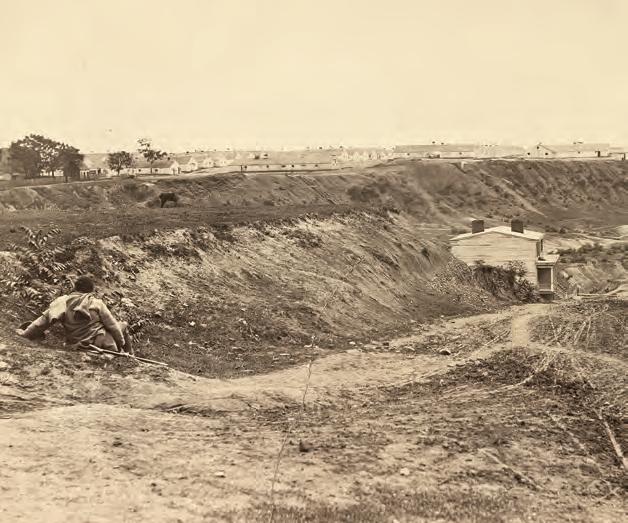

It was late April 1863, and a 2,000-man mounted column under Colonel Abel Streight had ridden to northwest Alabama to wreck as many Confederate railroads as possible. On the morning of May 2, the Federals burned the bridge across Black Creek, north of Gadsden, Ala., believing it would stall Forrest long enough for them to get away.
The “Wizard of the Saddle” wasn’t stymied, though. A local girl, 16-year-old Emma Sansom, knew of a
FROM TOP: THE VALENTINE, RICHMOND; PEREGRINE/ALAMY STOCK PHOTO; TO THE LOST FORD BY
PAUL STRAIN FROM TOP: JOE HOLLEY/HOUSTON CHRONICLE; TEXAS STATE HISTORICAL ASSOCIATION; ALABAMA DEPARTMENT OF ARCHIVES AND HISTORY
JOHN
ACWP-230700-12CIVILIANS.indd 48 3/15/23 8:38 AM
With 7,000 beds, Chimborazo Hospital was the South’s largest during the war. Below: The USPS honored Pember’s service with this stamp in 1995.
In Cold Blood
Treǔe der Union (“Loyalty to the Union”) is inscribed on this memorial to the Texas Unionists killed at the August 1862 Massacre on the Nueces, in which Tegener (left) was wounded but managed to escape.
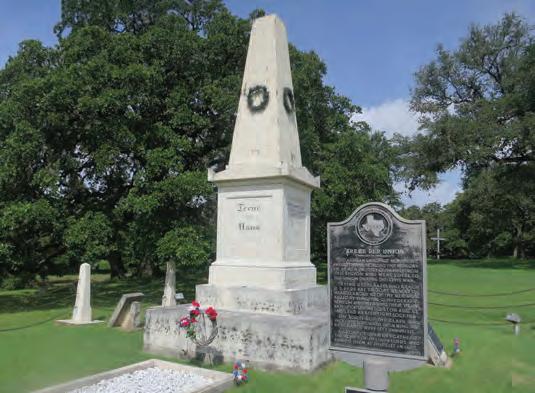
Fritz Tegener (1813–unknown)
A Prussian immigrant, Fritz Tegener lived in the Texas Hill Country town of Comfort, a community started by recent German immigrants embroiled in the political unrest of the Revolutions of 1848 in Europe. Few German Texans owned slaves, and the people of Comfort were openly opposed to secession when the Civil War began, unwilling to participate in another such conflict.
Before the war, Tegener had been politically active in Comfort, serving as a jurist and county treasurer. That would continue during the Civil War. To protect the community from both Indian raids and the Confederacy, Tegener and other residents formed what was called the Union Loyal League.

After the Conscription Act of 1862 passed, Confederate soldiers began harassing the German Texans to join the Army, spurring more than 60 to organize a group that would travel south to Mexico to avoid conscription and appointing Tegener their leader. The ensemble departed in the summer of 1862, pursued by 94 Confederates as it traversed the rugged terrain of southwest Texas.
On August 10, 1862, the Confederates caught the Germans on the banks of the Nueces River and a battle ensued, known as the Massacre on the Nueces, in which 19 Unionists were killed and nine, too injured to escape, left behind and captured. Confederates executed their prisoners and left all 28 bodies unburied.
Though wounded, Tegener escaped and led the remaining Germans to Mexico, only to be ambushed by another Confederate group while crossing the Rio Grande. Eight more died.
Tegener spent the rest of the war in Mexico, but returned home afterward. Later, women of Comfort collected the sun-bleached bones from the battlefield and buried them under the only German language monument dedicated to the Union in the South named Treǔe der Union (Loyalty to the Union). Tegener risked his life to defend his political beliefs and find refuge for young German men of the Texas Hill Country. —Charles
 Grear
Grear
nearby ford. Forrest eagerly hoisted her onto his saddle as she pointed the way. After crossing the creek, the Confederates chased Streight and his troopers so determinedly that he surrendered his command the next day.
Forrest was quick to credit the lass with his success, writing her a note of thanks from his “Hed Quarters in Sadle.” Emma quickly became a local heroine. She married the next year, and after the war moved to Texas, where she died in 1900.
Seven years later, Gadsden residents unveiled a statue to her that, despite recent discussions of taking it down, remains standing—with Emma’s right arm held aloft, her index finger pointing of course to that famed Black Creek ford. —John
Gordon
One Way
Opposite: Emma Sansom points Maj. Gen. Nathan Bedford Forrest in the right direction across Black Creek, near Gadsen, Ala., where a grand memorial to Sansom (right) was erected in 1906. She later married a wounded soldier, Charles B. Johnson, and the couple would relocate to Texas.

SUMMER 2023 49 FROM TOP: THE VALENTINE, RICHMOND; PEREGRINE/ALAMY STOCK PHOTO; TO THE LOST FORD BY JOHN PAUL STRAIN FROM TOP: JOE HOLLEY/HOUSTON CHRONICLE; TEXAS STATE HISTORICAL ASSOCIATION; ALABAMA DEPARTMENT OF ARCHIVES AND HISTORY
ACWP-230700-12CIVILIANS.indd 49 3/15/23 8:39 AM
Beyond the Call
The Thompson’s Station train depot (above) still stands. During the battle that broke out near here in March 1863, teenager Alice Thompson (right) rallied the Rebels by hoisting a 3rd Arkansas flag above her head. That flag featured the unique Van Dorn design, as shown below on the 4th Missouri’s regimental banner.
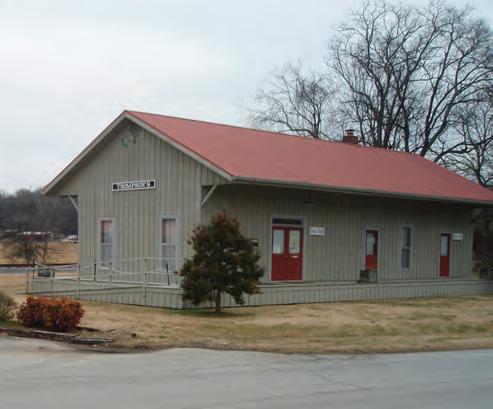
Alice Thompson (1846–1869)
The ferocity of conflict often leads one to accomplish the unexpected. During the Battle of Thompson’s Station, Tenn., on March 5, 1863, teenager Alice Thompson—a progeny of the settlement’s namesake—made a splitsecond decision that helped change the course of an eventual Confederate victory.

Life had begun as usual that late-winter day, but Alice soon found herself caught in the midst of a desperate fray. Serving as Confederate physicians, Alice’s father as well as her beau remained near the front. She meanwhile fled her home, seeking protection for the rest of her family and finding refuge in the cellar of a neighbor, Confederate Lieutenant Thomas Banks. From the basement windows, she was able to catch glimpses of the conflict.
As the fighting intensified, Alice confronted a decisive moment. Having watched repeated Union advances and Confederate counterattacks, she became distressed watching a Southern flag-bearer fall to the ground. Forsaking her safety, Alice scrambled from the hiding place and made her way to the fallen soldier, grabbing the regimental colors—those of the 3rd Arkansas Cavalry—he had been carrying. Proudly holding the colors high, she drew the attention of Confederate troops, who were inspired by the recklessly courageous undertaking and rallied to push the Yankees back. Even with shells exploding around her, Alice reportedly never flinched as the Confederates advanced. Retreating Union troops were among those who admired her incredible bravery.

Finally, others concerned for Alice’s well-being pulled her back to the cellar. Her heroics did not end there, however. With Banks’ house serving as a hospital, she helped tend the wounded.
only 23, but her
Contributors
Dr. Bruce Allardice, author of the “Loose Lips” feature article in ACW’s Spring 2023 issue, teaches history at Illinois’ South Suburban College. He has co-authored several books
and articles on the Civil War and on the history of baseball.
Dr. Terry Beckenbaugh is an associate professor of history in the Department of Joint Warfare at U.S. Air Force Command and Staff College, Maxwell Air Force Base, Montgomery, Ala. He is
working on a book on the 1862 White River Campaign in Arkansas.

Gordon Berg, who writes from Gaithersburg, Md., is a longtime contributor to America’s Civil War, Civil War Times, and other HistoryNet publications.
William Joseph Bozic Jr., a retired Texas high school social studies teacher, works for the National Park Service in San Antonio. He is married with four children.
Fran Cohen, a freelance author specializing in history , writes from Little Rock, Ark.
50 AMERICA’S CIVIL WAR HAVERFORD COLLEGE QUAKER & SPECIAL COLLECTIONS (2) FROM TOP: ICHABOD, CC BY-SA 3.0; HISTORYNET ARCHIVE; AMERICAN CIVIL WAR MUSEUM, RICHMOND
Alice Thompson died in 1869,
gallantry at Thompson’s Station secured her place in Civil War history and memory. —Heidi Weber
ACWP-230700-12CIVILIANS.indd 50 3/15/23 8:39 AM
Julia Wilbur (1815–1895)

Julia Wilbur’s life easily could have slipped into historical anonymity. After years of a rather conventional rural life of teaching school and tending to the needs and wants of various members of a large and extended family, the spirited and socially aware Wilbur found herself caught up in the evangelical spirit burning through western New York. Residing in the environs of Rochester brought her into contact with prominent abolitionists and social reformers who, in the decades prior to the Civil War, advocated various forms of social and political change. Becoming a member of the Rochester Ladies’ Anti-Slavery Society (RLASS) in 1852 probably rescued Wilbur from the life of an unassuming spinster and transformed her, at age 47, into an energetic social activist just as the nation was slipping into secession and war.
Determined to do more than darn socks and send food packages to the local boys in the Union Army, Wilbur traveled to Washington, D.C., as a representative of the RLASS. At first, she was armed with nothing more than a few general letters of introduction and a heart full of grit and compassion. After arriving on October 28, 1862, she was sent to Alexandria, Va., to do what she could to provide aid and comfort to the thousands of contrabands streaming into the Union-held city.
Nothing had prepared her for the sights, sounds, and, yes, smells she encountered. An entry in her diary described conditions she found upon her arrival: “Went to old School House. 150 C’s [contrabands] there. A large house for sick nearby. We went there, people in filth & rags—a dead child lay wrapped in piece of ticking—in another room, a dead child behind the door. Oh what sights! What Misery! No doctor— no medicines—only rations & Shelter.”

Along with her better-known friend—former slave and abolitionist Harriet Jacobs—Wilbur often encountered stubborn military bureaucracies, unfriendly local citizens, and various disorganized benevolent associations during her unrelenting fight against hunger, disease, and death. For the remainder of the war, Wilbur set about to change the dreadful conditions she found there.
Wilbur lived in Washington after the war and worked as a clerk in the Patent Office from 1869 to 1895, a harbinger of the thousands of women who would follow her into government employment. She remained active in social causes such as voting rights for women. She died on June 6, 1895, and is buried in the family plot in Avon, N.Y. —Gordon Berg
Cherished Thoughts
Julia Wilbur tirelessly kept a personal diary during the war. A preserved page from that diary, dated April 21, 1864, is shown here.
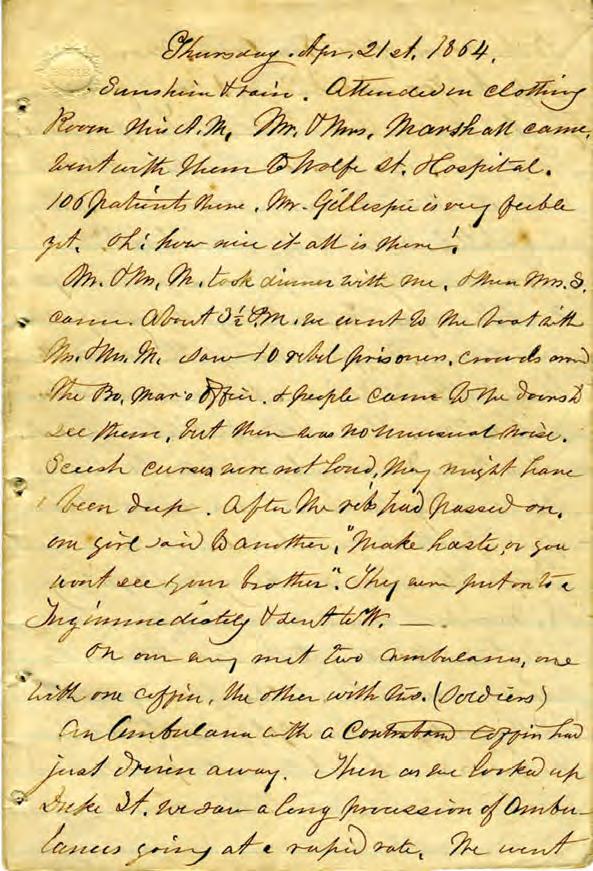
Stephen Davis, who specializes in Southern Civil War history, writes from Cumming, Ga.
John Gordon is a freelance author based in Wetumpka, Ala.
Dr. Charles Grear, professor
of history at Central Texas College, writes extensively on Texas and the Civil War. He is the author of Why Texans Fought in the Civil War.
Richard H. Holloway, a member of ACW’s editorial advisory board, is a historian who hails from Louisiana.
Gregg Phillipson is a former member of the Texas Holocaust Commission, well known for loaning his large collection of Jewish war memorabilia to museums across Texas. A resident of Austin, he also frequently delivers presentations about Jewish military history.
Dr. Heidi Weber is an associate professor in the SUNY–Orange Department of Global Studies, with specialties in U.S. history, the Civil War, and Reconstruction.
Edward Windsor, a retired historian and newspaperman, writes from Corinth, Miss.
SUMMER 2023 51 HAVERFORD COLLEGE QUAKER & SPECIAL COLLECTIONS (2) FROM TOP: ICHABOD, CC BY-SA 3.0; HISTORYNET ARCHIVE; AMERICAN CIVIL WAR MUSEUM, RICHMOND
ACWP-230700-12CIVILIANS.indd 51 3/15/23 8:39 AM
Philippi, W.Va.
Off to the Races
Trailside is produced in partnership with Civil War Trails Inc., which connects visitors to lesserknown sites and allows them to follow in the footsteps of the great campaigns. Civil War Trails has more than 1,400 sites across six states and produces more than a dozen maps. Visit civilwartrails.org and check in at your favorite sign #civilwartrails.
TREAD THE GROUND THAT HOSTED THE FIRST LAND BATTLE OF THE CIVIL WAR
Nestled in the mountains of West Virginia, this sleepy historic town erupts with the roar of cannon fire and the steady beat of marching brogans down Main Street every June as it hosts its annual Blue & Gray Reunion. The festivities commemorate the June 3, 1861, battle that broke out here as two columns of Union forces, about 3,000 men, arrived from Grafton under the command of Colonel Ebenezer Dumont and Colonel Benjamin Kelley. A predawn assault was planned to begin on the mark of a pistol shot from the Union command.

Confederate sympathizer Matilda Humphreys, spying the incoming troops from her hillside home, sent her son Newton to warn Confederate troops camped in town. When Union soldiers captured him, she fired a pistol at them. The single shot was mistaken for the battle signal and Union
artillery rained fire on the town. The battle had begun.
Inexperienced Confederate volunteers had failed to establish picket lines for security, and many were asleep when the cannons went off. Those who were armed fired shots back, but the Confederate troops quickly fled in retreat. Union journalists dubbed the battle the “Races at Philippi.”
Visit the town every summer for its annual commemoration of the Battle of Philippi, including reenactments, a parade, and living history. Fear not if you can’t make it for the event. Battle artifacts and relics are on display at the town’s history museum, which also houses some unique exhibits related to noted Philippi residents. Civil War Trails signs line Main Street, providing visitors a walking tour of the battle and its aftermath. —Melissa
A. Winn
52 AMERICA’S CIVIL WAR TRAILSIDE CLOCKWISE FROM LEFT: PHOTOS BY MELISSA A. WINN (3); COURTESY OF CRAZY CROW TRADING POST BACKYARD PRODUCTIONS/ALAMY STOCK PHOTO
ACWP-230700-TRAILSIDE.indd 52 3/14/23 4:31 PM
County Seat
The Union victory in Philippi propelled the young Maj. Gen. George B. McClellan into the national spotlight, and he was soon given command of all Union armies. The battle also inspired more vocal protests in the western part of Virginia against secession. A few days later in Wheeling, the Wheeling Convention nullified the April 1861 Virginia Ordinance of Secession and named Francis H. Pierpont governor, events that eventually resulted in the separate statehood of West Virginia.
Blue & Gray Park
US 250/Route 119
A monument here flies five replica flags that flew over Philippi during the Civil War. They include a Confederate regimental flag, the Churchville Cavalry flag, the 34-star United States flag, the Palmetto flag, and Colonel Porterfield’s headquarters flag.

Covered Bridge 26426 US-250

Used by both Union and Confederate troops after the Battle of Philippi, the covered bridge was the first to be captured in the war by either side and was used for a time as a barracks by the victorious Union troops. In 1863, the bridge narrowly escaped burning at the time of the Confederate raids on the B&O Railroad west of Cumberland, Md. Orders were issued by Brig. Gen. William E. “Grumble” Jones for the burning of it and of the covered bridge at Rowlesburg, but the intercession of several locals saved both structures.
Barbour County Courthouse
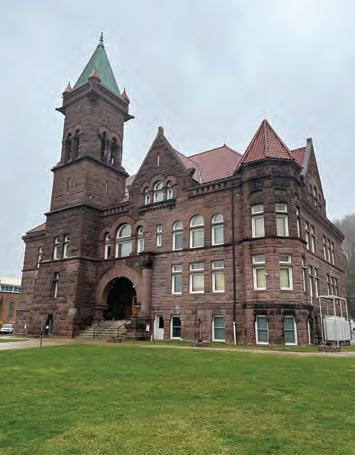
26 N. Main St., Philippi
A church that stood near the site of the courthouse served as a hospital, treating Confederate casualties, including James Hanger of the 14th Virginia Cavalry, whose leg was amputated. Unhappy with his uncomfortable false leg, Hanger patented a prosthetic in 1871 that incorporated a joint at the knee and a hinge at the ankle. He formed Hanger Orthopedics, which made some of the first practical artificial limbs and still produces prosthetics today.
Blue & Gray Reunion
On June 3, 1911, Barbour County held its first “Home Coming Week” of the “Blue and Gray Soldiers” who participated in the 1861 battle. The program included speeches, band concerts, “public talks by Old Soldiers,” entertainment, fireworks, parachute jumps, parades, a hot-air balloon ascension, and a “Sham Battle conducted by the State Militia.” In 1988, the City of Philippi published a “Call to Arms” to plan for an annual Blue & Gray Reunion to begin the first week of June 1989. It still runs today and includes a parade, encampments for reenactors from both sides of the war, artillery and small arms demonstrations, a choir concert, Civil War Ball, and living history demonstrations. www.blueandgrayreunion.org

SUMMER 2023 53 CLOCKWISE FROM LEFT: PHOTOS BY MELISSA A. WINN (3); COURTESY OF CRAZY CROW TRADING POST BACKYARD PRODUCTIONS/ALAMY STOCK PHOTO
TRAILSIDE
ACWP-230700-TRAILSIDE.indd 53 3/14/23 4:31 PM
Talbott’s Hill 101 College Hill Rd.

When Colonel Ebenezer Dumont arrived in Philippi during the early morning hours of June 3, 1861, he ordered Colonel James B. Steedman to post two six-pounder cannons here on Talbott’s Hill and then await the signal of a pistol shot to open fire once Kelley’s column was in position. This hillside view of Philippi is located on the campus of today’s Alderson Broaddus University.
Barbour County Historical Museum



The Chrislip on Main 167 S. Main St.
With few options in town for lodging, this Airbnb, operated out of a recently restored 1902 home in the heart of downtown, is an ideal overnight option. tinyurl.com/The-Chrislip-on-Main
 1. Blue & Gray Park
2 Covered Bridge
3. Barbour County Historical Museum
4. Barbour County Court House
5. Chrislip on Main
1. Blue & Gray Park
2 Covered Bridge
3. Barbour County Historical Museum
4. Barbour County Court House
5. Chrislip on Main
➍ ➊ ➎ ➋ ➏ ➌ 54 AMERICA’S CIVIL WAR TRAILSIDE PHOTOS BY MELISSA A. WINN (4)
6. Talbott’s Hill
13 Museum St.
ACWP-230700-TRAILSIDE.indd 54 3/15/23 11:08 AM
Housed in the old Philippi B&O Railroad station, this museum showcases the history and culture of Barbour County, W.Va., including its farming and mining history, the Philippi mummies, and Civil War artifacts from the Battle of Philippi and local veterans, including a drum played at Appomattox and the prosthetic leg invented by James E. Hanger, the first amputee of the Civil War. facebook.com/BarbourCountyMuseum


PHOTOS BY MELISSA A. WINN (4) ACWP-230700-TRAILSIDE.indd 55 3/14/23 4:32 PM
Humble Roots
It could be an American fairy tale. Once upon a time, a young boy who loved horses gained a West Point appointment and became the North’s most successful general, battered the Confederacy into submission and, more than any other person but Abraham Lincoln, saved the Union. Of course, the evolution of Ulysses S. Grant as a military leader is much more complex than that. In his latest book, America’s Hardscrabble General: Ulysses S. Grant From Farm Boy to Shiloh (SIU Press, 2023), Jack Hurst finds the roots of Grant’s success as a military strategist and leader of men deep in his hardscrabble years prior to the Civil War. The epitome of a mid-century common man, Grant became an uncommon general because his equestrian mastery also exemplified the bedrock of his greatness: his lack of fear. Win, lose, or draw, Grant learned from all his experiences and, like the men in his ranks, he just wanted to get the job done and go home.
1You say many biographers dismiss the influence of Grant’s earliest years’ experiences on his later military successes. Why do you think that is?

I think it’s natural if you’re writing about a soldier to look for obviously martial things in his background. But when you can’t find them, and you’re working on a man like Grant whose performance so clearly outshines those of his Civil War predecessors—who all graduated from West Point just as he did—I think by process of elimination you have to start looking past West Point to other aspects of his life.

2Define what you mean when you say you’ve written a biography of Grant’s military mindset rather than a biography of the man himself?
The book is obviously not a full biography of Grant—it doesn’t extend into his postwar period and actually not much past Shiloh, except for occasional forward flashes. And we don’t need another Grant biography; we already have several fairly recent first-rate ones by Jean Edward Smith, Ron Chernow, and other better historians than me. This is a biography of the development of the iron will and attitude that powered Grant’s greatest military triumphs, and that attitude appears to rise from myriad places, as the book’s subtitle—“From Farm Boy to Shiloh”—suggests: his farming youth before entering West Point, the Mexican War and the rest of his first Army stint, his hellish seven civilian years beginning in 1854, and finally the Civil War’s first year.
3You characterize Grant as a Clausewitzian rather than a Jominian. What do you mean by that?
In a word: aggressiveness. Unlike several Civil War generals who were better students at West Point, Grant did not believe wars are won by maneuvering to capture map points, the more bloodlessly the better. He believed they are won by destroying or capturing enemy armies, because an outmaneuvered but undefeated enemy army is still an army that can meet and beat you when you next meet it. Grant also, like Clausewitz, recognized that war is inextricably connected to civil society and its politics, whereas Jominians thought politics and war could and should be separate. What I meant was that Grant came to believe in all-out war if that’s
56 AMERICA’S CIVIL WAR 5 QUESTIONS TOP: NATIONAL PORTRAIT GALLERY, SMITHSONIAN INSTITUTION; LEFT: TONY LUNA
Interview by Gordon Berg
ACWP-230700-5Qs.indd 56 3/15/23 9:16 AM
His Baptism of Fire Grant, pictured here in 1847, fought with the 4th U.S. Infantry during the Mexican War.
what it took to finish the job, whereas Jomin ians thought in terms of limited conflict.
4
Empathy is a personality trait not usually considered an important attribute in a successful military officer, yet you list it as one of Grant’s. Why? Where did Grant’s come from?
I believe empathy was important to Grant’s military performance. I think it made him instantly able to feel from an opponent’s perspective and to understand the opponent’s point of view. It also made him better able to identify with, and better care for, his own troops. I think it was probably rooted in his mother’s devout religiosity, although her religion seems to have made her very distant from her son. His own religious views are hard to track, but the exposure to her devoutness seems to have resulted in many of his traits: he never cursed, felt a strong sense of duty, was a devoted nurse of sick and wounded soldiers (and, sometimes, civilians), and so believed in fairness that he refused to pull political strings to gain rank over peers.

5
You claim Grant’s lack of fear was the bedrock of his greatness. Explain. His aggressiveness was not put-on. On, or contemplating, the battlefield it was second nature. Lack of fear can be faked a time or two, but incessant aggressiveness requires boundless courage. That was on display both in his individual performances in combat, where someone in the Mexican War described him as so at home under fire that he seemed a man of fire, or in his handling of armies under fire. His thinking bristled with aggressiveness—not out of a desire to kill but, rather, to finish the awful job and go home. An example of his thinking is his contention that when two battling armies are exhausted, “the one who attacks first will win.” His idea of a combat general’s job all but drips with aggres siveness. “The art of war is simple,” he said. “Find out where your enemy is. Get at him as soon as you can. Strike him as hard as you can as often as you can, and keep moving on.” And “moving on” meant moving front, not toward the rear, win or lose. Fearless ness is the guts of that kind of philosophy.
To read our full interview with Jack Hurst, go to historynet.com/HardscrabbleGrant
THE LINCOLN FORUM
What began as a modest proposal to bring Lincoln enthusiasts together for a small East Coast-based yearly history conference at Gettysburg has blossomed into one of the leading history organizations in the country. Our yearly November symposium is attended by scholars and enthusiasts from all over the nation and abroad. It attracts speakers and panelists who are some of the most revered historians in the Lincoln and Civil War fields.
TOP: NATIONAL PORTRAIT GALLERY, SMITHSONIAN INSTITUTION; LEFT: TONY LUNA
Visit our website: thelincolnforum.org for more information JOIN TODAY!
CWTP-LINCOLN AD-nov21.indd 4 ACWP-230700-5Qs.indd 57 3/15/23 8:35 AM
Scourge on All Fronts
Antebellum America had a drinking problem. By the 1820s, whiskey cost less than beer, wine, coffee, tea, or milk, and a decade later, reports historian W.J. Rorabaugh, the per capita adult consumption averaged seven gallons a year. This was equivalent to 1.7 bottles of 80-proof liquor weekly. Given that millions elected not to imbibe, the amount consumed by those who did was considerably greater.
The American Temperance Union, organized in 1826, became the most popular reform movement of its day, with 12 percent of the nation’s adults claiming membership. By the outbreak of the Civil War, the movement had achieved considerable success. And yet, as Megan L. Bever describes in At War With King Alcohol, the issue of alcohol consumption proved a constant bugaboo for both Union and Confederate forces.
At the heart of Bever’s book is the disconnect between the belief that effective soldiering required abstinence and demonstrable proof that officers and enlisted men receiving regular rations of liquor were still effective fighters. The challenge was how best to control soldiers’ access to alcohol.
Congress had abolished the regular distribution of whiskey to troops in 1832, but by the 1860s physicians believed that the “intelligent allocation” of alcohol—as much as four ounces a day—was medically beneficial when combating wounds and disease and energizing the body.
At War With King Alcohol: Debating Drinking and Masculinity in the Civil War

 By Megan L. Bever UNC Press, 2022, $27.95
By Megan L. Bever UNC Press, 2022, $27.95
58 AMERICA’S CIVIL WAR REVIEWS
LIBRARY OF CONGRESS ACWP-230700-REVIEWS.indd 58 3/14/23 9:38 AM
Three Deadly Sins?
Union officers spend their downtime in camp playing cards and enjoying cigars and some wine. For soldiers on both sides during the war, it was a very familiar scene.
Military regulations, Bever argues, supported a degree of alcohol consumption at odds with middle-class civilian values. And the amount of recreational drinking signaled differences as to what was acceptable among middle class, working class, and rural soldiers. She further suggests that sobriety was firmly entrenched in notions of masculinity, while also positing that most soldiers accepted drinking as a logical response to their circumstances. Bever’s treatment of these topics is cursory and unconvincing, and detracts from an otherwise valuable study.
She is on much firmer ground when narrating the evolving policies toward alcohol by both the Union and Confederate armies. The responsibility for distributing alcohol generally resided with the army’s medical department, and commanding officers could authorize extra rations to combat exposure or fatigue. Those soldiers who chose not to drink received extra pay. Unlike enlisted men, junior officers could buy liquor from camp sutlers and generally, argues Bever, treated regular drinking as a privilege of rank.

As the war progressed, temperance reformers barraged the Union Army with tracts promoting abstinence, achieving more success among enlisted troops than officers. The challenges associated with drunkenness increasingly became ones of controlling access. Here the differences between Union and Confederate policies run contrary to expectations, for Rebel leaders proved far more willing to use governmental authority, in large measure to combat food shortages, to shut down civilian sellers and create centralized distilleries and dispensaries to limit the production of liquor for medicinal purposes. Their Northern counterparts relied instead on licensing and taxation.
In her epilogue, Bever notes that post-bellum temperance advocates met little success with the conflict’s veterans. It would take the passage of generations before Americans were willing to launch their ultimately failed experiment with prohibition. Rick Beard
Soldiers from Experience: The Forging of Sherman’s Fifteenth Army Corps, 1862-1863
 By Eric Michael Burke LSU Press, 2023, $50 hardcover
By Eric Michael Burke LSU Press, 2023, $50 hardcover
THE 15TH CORPS was organized in December 1862 in northern Mississippi, one of 25 Union infantry corps formed in the war. It fought in the Vicksburg and Atlanta campaigns, then marched with Sherman through Georgia and the Carolinas. Having earned an admirable record of service in these twoand-a-half years, it was mustered out in June 1865.
Eric Michael Burke, military historian at Fort Leavenworth, Kan., presents a sturdy account of the corps’ service in Soldiers From Experience. His study, though, focuses on the 15th’s first eight months in the field, as he traces its development of a “corps culture”—the set of attitudes and beliefs adopted and shared by the men during their times of trial. A key element of that culture—one of Burke’s main focuses—was the men’s aversion to bloody frontal attacks that usually failed.
This brings in William T. Sherman, who took command of the 15th Corps in the early winter of 1862-63. In late December 1862, as part of Grant’s operations against Vicksburg, Sherman had ordered an attack at Chickasaw Bluffs. It failed miserably, costing 1,776 casualties. Among the men this led to Sherman developing a reputation as “bloodhound” and “butcher.”
Burke emphasizes how the men of the 15th shifted from costly bayonet charges to open-order skirmish formations, in which the advancing troops used trees and rocks for cover. After taking their shock volley from the enemy, they went to ground and returned fire. Often the Confederate defenders would give up and retire when they realized the Yankees weren’t going to.
Even today, sectional biases appear in many Civil War books. The author repeatedly refers to Rebels (Confederate is not used once; the Confederacy is “so-called”). In Mississippi, the 15th Corps earned a reputation for liberal foraging. Civilians termed this looting, but to Burke it’s “extractive warfare” and “area denial.”
Through these eight months, December 1862–July 1863, Uncle Billy learned his lesson. “Sherman the Stormer” in Mississippi later became Sherman the Flanker in northern Georgia. The veterans of the 15th Corps appreciated their commander’s transition as Sherman, like his men, became a soldier from experience. —Stephen Davis
SUMMER 2023 59 REVIEWS
LIBRARY OF CONGRESS
ACWP-230700-REVIEWS.indd 59 3/14/23 9:38 AM
REVIEWS
Confederate efforts to build ships in Liverpool shipyards and Union endeavors to frustrate them comprise a complex tale of subterfuge, diplomatic maneuvering, and political wrangling. In The Lion and the Fox, Alexander Rose tells a tale deserving of cinematic treatment, as did his book Washington’s Spies: The Story of America’s First Spy Ring

Thomas Dudley and James Bulloch could not have been more different. A New Jersey Quaker, Dudley was a fervent abolitionist whose political support during the 1860 election led Lincoln to name him consul to Liverpool. Bulloch, son of a Georgia slaveowner and a respected ship’s captain, eagerly accepted the assignment to oversee the construction of ships for a Southern fleet.
By Alexander Rose HarperCollins
Bulloch arrived in Liverpool with a threestage plan to break the Union blockade and blunt the North’s maritime advantage. The creation of a fleet of speedy blockade runners to carry supplies to the Confederacy and return to England with needed cotton was to be the first step. Next was construction of commerce raiders to weaken the blockade by drawing Union ships away from Southern ports. That would be followed by construction of formidable ironclad warships.
Success at sea, Confederate leaders believed, would convince Britain and France that the CSA merited formal recognition. Bulloch hoped to finance his venture with cotton shipments for English mills but had to make alternative arrangements when an embargo was put in place.
Relying on a loophole in an 1819 law prohibiting the outfitting of the Confederate ships within British waters, Bulloch directed the commerce raiders to sail to the Bahamas and take on armaments and Confederate crews.
At first, Bulloch had the upper hand. British authorities had previously turned a blind eye toward construction of ships for the South, but paid closer to Bulloch’s efforts after release of the Preliminary Emancipation Proclamation in September 1862, which prevented him from taking ownership of the two ironclad warships that were to implement the third step of his plan.
The inability to get the ironclads released from the Liverpool shipyard and the failure of the Southern commerce raiders to break the blockade ultimately doomed Bulloch. Exempt from the federal government’s amnesty after the war, he remained in Liverpool and became a successful cotton merchant. In 1883, at the urging of his nephew Theodore Roosevelt, he published an account of his war endeavors, The Secret Service of the Confederate States in Europe.

Dudley remained at his consular post until 1872, during which time the U.S. claims against the British government for the damage done by the Confederate ships built in Liverpool were settled by the Treaty of Washington.
Rick Beard
IN THE LATE WINTER of 1862, many Northern leaders expected the Rebellion to collapse. Key Confederate forts in Tennessee had fallen; Southern coastal points were under attack; and in Virginia McClellan was amassing the largest army the continent had ever seen. Then, in the spring, Confederates struck back. Johnston attacked at Shiloh; Jackson marched in the Valley; and McClellan cowered on the Peninsula. Not to be overlooked was a small but dramatic Confederate victory at Secessionville, S.C., on June 16, 1862. Exuberant Southerners hailed it as “one of the decisive engagements of the war”—tall talk, of course, given the total combatants (6,600 U.S.; 2,000 C.S.) and casualties (693 U.S.; 204 C.S.).
Secessionville was a small town five miles southwest of Charleston. After their capture of Rebel forts near Port Royal, north of Savannah, in November 1861, Federals planned their move against Charleston. To hold them off, Southerners built a four-mile line to defend the city. Secessionville was at its southern end, protected by Fort Lamar, an earthwork with abatis and a half-dozen heavy guns. This was the point that Union Brig. Gen. Henry Benham decided to attack early on June 16. The Federals’ charge first succeeded; they surged into the fort, but Rebel reinforcements arrived. Southern artillerymen fired all their ammo, then turned to chains, scrap iron, horseshoes. “They’re firing a whole blacksmith shop at us,” cried one Yank. Scarcely an hour after the battle had begun, a retreat was ordered.
Secessionville was “a small fight and quickly forgotten,” though Morgan conjectures a Union victory might have led to the fall of Charleston. Forgotten, too, are the opposing commanders: Benham lost his brigadier’s commission; Lamar died of malaria a few months after the battle. —Stephen
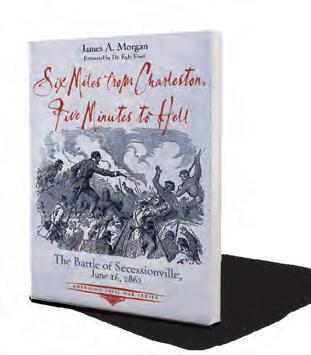 Davis
Davis
Six Miles from Charleston, Five Miles to Hell: The Battle of Secessionville, June 16, 1862
By James A. Morgan Savas Beatie, 2022, $16.95 paperback
60 AMERICA’S CIVIL WAR
The Lion and the Fox: Two Rival Spies and the Secret Plot to Build a Confederate Navy
ACWP-230700-REVIEWS.indd 60 3/14/23 9:38 AM
Books, 2022, $28.99
UNIT HISTORIES
CONFEDERATE MILITARY authorities created the 9th Virginia Cavalry in early 1862, with former (and future) U.S. congressman Richard L.T. Beale as its major and third-in-command. After William H.F. “Rooney” Lee assumed command, the regiment attracted renown for its role in J.E.B. Stuart’s celebrated June 1862 ride around the Army of the Potomac. Lee’s men earned further laurels in supporting Stonewall Jackson during the Seven Days; captured John Pope’s coat and dispatch book at Catlett’s Station; covered the Confederate retreat from South Mountain; and battled their Federal counterparts during the Union advance across the Potomac River into Virginia in the fall of 1862.
Burnside’s Boys: The Union’s Ninth Corps and the Civil War in the East
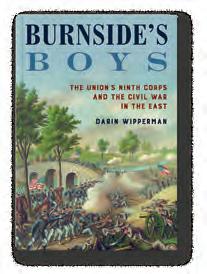 By Darin Wipperman Stackpole Books, 2023, $34.95
By Darin Wipperman Stackpole Books, 2023, $34.95

History of the Ninth Virginia Cavalry in the War Between the States
 By R.L.T. Beale
B.R Johnson Publishing, 1899
By R.L.T. Beale
B.R Johnson Publishing, 1899
Upon Lee’s promotion to brigadier general in September 1862, Beale was named commander, and under his direction the regiment spent the winter of 1862-63 supporting the Army of Northern Virginia’s efforts at Fredericksburg and monitoring Union movements along the Rappahannock line and in the Virginia Tidewater. Following the Chancellorsville Campaign, Beale and his men had an important role in the early stages of the Gettysburg Campaign and in the cavalry fight at the Rummel Farm on July 3, 1863. In 1864, the 9th Virginia was responsible for the death of Union raider Ulric Dahlgren at Walkerton and supported the Army of Northern Virginia’s efforts to stave off defeat as it was forced back from the Rapidan to Petersburg.
Although Beale left the 9th to accept promotion to brigade command in late 1864, his attachment to the regiment was evident in the alacrity with which he prepared a history of its service after the war. It was not until after Beale’s death in April 1893, more than 25 years after he wrote it, that his son found the manuscript among his papers. Six years later, History of the Ninth Virginia Cavalry appeared in print and demonstrated that, in addition to being an accomplished soldier whose pride in his unit and belief in the rectitude of the Southern cause were undimmed by defeat, Beale was skilled with a pen. His accounts of operations, while by no means infallible, are not only wonderfully detailed, but readable and quotable, which is why this has long been considered an important source—and been an oft-cited one—for students and enthusiasts of cavalry operations in the Eastern Theater. —Ethan S. Rafuse

After campaigning successfully along the North Carolina coast from February to July 1862, Brig. Gen. Ambrose E. Burnside and seven regiments comprising 7,000 soldiers were reinforced and reorganized in Virginia on July 22 as the Union Army’s 9th Corps. Thereafter, the 9th would serve in some of the bloodiest encounters fought by the Army of the Potomac, including Antietam, Fredericksburg, the Overland Campaign, the Crater, and the final assault on Petersburg. In between its Eastern Theater activities, “Burnside’s Boys” were transferred to the Army of the Ohio in the Western Theater, serving from March 1863 to March 1864 and earning Ulysses Grant’s respect for its participation in the taking of Jackson and Vicksburg and securing Knoxville. By war’s end, the corps had traveled more than any other such formation in what one of its troops retrospectively called Burnside’s “peripatetic geography class.”
Most Civil War unit histories are devoted to regiments, but in Burnside’s Boys, Darin Wipperman draws heavily on firsthand accounts from a wide variety of the units that made up the 9th Corps, providing contemporary perspectives on such notorious events as the storming of Burnside Bridge at Antietam, Fredericksburg, the Mud March, and the Crater, as well as such overlooked successes as New Bern, N.C., and the defense of Knoxville’s Fort Sanders (ironically, in the latter case he was facing an old enemy, Lt. Gen. James Longstreet’s First Corps).
It is somewhat regrettable Wipperman puts so much emphasis on the East, as the muchmaligned Burnside did much to redeem himself in the West, even if Grant would write “he was not....fitted to command an army. No one knew this better than himself.” William Lusk of the 79th New York had a similar estimation: “If Burnside was not a Napoleon, he was a first-rate soldier, and in a subordinate position can do splendid service to the country.” As is made clear here, a great many of the corps’ men likewise did splendid service to the country. Jon Guttman
SUMMER 2023 61
REVIEWS
ACWP-230700-REVIEWS.indd 61 3/14/23 4:52 PM
No Place for a Woman: Harriet Dame’s Civil War
 By Mike Pride
By Mike Pride
There is probably no better look at the contributions of women to the Union war effort, both on and off the battlefield, than the 1867 book Woman’s Work in the Civil War. Notably missing from its 700-plus pages, however, is the story of Harriet Patience Dame of Concord, N.H., who was praised by one contemporary of “doing more labor and encountering more hardship than any one person could endure.”
It may have taken another 156 years, but historian Mike Pride has finally given Dame the recognition she deserves beyond the Granite State. A former editor of Concord’s Monitor newspaper, Pride rekindles and expands Dame’s story of sacrifice and devotion during the war. Pride “armed” himself with a small trove of Dame’s recently discovered correspondence to construct his account, and then built on that by combing other resources. “I found much more than expected,” he says.
Pride blends Dame’s slender recollections “with those of the soldiers she befriended and helped.” The author also drew heavily from accounts of medical personnel, government officials, and colleagues who witnessed “Dame in action.” He claims “only by understanding their ordeals, defeats, and triumphs is it possible to comprehend hers.”
“This is not a big book, and certainly not the one Dame might have written,” Pride admits, “but it is one I have longed to write for years.”
Dame was quick to take action when the war began. She first “found plenty of work among the sick” from nearby recruiting camps. “[M]y house was at once a hospital,” she recalled. Dame soon determined to aid soldiers at the front. By surmounting numerous official obstacles Dame joined the 2nd New Hampshire Infantry as a matron. “Her decision to set out for untold dangers with a large group of young men,” Pride writes, “fell far outside the social norms of the day.” She was, after all, “old enough to be the mother of most of them.”
Aside from nursing soldiers in camp, Harriet “sewed, cooked, counseled the men, and raised money on their behalf.” She often insisted on tending the wounded as near to the battlefield as she could go. She was often within range of enemy guns. Meanwhile Dame, and female nurses in general “endured the harsh prejudices of most of the male surgeons with whom they worked.”
In early July 1861, Dame arrived with the 2nd New Hampshire at
Camp Sullivan overlooking Washington, D.C.. Prevented from following Union forces to Manassas, Va., she agonized as cannon fire echoed from the battlefield of First Bull Run. “Here I am thirty miles from there doing nothing…” she fretted, resolving “never to be left behind again.”
Dame reached the front during McClellan’s Peninsula Campaign. In the wake of fighting at Fair Oaks she walked the grounds amid shallow graves and dead horses. “She accidentally kicked an arm,” Pride writes, “lifting it from the face of a dead soldier.” During the Union retreat to Harrison’s Landing, Dame was briefly captured and questioned by Confederate pickets but managed to elude them in the chaos of the moment. On the heels of the Second Battle of Bull Run she was captured again, and paroled.
Dame’s intense field work continued through the Gettysburg and Overland campaigns, where she recalled ministering the wounded “until my clothes and arms were covered with blood.” Beyond the front lines, she served as an agent for the New Hampshire Soldier’s Aid Association, her duties covering sites in Washington and along the Eastern Seaboard.
She was rarely idle, perhaps her only break from action coming shortly after Gettysburg, when she returned home for several days after her brother died.
Dame’s postwar years were equally full. Over age 50 when she accepted a clerkship in the Treasury Department, she was employed there for nearly 30 years. From her Washington home she involved herself in New Hampshire veterans’ activities and traveled to their reunions. She also became a vocal leader in the fight for pensions for Army nurses. In ill health, Dame eventually returned to Concord, living in a rest home until her death in April 1900. She received a full military funeral. Her grave in Blossom Hill Cemetery, in fact, has a granite headstone crowned with the 3rd Corps’ distinctive diamond-shaped emblem.
No Place for a Woman is a worthy account of Dame’s dedicated lifetime, complete with five good maps and numerous photographs and illustrations. George Skoch
62 AMERICA’S CIVIL WAR REVIEWS
Kent State University Press, 2022, $40
ACWP-230700-REVIEWS.indd 62 3/14/23 9:38 AM
Dame was briefly captured by Rebel pickets in June 1862, managing to elude them in the chaos of the moment.
examination of the “Lee’s Lost Orders” debate that finally puts McClellan’s actions in proper context.













A conversational approach to interpreting history! Listen as hosts Patrick and Matt connect you with your favorite stories from the past— as well as ones you may have never heard! Download or listen for FREE @TheHistoryThingsPodcast CHECK OUT EDITOR IN CHIEF DANA SHOAF’S EPISODES ON GEN. ERASTUS TYLER AND AN 1861 MURDER IN MARYLAND! THE MAPS OF SPOTSYLVANIA THROUGH COLD HARBOR An Atlas of the Fighting at Spotsylvania Court House Through Cold Harbor by Bradley M. Gottfried Provides a deep, tactical understanding of the actions within each battle and the overall campaign. can’t- miss books Visit savAsbeatie.com to order toDAY! “THE BULLETS FLEW LIKE HAIL” Cutler’s Brigade at Gettysburg From McPherson’s Ridge to Culp’s Hill by James McLean Jr. This completely revised and updated edition is even better than its predecessor, already one of the best unit studies ever published. GETTYSBURG IN COLOR Volume 1: Brandy Station to the Peach Orchard
Patrick Brennan
Dylan Brennan “Gettysburg in Color” allows readers to revisit well-known images from dramatically different perspectives, summoning a sense of immediacy that is quite striking. “IF WE ARE STRIKING FOR PENNSYLVANIA” The Army of Northern
Mingus
A
5 ACWP-230700-REVIEWS.indd 63 3/14/23 9:39 AM
by
and
Virginia and the Army of the Potomac March to Gettysburg by Scott L. Mingus Sr. and Eric J. Wittenberg
and Wittenberg deliver fresh perspectives even the most seasoned students of this great battle will appreciate. THE TALE UNTWISTED General George B. McClellan, the Maryland Campaign, and the Discovery of Lee’s Lost Orders by Gene M. Thorp and Alexander B. Rossino
well-documented
John Wesley Horner
The Rev. George W. Pye waited in Dr. Abram H. Knapp’s office for a hospital attendant to retrieve his friend, Colonel John Wesley Horner. Pye was dismayed by Horner’s appearance. Before him stood a pale man with a restless stare, a once-proud veteran who anxiously rubbed his hands together and pulled at his facial hair. When Pye tried to talk to Horner, the colonel motioned that he was too feeble to talk and only answered in what the minister described as “indistinct monosyllables.”
“The colonel is a shadow of himself,” Pye recalled after the distressing visit. “[S]uch a look lingers with me yet.” He never visited his friend at the Kansas State Insane Asylum again, and when Horner died three months later, he was buried unceremoniously alongside the sanctuary’s other deceased patients.
A teacher before the Civil War, Horner was appointed a first lieutenant in the 90-day 1st Michigan Infantr y in May 1861 and fought at the First Battle of Bull Run on July 21. After the Union defeat, he was mustered out, but was then appointed a captain in the 18th Michigan Infantry in August 1862. By March 1865, Horner was the regiment’s colonel and had served in various administrative posts, such as the provost marshal in Nashville, Tenn., and in the District of Northern Alabama. He ended the war as the commander of the U.S. post at Huntsville, Ala.

Relocating to Kansas, Horner resumed his teaching and writing career. He became president of Baker University in Baldwin City, Kan., and a professor of mental and moral philosophy at Kansas State
University in Manhattan. Horner also served as the superintendent of Chetopa’s schools and started the Chetopa Advance newspaper. The Manhattan Beacon called him “one of the foremost educators in this portion of the State, an eloquent speaker and a brilliant essayist.”
In November 1873, however, Horner’s wife, Abigail, was stricken by an unknown brain disease, dying only two days after she had been diagnosed. A few weeks later, Horner suffered a mental breakdown and even attempted suicide several times. On December 29, he was admitted to the Kansas State Insane Asylum in Osawatomie. Abigail’s sister, Caroline Stocum, stepped in to care for his two young daughters, Catherine and Alice.
Horner finally passed on August 16, 1874, just 40. “His insanity and subsequent death are not only a great and irreparable loss to our country” reported the Chepota Advance. “It is a calamity to our State.”
Although Horner’s friends in Chetopa sent a telegraph to the Kansas State Insane Asylum requesting his remains be shipped home on the first available train—and also scheduling a funeral for the day the body would arrive—the missive apparently never reached the asylum and he was interred on the hospital’s grounds. At the time, patients who died were buried with only their patient number carved on a simple marker, no names. Shrouded Veterans recently placed a Civil War veteran headstone inscribed with Horner’s name and military service at the hospital’s cemetery. –Frank Jastrzembski

64 AMERICA’S CIVIL WAR FINAL BIVOUAC Final Bivouac is published in partnership with “Shrouded Veterans,” a nonprofit
by
Jastrzembski
or repair
Mexican War and Civil War
(facebook.com/shroudedvetgraves). COURTESY OF KANSAS HISTORICAL SOCIETY; COURTESY OF FRANK JASTRZEMBSKI
mission run
Frank
to identify
the graves of
veterans
COLONEL
Distinct Service
ACWP-230700-BIVOUAC.indd 64 3/14/23 8:57 AM
Horner ended the war as colonel of the 18th Michigan. His first regiment, the three-month 1st Michigan, fought with honor in the defeat at First Bull Run.

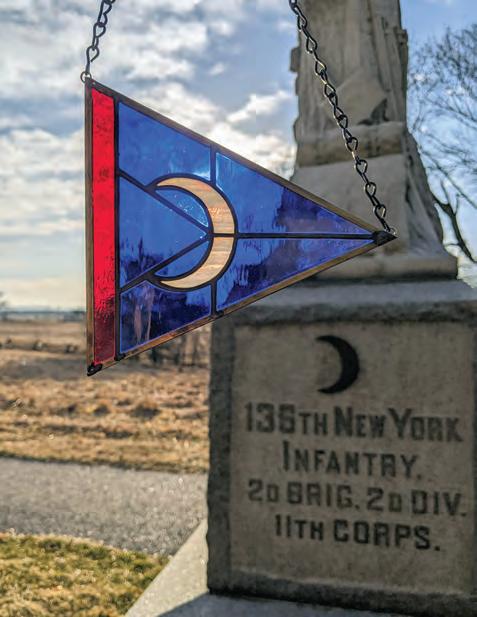




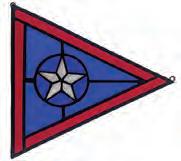



SHOW YOUR COLORS! Commemorate your ancestor’s service with custom-made Corps, Brigade, and Division flags in stained glass! Handcrafted in Gettysburg, Pa., by stained glass artist Jessie Wheedleton. She specializes in the flags of the Army of the Potomac and military insignia — custom orders welcome! capturedcolorsglass@yahoo.com / capturedcolorsglass GREAT GIFTS FOR ANY OCCASION • BIRTHDAYS GRADUATIONS • FATHER’S DAY • HOLIDAYS Sickles' Brigade Greene's Brigade Day's Regular Brigade Irish Brigade Philadelphia Brigade CAPTURED COLORS GLASS with CAPTUREDCOLORS-AD.indd 1 1/9/23 5:54 PM
STUNNING COLLECTION OF HISTORIC WWII MONEY & STAMPS!
This Historic World War II Coin, Note and Stamp Collection Can Be Yours!

is is an extensive 23-Pc. Collection of superb World War II memorabilia, spanning the United States, the Paci c and Europe. Each piece was issued by or for their respective nation during the World War II era, and this is the rst time ever that we’ve seen them assembled in one great set. is collection includes: U.S. and Foreign Coins—including U.S. “emergency” coins struck in uncommon metals to help with the war e ort, including a silver U.S. War Nickel, a steel 1943 Cent, and a Cent struck from copper recycled from shell cases—along with German “propaganda” coins featuring the Nazi swastika, and an Italian Lira displaying symbols of its own fascist regime; plus coins from Canada and Great Britain, two of our closest allies.
Japanese Invasion Notes—including Japanese guerilla and invasion notes printed for the Philippines and Burma which were controlled by Japan during the war, all in uncirculated condition.

U.S., Japanese and German Nazi Stamps—patriotic U.S. stamps—like the 3¢ Win the War stamp, occupational Japanese stamps and Nazi stamps are all here!

These Remarkable WWII Collection Are Going Fast—HURRY!
is incredible collection of World War II Memorabilia of authentic coins, notes and stamps, beautifully housed in a custom-designed album, will amplify any World War II collection perfectly—and what a wonderful, unique, muchappreciated gi !
GovMint.com
















• 1300 Corporate Center Curve, Dept. HCC126-01, Eagan, MN 55121













U.S. and Foreign Coins

U.S. 1943 Lincoln Steel Cent
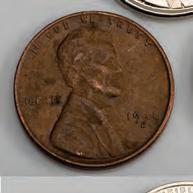

U.S. 1942-45 Jefferson Silver Nickel


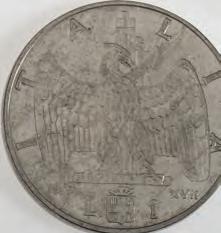
U.S. 1944-45 Lincoln Shell Case Cent
Germany 1939-45 Reichspfennig
Great Britain 1939-45 Half Penny

Canada 1944-45 “V” Five Cents

Italy 1939-43 Lira
Historic Japanese Guerilla and Invasion Notes


Philippines 1943 1 Peso Japanese Invasion Note
Philippines 1943 5 Peso Japanese Invasion Note




Philippines 1942-44 25 Centavos Guerilla Note

Burma 1942 1 Rupee Japanese Invasion Note

Burma 1942 5 Rupees Japanese Invasion Note
Burma 1942-44 10 Rupees Japanese Invasion Note


Burma 1944 100 Rupees Japanese Invasion Note
Patriotic and Significant U.S. and Foreign Stamps

U.S. 1940 2¢ National Defense Stamp
U.S. 1943 2¢ Allied Nations Stamp
U.S. 1942 3¢ Win the War Stamp
U.S. 1946 3¢ WW II Veterans Stamp
U.S. 1946 3¢ Iwo Jima Stamp

Germany 1941-44 12 Pfenning Hitler Head Stamp
Germany 1941-44 25 Pfenning Hitler Head Stamp
Philippines 1942-44 2 Centavos Japanese Occupation Stamp





Philippines 1942-44 5 Centavos Japanese Occupation Stamp
Don’t wait—to get your hands on this amazing collection you need to immediately call the toll-free number below. Supplies are limited and you don’t want to miss out!
World War II 23-Pc. Historic Coin, Note and Stamp Collection $59.95 + $9.95 s/h


SPECIAL CALL-IN ONLY OFFER
$49.95 + $4.95 limited time shipping/handling
FREE SHIPPING on 3 or More!
Limited time only. Product total over $149 before taxes (if any). Standard domestic shipping only. Not valid on previous purchases. Call now toll-free for fastest service
1-800-517-6468
Offer Code HCC126-01
Please mention this code when you call.












SPECIAL CALL-IN ONLY OFFER
GovMint.com® is a retail distributor of coin and currency issues and is not a liated with the U.S. government. e collectible coin market is unregulated, highly speculative and involves risk. GovMint.com reserves the right to decline to consummate any sale, within its discretion, including due to pricing errors. Prices, facts, gures and populations deemed accurate as of the date of publication but may change signi cantly over time. All purchases are expressly conditioned upon your acceptance of GovMint.com’s Terms and Conditions (www. govmint.com/terms-conditions or call 1-800-721-0320); to decline, return your purchase pursuant to GovMint.com’s Return Policy. © 2023 GovMint.com. All rights reserved.
A+
ACWP-230418-005 GovMint 1982 George Washington Half Dollar.indd 1 3/13/23 2:56 PM
23-Pc. Collection! SAVE $15 or more!

















































































































 By Richard H. Holloway
By Richard H. Holloway


 By Adolfo Ovies
By Adolfo Ovies
























 Albert R. LaBure
Albert R. LaBure













































 By Adolfo Ovies
By Adolfo Ovies























 —Edward Windsor
—Edward Windsor
 —Bruce Allardice
—Bruce Allardice






 H. Holloway
H. Holloway







 Grear
Grear

















 1. Blue & Gray Park
2 Covered Bridge
3. Barbour County Historical Museum
4. Barbour County Court House
5. Chrislip on Main
1. Blue & Gray Park
2 Covered Bridge
3. Barbour County Historical Museum
4. Barbour County Court House
5. Chrislip on Main






 By Megan L. Bever UNC Press, 2022, $27.95
By Megan L. Bever UNC Press, 2022, $27.95

 By Eric Michael Burke LSU Press, 2023, $50 hardcover
By Eric Michael Burke LSU Press, 2023, $50 hardcover


 Davis
Davis
 By Darin Wipperman Stackpole Books, 2023, $34.95
By Darin Wipperman Stackpole Books, 2023, $34.95

 By R.L.T. Beale
B.R Johnson Publishing, 1899
By R.L.T. Beale
B.R Johnson Publishing, 1899

 By Mike Pride
By Mike Pride






























































